Shows
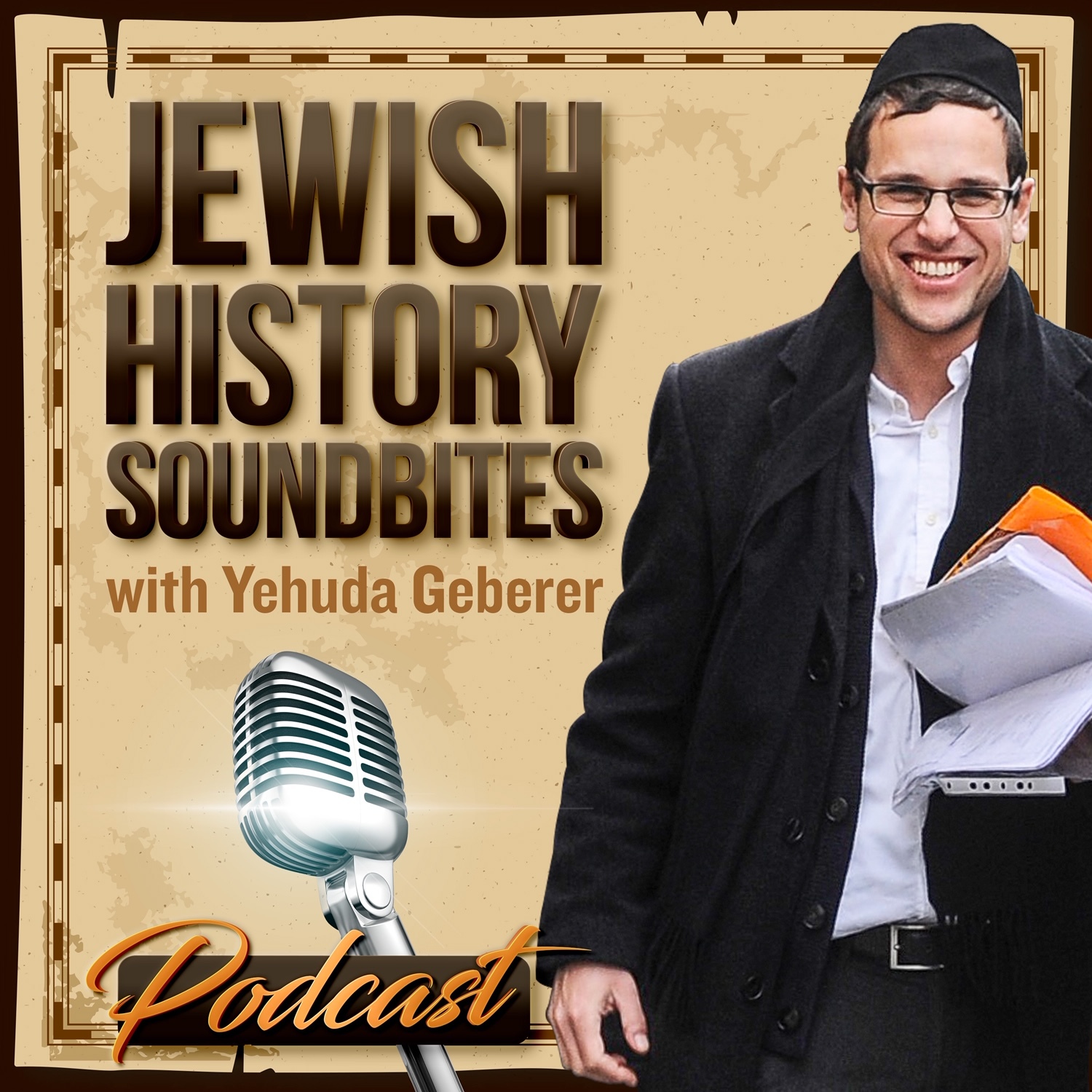 Jewish History SoundbitesThe Holocaust Research of Professor Yehuda BauerThe field of Holocaust research has been enriched over the decades in both its scope and depth by generations of historians and researchers worldwide. For more than 60 years one of the premier scholars in this field was Professor Yehuda Bauer, whose groundbreaking research covering a wide array of aspects of the Holocaust, genocide and antisemitism transformed the field and had a decisive impact on Holocaust historiography. Among the many diverse topics which he contributed towards were Jewish resistance during the Holocaust, rescue activities of Jewish groups under Nazi occupation and American Jewish organizations such as the Joint Distribution Committee...2024-11-0248 min
Jewish History SoundbitesThe Holocaust Research of Professor Yehuda BauerThe field of Holocaust research has been enriched over the decades in both its scope and depth by generations of historians and researchers worldwide. For more than 60 years one of the premier scholars in this field was Professor Yehuda Bauer, whose groundbreaking research covering a wide array of aspects of the Holocaust, genocide and antisemitism transformed the field and had a decisive impact on Holocaust historiography. Among the many diverse topics which he contributed towards were Jewish resistance during the Holocaust, rescue activities of Jewish groups under Nazi occupation and American Jewish organizations such as the Joint Distribution Committee...2024-11-0248 min Jewish History SoundbitesThe Jews of Sighet Part IIThe Jewish history of Sighet is almost synonymous with its long line of rabbis from the Teitelbaum family. This rabbinic and chassidic dynasty dominated Orthodox life of Sighet for nearly a century prior to the community’s destruction in the Holocaust.
It began with the son of the Yismach Moshe, Rav Eliezer Nisson Teitelbaum, and was later continued with his son Rav Yekusiel Yehuda, the famed Yetev Lev of Sighet who established the Sighet chassidic dynasty as well as founding and heading a prominent yeshiva in town. He in turn was succeeded by his son the Kedushas Yom...2023-08-2035 min
Jewish History SoundbitesThe Jews of Sighet Part IIThe Jewish history of Sighet is almost synonymous with its long line of rabbis from the Teitelbaum family. This rabbinic and chassidic dynasty dominated Orthodox life of Sighet for nearly a century prior to the community’s destruction in the Holocaust.
It began with the son of the Yismach Moshe, Rav Eliezer Nisson Teitelbaum, and was later continued with his son Rav Yekusiel Yehuda, the famed Yetev Lev of Sighet who established the Sighet chassidic dynasty as well as founding and heading a prominent yeshiva in town. He in turn was succeeded by his son the Kedushas Yom...2023-08-2035 min Jewish History SoundbitesThe Jews of Sighet Part IThough only settled in the 18th century and flourishing in the 19th, the town of Sighet made its mark on Jewish history and its legacy accompanies Jewish life until this very day. Nestled in the Maramaros district in Transylvania, it was sometimes in Romania, other times in Hungary and for a long time in the Austro-Hungarian Empire.
By the end of the 19th century, its sizable Jewish population was one of the largest in Transylvania and also one of the few which was largely Orthodox. In the century before the war, Sighet was home to some prominent h...2023-08-1733 min
Jewish History SoundbitesThe Jews of Sighet Part IThough only settled in the 18th century and flourishing in the 19th, the town of Sighet made its mark on Jewish history and its legacy accompanies Jewish life until this very day. Nestled in the Maramaros district in Transylvania, it was sometimes in Romania, other times in Hungary and for a long time in the Austro-Hungarian Empire.
By the end of the 19th century, its sizable Jewish population was one of the largest in Transylvania and also one of the few which was largely Orthodox. In the century before the war, Sighet was home to some prominent h...2023-08-1733 min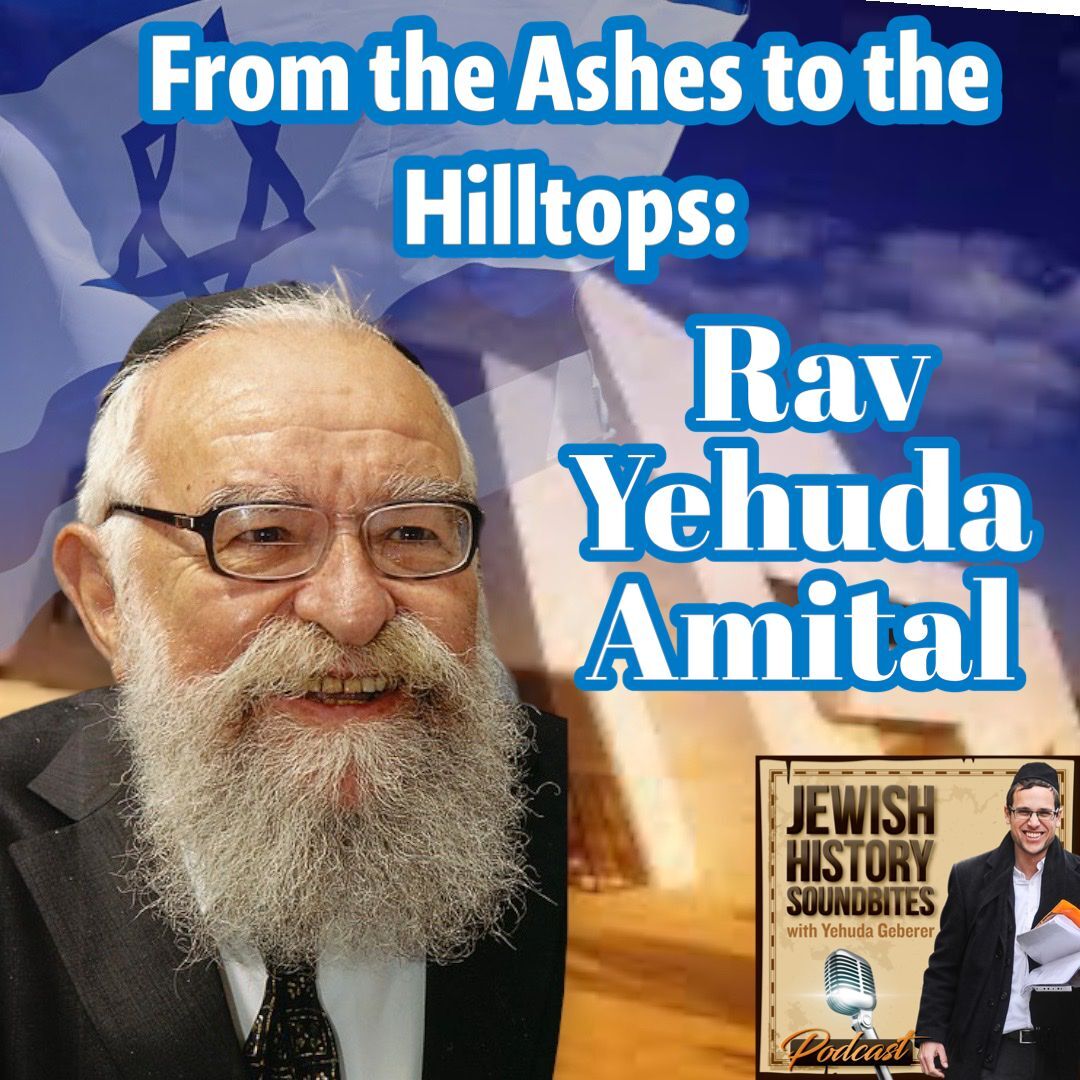 Jewish History SoundbitesFrom the Ashes to the Hilltops: Rav Yehuda AmitalRav Yehuda Amital (1924-2010) was a unique leader and builder of Torah of the 20th century. Born in Grosswardein, he survived the Holocaust and immigrated to the Land of Israel where he studied in the Chevron Yeshiva. While teaching at his father in law Rav Tzvi Yehuda Melter’s yeshiva in Rechovot he formulated the idea of the Hesder Yeshiva, through which the yeshiva students served in the military along with their yeshiva studies. Following the Six Day War he was hired to head the new Yeshivat Har Etzion in Gush Etzion. He remained at its helm for more th...2023-07-1441 min
Jewish History SoundbitesFrom the Ashes to the Hilltops: Rav Yehuda AmitalRav Yehuda Amital (1924-2010) was a unique leader and builder of Torah of the 20th century. Born in Grosswardein, he survived the Holocaust and immigrated to the Land of Israel where he studied in the Chevron Yeshiva. While teaching at his father in law Rav Tzvi Yehuda Melter’s yeshiva in Rechovot he formulated the idea of the Hesder Yeshiva, through which the yeshiva students served in the military along with their yeshiva studies. Following the Six Day War he was hired to head the new Yeshivat Har Etzion in Gush Etzion. He remained at its helm for more th...2023-07-1441 min Jewish History SoundbitesAleksander the Great Chassidic DynastyBased in the Lodz suburb of Aleksandrow, the Aleksander chassidic dynasty was one of the largest and most prominent in prewar Poland. Established as a branch of Vorka-Peshischa in the mid 19th century, it grew under the dynamic leadership of successive generations of the Danziger family at its helm. The Bais Yisrael Yeshiva network contributed to its growth in the early 20th century. Aleksander gained further renown during its 30 year dispute with its arch rival - the Ger chassidic community based near Warsaw. Although Aleksander attempted to remain apolitical, they did nominally join Agudas Yisrael towards the end of...2023-01-0239 min
Jewish History SoundbitesAleksander the Great Chassidic DynastyBased in the Lodz suburb of Aleksandrow, the Aleksander chassidic dynasty was one of the largest and most prominent in prewar Poland. Established as a branch of Vorka-Peshischa in the mid 19th century, it grew under the dynamic leadership of successive generations of the Danziger family at its helm. The Bais Yisrael Yeshiva network contributed to its growth in the early 20th century. Aleksander gained further renown during its 30 year dispute with its arch rival - the Ger chassidic community based near Warsaw. Although Aleksander attempted to remain apolitical, they did nominally join Agudas Yisrael towards the end of...2023-01-0239 min Jewish History SoundbitesOn the Cusp of Modernity: The Noda B’yehudaThe Jewish world of the 18th century was at the nexus of internal and external transformative events which would lead into the modern era. Political changes included the effects of the Seven Years War in central Europe and the partitions of Poland to the east. Internal Jewish disputes such as the Get of Kleves and the Rav Emden Rav Eybeschutz controversy, were accompanied by the challenges presented by the remnants of the Sabbatean movement, the spread of the nascent Chassidic movement and the early Haskala.
With a leadership career spanning the majority of this tempestuous century, Rav...2022-09-0434 min
Jewish History SoundbitesOn the Cusp of Modernity: The Noda B’yehudaThe Jewish world of the 18th century was at the nexus of internal and external transformative events which would lead into the modern era. Political changes included the effects of the Seven Years War in central Europe and the partitions of Poland to the east. Internal Jewish disputes such as the Get of Kleves and the Rav Emden Rav Eybeschutz controversy, were accompanied by the challenges presented by the remnants of the Sabbatean movement, the spread of the nascent Chassidic movement and the early Haskala.
With a leadership career spanning the majority of this tempestuous century, Rav...2022-09-0434 min Jewish History SoundbitesThe Working Group & its Desperate Rescue AttemptsThe Slovakian Working Group was likely the most heroic attempt at Jewish rescue during the Holocaust. Dealing directly with the SS and their Slovak collaborators, members of the Working Group bribed the perpetrators, smuggled goods and Jews across borders and disseminated information regarding the development of the Final Solution to Switzerland and Hungary.
Representing the full gamut of Slovakian Jewry, the Working Group included Gisi Fleischmann of the Zionist movement who was also a representative of the Joint Distribution Committee, Rav Michoel Ber Weissmandel who represented the Orthodox community, the Zionist leader Dr. Oskar Neumann, the Neolog...2022-08-051h 05
Jewish History SoundbitesThe Working Group & its Desperate Rescue AttemptsThe Slovakian Working Group was likely the most heroic attempt at Jewish rescue during the Holocaust. Dealing directly with the SS and their Slovak collaborators, members of the Working Group bribed the perpetrators, smuggled goods and Jews across borders and disseminated information regarding the development of the Final Solution to Switzerland and Hungary.
Representing the full gamut of Slovakian Jewry, the Working Group included Gisi Fleischmann of the Zionist movement who was also a representative of the Joint Distribution Committee, Rav Michoel Ber Weissmandel who represented the Orthodox community, the Zionist leader Dr. Oskar Neumann, the Neolog...2022-08-051h 05 Jewish History SoundbitesFrom Young Rosh Yeshiva to Senior Sage: Rav Isser Zalman Meltzer Part IIRav Isser Zalman Meltzer (1870-1953) was a great Torah leader of the 20th century, whose life story spanned eras and continents. As a young teenager he studied in the vaunted Volozhin Yeshiva, then married into the prestigious Frank family of Kovno, where he subsequently was appointed rosh yeshiva of Slabodka. This was followed by his departure for Slutzk where he remained as rosh yeshiva and later as communal rabbi for decades.
Following the formation of the Soviet Union and the challenges of maintaining religious life therein, he immigrated to Palestine in 1925. There he assumed the leadership of...2022-07-2839 min
Jewish History SoundbitesFrom Young Rosh Yeshiva to Senior Sage: Rav Isser Zalman Meltzer Part IIRav Isser Zalman Meltzer (1870-1953) was a great Torah leader of the 20th century, whose life story spanned eras and continents. As a young teenager he studied in the vaunted Volozhin Yeshiva, then married into the prestigious Frank family of Kovno, where he subsequently was appointed rosh yeshiva of Slabodka. This was followed by his departure for Slutzk where he remained as rosh yeshiva and later as communal rabbi for decades.
Following the formation of the Soviet Union and the challenges of maintaining religious life therein, he immigrated to Palestine in 1925. There he assumed the leadership of...2022-07-2839 min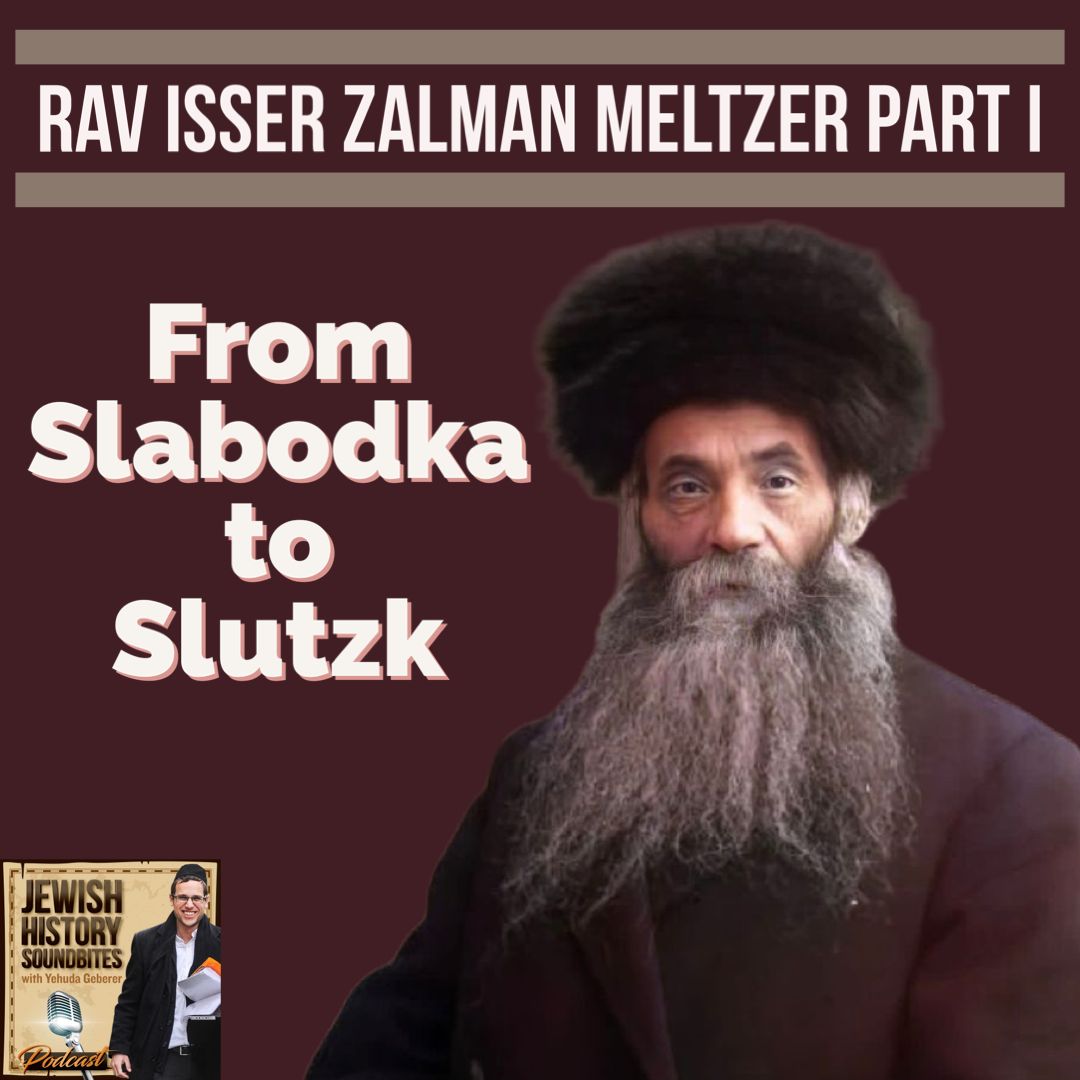 Jewish History SoundbitesFrom Slabodka to Slutzk: Rav Isser Zalman Meltzer Part IRav Isser Zalman Meltzer (1870-1953) was a great Torah leader of the 20th century, whose life story spanned eras and continents. As a young teenager he studied in the vaunted Volozhin Yeshiva, then married into the prestigious Frank family of Kovno, where he subsequently was appointed rosh yeshiva of Slabodka. This was followed by his departure for Slutzk where he remained as rosh yeshiva and later as communal rabbi for decades.
Following the formation of the Soviet Union and the challenges of maintaining religious life therein, he immigrated to Palestine in 1925. There he assumed the leadership of...2022-07-2535 min
Jewish History SoundbitesFrom Slabodka to Slutzk: Rav Isser Zalman Meltzer Part IRav Isser Zalman Meltzer (1870-1953) was a great Torah leader of the 20th century, whose life story spanned eras and continents. As a young teenager he studied in the vaunted Volozhin Yeshiva, then married into the prestigious Frank family of Kovno, where he subsequently was appointed rosh yeshiva of Slabodka. This was followed by his departure for Slutzk where he remained as rosh yeshiva and later as communal rabbi for decades.
Following the formation of the Soviet Union and the challenges of maintaining religious life therein, he immigrated to Palestine in 1925. There he assumed the leadership of...2022-07-2535 min Jewish History SoundbitesJewish Saviors of the Holocaust Part III: The Sobibor RevoltWithin the framework of Operation Reinhard, the Nazi extermination of Polish Jewry, the SS built three death camps in Eastern Poland - Belzec, Treblinka & Sobibor. The latter was the smallest of the three, and a quarter of a million primarily Polish and Dutch Jews were killed in its gas chambers during its year and a half of existence. It was at Sobibor that on October 14, 1943 a great prisoner escape took place. Led by the son of a Polish rabbi named Leon Feldhendler & a Soviet Jewish Red Army officer named Sasha Pechersky, these two unlikely leaders joined together to formulate...2022-07-1728 min
Jewish History SoundbitesJewish Saviors of the Holocaust Part III: The Sobibor RevoltWithin the framework of Operation Reinhard, the Nazi extermination of Polish Jewry, the SS built three death camps in Eastern Poland - Belzec, Treblinka & Sobibor. The latter was the smallest of the three, and a quarter of a million primarily Polish and Dutch Jews were killed in its gas chambers during its year and a half of existence. It was at Sobibor that on October 14, 1943 a great prisoner escape took place. Led by the son of a Polish rabbi named Leon Feldhendler & a Soviet Jewish Red Army officer named Sasha Pechersky, these two unlikely leaders joined together to formulate...2022-07-1728 min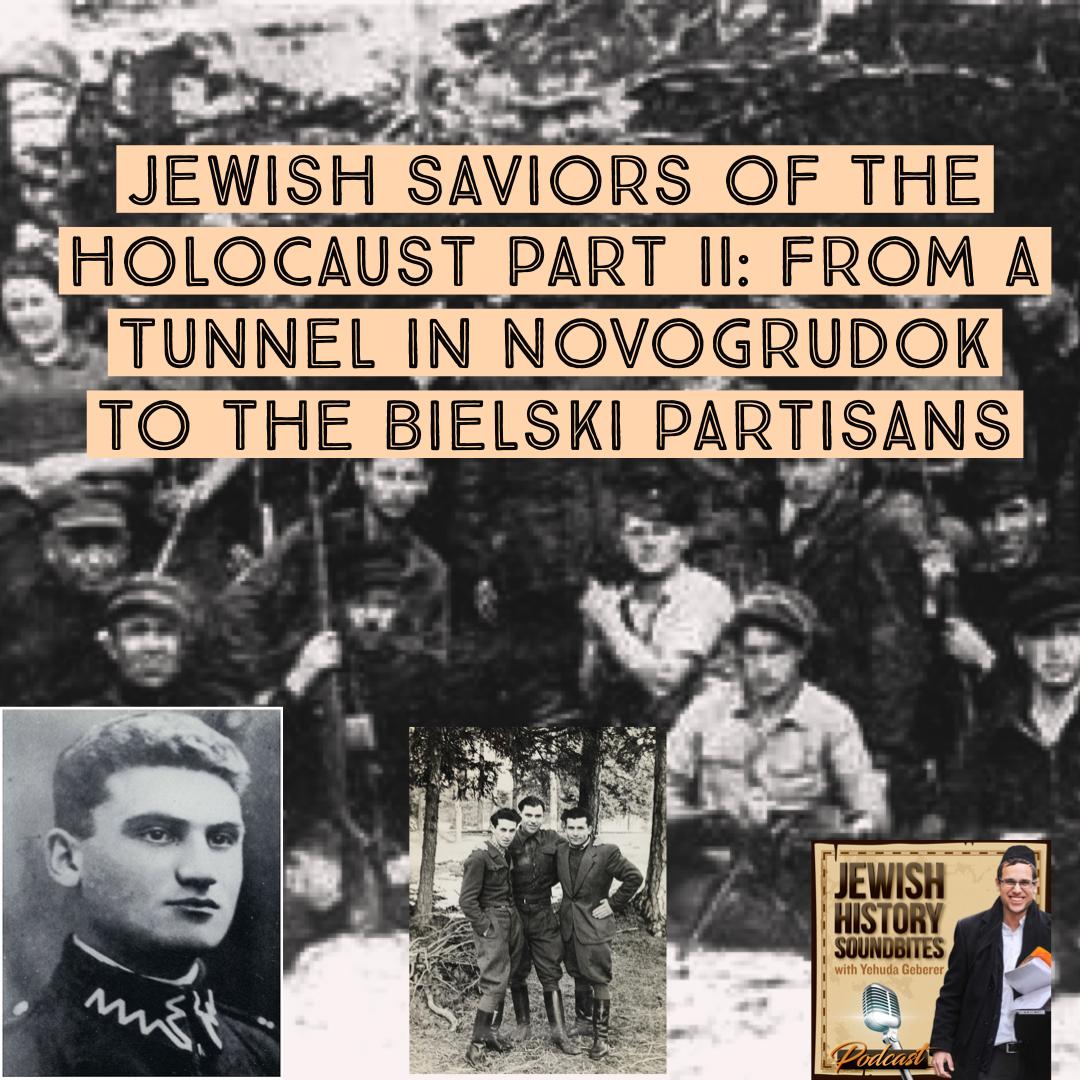 Jewish History SoundbitesJewish Saviors of the Holocaust Part II: From a Tunnel in Novogrudok to the Bielski PartisansOn the night of September 26, 1943 232 Jews escaped through a tunnel from the Novogrudok Ghetto. Nearly 170 survived, primarily by joining the Bielski partisans who operated nearby in the Naliboki forest. This was likely the greatest escape in Nazi occupied Europe throughout the entire war and Holocaust.
The tenacity and courage of the last Jews of the Novogrudok ghetto to dig a 250 meter tunnel leading to the forest, combined with the capability of joining Tuvia Bielski and his partisans, facilitated one of the most astounding stories of Jewish survival during the Holocaust. Tuvia Bielski famously said that he prioritizes...2022-07-1442 min
Jewish History SoundbitesJewish Saviors of the Holocaust Part II: From a Tunnel in Novogrudok to the Bielski PartisansOn the night of September 26, 1943 232 Jews escaped through a tunnel from the Novogrudok Ghetto. Nearly 170 survived, primarily by joining the Bielski partisans who operated nearby in the Naliboki forest. This was likely the greatest escape in Nazi occupied Europe throughout the entire war and Holocaust.
The tenacity and courage of the last Jews of the Novogrudok ghetto to dig a 250 meter tunnel leading to the forest, combined with the capability of joining Tuvia Bielski and his partisans, facilitated one of the most astounding stories of Jewish survival during the Holocaust. Tuvia Bielski famously said that he prioritizes...2022-07-1442 min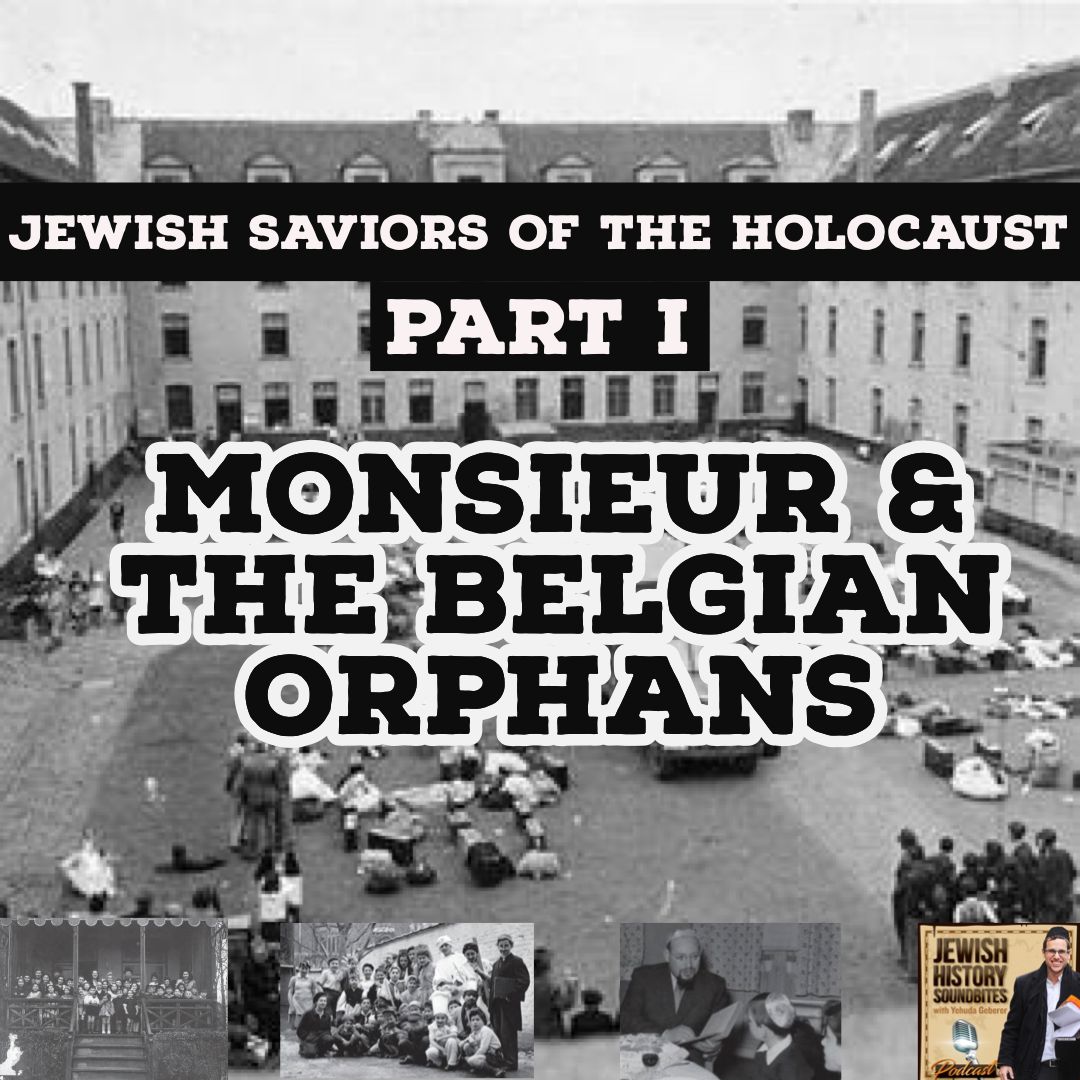 Jewish History SoundbitesJewish Saviors of the Holocaust Part I: Monsieur & the Belgian OrphansJewish History Soundbites is proud to launch a special series entitled ‘Jewish Saviors of the Holocaust’. It will explore the narratives of Jews under Nazi occupation risking their lives to save others during the Holocaust. Each unique profile will explore another story, angle and individual (or group of individuals) who though their own lives were at risk still did everything in their power to save others.
The series opens with the story of Yona Tiefenbrunner, known to the orphans he saves as ‘Monsieur’. Born in Germany, he arrived as a refugee in Belgium shortly before the war’s outbreak...2022-07-0546 min
Jewish History SoundbitesJewish Saviors of the Holocaust Part I: Monsieur & the Belgian OrphansJewish History Soundbites is proud to launch a special series entitled ‘Jewish Saviors of the Holocaust’. It will explore the narratives of Jews under Nazi occupation risking their lives to save others during the Holocaust. Each unique profile will explore another story, angle and individual (or group of individuals) who though their own lives were at risk still did everything in their power to save others.
The series opens with the story of Yona Tiefenbrunner, known to the orphans he saves as ‘Monsieur’. Born in Germany, he arrived as a refugee in Belgium shortly before the war’s outbreak...2022-07-0546 min Jewish History SoundbitesAn Enlightened Song: The Story of ShirPrague has had its fair share of characters throughout its storied history, yet Shlomo Yehuda Rapoport (1790-1867) or Shir as he was known was definitely one of the more interesting ones. Born into a rabbinic family in Lvov, Shir married the daughter of Rav Aryeh Leib Heller, the author of the Ketzos Hachoshen. Though he remained a scholarly, observant and rabbinic Jew for the remainder of his life, he also associated with the emerging Galician Haskalah (Jewish Enlightenment) of his era.
His intellectual pursuits included the study of medieval Jewish philosophy, languages, general science, history and literature, w...2022-06-2729 min
Jewish History SoundbitesAn Enlightened Song: The Story of ShirPrague has had its fair share of characters throughout its storied history, yet Shlomo Yehuda Rapoport (1790-1867) or Shir as he was known was definitely one of the more interesting ones. Born into a rabbinic family in Lvov, Shir married the daughter of Rav Aryeh Leib Heller, the author of the Ketzos Hachoshen. Though he remained a scholarly, observant and rabbinic Jew for the remainder of his life, he also associated with the emerging Galician Haskalah (Jewish Enlightenment) of his era.
His intellectual pursuits included the study of medieval Jewish philosophy, languages, general science, history and literature, w...2022-06-2729 min Jewish History SoundbitesGet it? The Strange Story of the ’Get of Cleves’The strange story of the Get of Kleve (or Cleves) rocked the rabbinical world of the 1760’s. What commenced as an innocuous question regarding a young man’s mental faculties, and his resulting capability of participating in a divorce ceremony, soon exploded into a general dispute about a rabbinical courts sole jurisdiction over a halachic dispute and the imposing of majority opinion among rabbis.
While the Frankfurt rabbinical court maintained that the groom in question was insane and therefore the get which he delivered was invalid, an increasing number of rabbis across Europe agreed with Rav Yisrael Lifsh...2022-05-0234 min
Jewish History SoundbitesGet it? The Strange Story of the ’Get of Cleves’The strange story of the Get of Kleve (or Cleves) rocked the rabbinical world of the 1760’s. What commenced as an innocuous question regarding a young man’s mental faculties, and his resulting capability of participating in a divorce ceremony, soon exploded into a general dispute about a rabbinical courts sole jurisdiction over a halachic dispute and the imposing of majority opinion among rabbis.
While the Frankfurt rabbinical court maintained that the groom in question was insane and therefore the get which he delivered was invalid, an increasing number of rabbis across Europe agreed with Rav Yisrael Lifsh...2022-05-0234 min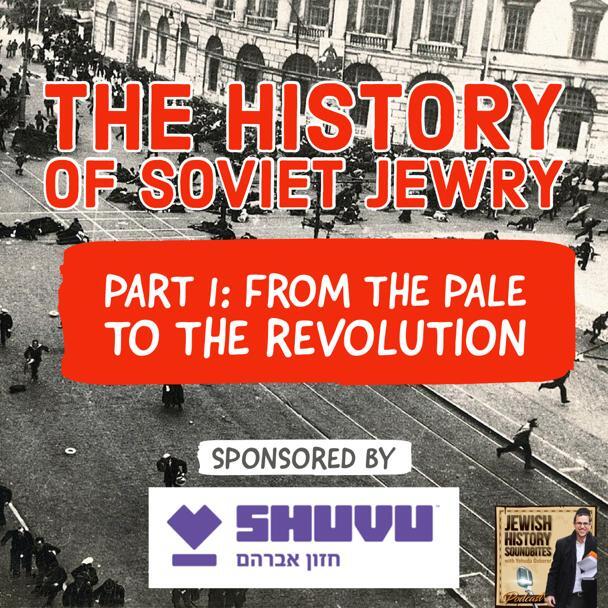 Jewish History SoundbitesThe History of Soviet Jewry Part I: From the Pale to the RevolutionThe Russian Revolutions of 1917 drastically transformed the lives of the largest Jewish community in the world. Emancipation was finally achieved, the hated Czar was finally deposed and they could finally reside outside the Pale of Settlement. With the founding of the Soviet Union in 1922, new challenges arrived on the scene. The new found freedom led to widespread assimilation. Couple with the mass internal migration to urban centers, this brought a great breakdown of traditional Jewish life. The Soviet communist government was openly hostile to organized religious life, and its rabbis were hounded and exiled.
This series on t...2022-03-1347 min
Jewish History SoundbitesThe History of Soviet Jewry Part I: From the Pale to the RevolutionThe Russian Revolutions of 1917 drastically transformed the lives of the largest Jewish community in the world. Emancipation was finally achieved, the hated Czar was finally deposed and they could finally reside outside the Pale of Settlement. With the founding of the Soviet Union in 1922, new challenges arrived on the scene. The new found freedom led to widespread assimilation. Couple with the mass internal migration to urban centers, this brought a great breakdown of traditional Jewish life. The Soviet communist government was openly hostile to organized religious life, and its rabbis were hounded and exiled.
This series on t...2022-03-1347 min Jewish History SoundbitesBrisk Management: Another Look at Rav Chaim BriskerRav Chaim Soloveitchik, known as Rav Chaim Brisker (1853-1918), has enjoyed an outsized influence on the methodology of Talmudic study and the development of the modern Torah world. As a historical figure he was not only influential but beloved as well, with countless stories of his kindness, care and leadership initiative as rabbi in Brisk as well as in wider rabbinic circles across the Pale of Settlement.
From his adopting abandoned children on his doorstep to his attempts at implementing pension plans for deceased rabbis widows and orphans, his care and attention to detail bespoke the responsibility...2022-03-0138 min
Jewish History SoundbitesBrisk Management: Another Look at Rav Chaim BriskerRav Chaim Soloveitchik, known as Rav Chaim Brisker (1853-1918), has enjoyed an outsized influence on the methodology of Talmudic study and the development of the modern Torah world. As a historical figure he was not only influential but beloved as well, with countless stories of his kindness, care and leadership initiative as rabbi in Brisk as well as in wider rabbinic circles across the Pale of Settlement.
From his adopting abandoned children on his doorstep to his attempts at implementing pension plans for deceased rabbis widows and orphans, his care and attention to detail bespoke the responsibility...2022-03-0138 min Jewish History SoundbitesFrom Slonim to Tverya: The Nesivos Shalom Part IIRav Shalom Noach Berezovsky was appointed Slonim Rebbe shortly prior to his father in law’s passing in 1981. As he had served as the rosh yeshiva of Slonim for decades, this enabled him to enjoy a close relationship with his followers who were for the most part his own students.
The background of the Slonim dynasty has its roots in White Russia, with antecedents in the court of Rav Mordechai of Lechovitz and Rav Moshe of Kobrin. Rav Avraham Weinberg, the Yesod Ha’avodah, founded the Slonim dynasty. He was succeeded by his grandson Rav Shmuel Weinberg, who passe...2022-02-2326 min
Jewish History SoundbitesFrom Slonim to Tverya: The Nesivos Shalom Part IIRav Shalom Noach Berezovsky was appointed Slonim Rebbe shortly prior to his father in law’s passing in 1981. As he had served as the rosh yeshiva of Slonim for decades, this enabled him to enjoy a close relationship with his followers who were for the most part his own students.
The background of the Slonim dynasty has its roots in White Russia, with antecedents in the court of Rav Mordechai of Lechovitz and Rav Moshe of Kobrin. Rav Avraham Weinberg, the Yesod Ha’avodah, founded the Slonim dynasty. He was succeeded by his grandson Rav Shmuel Weinberg, who passe...2022-02-2326 min Jewish History SoundbitesA Teacher from Slonim: The Nesivos Shalom Part IThe Slonim Rebbe, Rav Shalom Noach Berezovsky (1911-2000) was known by his popular work the Nesivos Shalom. Having grown up in Baranovich in the center of the Slonim chassidic dynasty, he was appointed by the rebbe the Bais Avraham to record his weekly discourses. Following his marriage and move to Tverya in 1935, he first found employment as a rosh yeshiva in Achei Temimim-Lubavitch in Tel Aviv.
Having heard of the decimation of the Slonim community in Europe during the Holocaust, he embarked on ambitious mission: to found a Slonim yeshiva in Yerushalayim with the goal of rebuilding t...2022-02-1726 min
Jewish History SoundbitesA Teacher from Slonim: The Nesivos Shalom Part IThe Slonim Rebbe, Rav Shalom Noach Berezovsky (1911-2000) was known by his popular work the Nesivos Shalom. Having grown up in Baranovich in the center of the Slonim chassidic dynasty, he was appointed by the rebbe the Bais Avraham to record his weekly discourses. Following his marriage and move to Tverya in 1935, he first found employment as a rosh yeshiva in Achei Temimim-Lubavitch in Tel Aviv.
Having heard of the decimation of the Slonim community in Europe during the Holocaust, he embarked on ambitious mission: to found a Slonim yeshiva in Yerushalayim with the goal of rebuilding t...2022-02-1726 min Jewish History SoundbitesFrom World War to Revolution: Iranian Jewry Part IIIranian Jewry in the 20th century saw much upheaval. The rise of the Pahlavi dynasty brought much hope to the Persian Jewish community. Iran served as a center of some important events of World War II with the Anglo-Soviet invasion of the country, as host of the Teheran Conference, the exit of the Polish Anders Army through Iran and many Jewish refugees arriving there including the famous ‘Yaldei Teheran’.
Another period of relative stability was interrupted towards the end of the 1970’s with the Revolution and the subsequent Iran-Iraq war. Much emigration occurred around this time. Rabbi Herman...2022-02-1232 min
Jewish History SoundbitesFrom World War to Revolution: Iranian Jewry Part IIIranian Jewry in the 20th century saw much upheaval. The rise of the Pahlavi dynasty brought much hope to the Persian Jewish community. Iran served as a center of some important events of World War II with the Anglo-Soviet invasion of the country, as host of the Teheran Conference, the exit of the Polish Anders Army through Iran and many Jewish refugees arriving there including the famous ‘Yaldei Teheran’.
Another period of relative stability was interrupted towards the end of the 1970’s with the Revolution and the subsequent Iran-Iraq war. Much emigration occurred around this time. Rabbi Herman...2022-02-1232 min Jewish History SoundbitesPrinces of Persia: Iranian Jewry Part IThe ancient Jewish community of Persia/Iran is one of the oldest Jewish communities in the world. The site of the Purim story and many Biblical and Talmudic era luminaries, it continued to flourish through times of stability and persecution.
One of the great rabbinical leaders in the city of Hamedan, Iran in modern times was Chacham Mola David Sasson Rabban (1879-1974). As rabbi of the community he oversaw its growth and later decline in mid 20th century to widespread emigration, while corresponding with rabbis across Iran and in neighboring Iraq. He also ran the local Otzar H...2022-02-0632 min
Jewish History SoundbitesPrinces of Persia: Iranian Jewry Part IThe ancient Jewish community of Persia/Iran is one of the oldest Jewish communities in the world. The site of the Purim story and many Biblical and Talmudic era luminaries, it continued to flourish through times of stability and persecution.
One of the great rabbinical leaders in the city of Hamedan, Iran in modern times was Chacham Mola David Sasson Rabban (1879-1974). As rabbi of the community he oversaw its growth and later decline in mid 20th century to widespread emigration, while corresponding with rabbis across Iran and in neighboring Iraq. He also ran the local Otzar H...2022-02-0632 min Jewish History SoundbitesChabad & Zionism Part IIWith the passing of the fifth rebbe of Chabad the Rashab in 1920, his son Rav Yosef Yitzchak Schneerson (1880-1950), the Rayatz, or the Freidiker (previous) Rebbe, took over the Chabad-Lubavitch movement at a time of crisis. Through the decades of his leadership he expressed a commitment to the ideals of his father in regards to Zionism, while dealing with the practical upheavals of Jewish life including the Holocaust and the founding of the State of Israel.
This was continued by his son in law and successor Rav Menachem Mendel Schneerson. While in theory, the opposition to ideas...2022-01-3037 min
Jewish History SoundbitesChabad & Zionism Part IIWith the passing of the fifth rebbe of Chabad the Rashab in 1920, his son Rav Yosef Yitzchak Schneerson (1880-1950), the Rayatz, or the Freidiker (previous) Rebbe, took over the Chabad-Lubavitch movement at a time of crisis. Through the decades of his leadership he expressed a commitment to the ideals of his father in regards to Zionism, while dealing with the practical upheavals of Jewish life including the Holocaust and the founding of the State of Israel.
This was continued by his son in law and successor Rav Menachem Mendel Schneerson. While in theory, the opposition to ideas...2022-01-3037 min Jewish History SoundbitesWise Man of Hungary: Rav Yehuda AszodRav Yehuda Aszod (1796-1866) was one of the architects of the emerging Hungarian Orthodoxy of the 19th century. A student of the Maharam Banet, he went to serve in the rabbinate and as a rosh yeshiva in several towns, the most prominent of which was in Dunaszerdahely in the Austrian Empire.
Ideologically positioned between neo Orthodoxy as represented by Rav Ezriel Hildesheimer and Hungarian Ultra-Orthodoxy as represented by Rav Hillel Lichtenstein, Rav Yehuda Aszod emerged as a leader of mainstream orthodoxy along with his colleague the Ksav Sofer. For decades he confronted modernist trends, any assault on t...2022-01-2231 min
Jewish History SoundbitesWise Man of Hungary: Rav Yehuda AszodRav Yehuda Aszod (1796-1866) was one of the architects of the emerging Hungarian Orthodoxy of the 19th century. A student of the Maharam Banet, he went to serve in the rabbinate and as a rosh yeshiva in several towns, the most prominent of which was in Dunaszerdahely in the Austrian Empire.
Ideologically positioned between neo Orthodoxy as represented by Rav Ezriel Hildesheimer and Hungarian Ultra-Orthodoxy as represented by Rav Hillel Lichtenstein, Rav Yehuda Aszod emerged as a leader of mainstream orthodoxy along with his colleague the Ksav Sofer. For decades he confronted modernist trends, any assault on t...2022-01-2231 min Jewish History SoundbitesA Dazzling Light: The Life & Impact of Rabbi Aryeh KaplanRabbi Aryeh Kaplan (1934-1983) was a dazzling light on the Jewish history scene of the 20th century. With family origins in Thessaloniki, Greece, he was born in the Bronx, and eventually studied at Yeshiva Torah Vodaath and Mir Yeshiva in Jerusalem. Returning to the US he became a physicist and then a pulpit rabbi, before entering the world of Jewish outreach.
In his later years he maintained a prodigious literary output, authoring a large amount of works across the gamut of Jewish thought, mysticism, chassidic thought and practical Jewish observance. Much of this was commissioned by NCSY...2022-01-1525 min
Jewish History SoundbitesA Dazzling Light: The Life & Impact of Rabbi Aryeh KaplanRabbi Aryeh Kaplan (1934-1983) was a dazzling light on the Jewish history scene of the 20th century. With family origins in Thessaloniki, Greece, he was born in the Bronx, and eventually studied at Yeshiva Torah Vodaath and Mir Yeshiva in Jerusalem. Returning to the US he became a physicist and then a pulpit rabbi, before entering the world of Jewish outreach.
In his later years he maintained a prodigious literary output, authoring a large amount of works across the gamut of Jewish thought, mysticism, chassidic thought and practical Jewish observance. Much of this was commissioned by NCSY...2022-01-1525 min Jewish History SoundbitesThe Czars & The Jews Part IFollowing the partitions of Poland in the last quarter of the 18th century, the largest Jewish community in the world found themselves under the rule of the Romanov dynasty in the Russian Empire. Each Czar formulated a distinct policy in regards to the Jewish population, and many of these policies, along with the Jewish community’s reaction, often has ramifications until this very day.
Catherine the Great was czarina during the years of the partition itself, and she commenced her Jewish policy influenced by the ideas of enlightened absolutism. Jews were granted partial emancipation but the beginnings of...2022-01-0935 min
Jewish History SoundbitesThe Czars & The Jews Part IFollowing the partitions of Poland in the last quarter of the 18th century, the largest Jewish community in the world found themselves under the rule of the Romanov dynasty in the Russian Empire. Each Czar formulated a distinct policy in regards to the Jewish population, and many of these policies, along with the Jewish community’s reaction, often has ramifications until this very day.
Catherine the Great was czarina during the years of the partition itself, and she commenced her Jewish policy influenced by the ideas of enlightened absolutism. Jews were granted partial emancipation but the beginnings of...2022-01-0935 min Jewish History SoundbitesThe Roar of the Lion: The Life of Rav Leib Malin Part IPrewar student of Rav Yerucham Levovitz and the Brisker Rov, leader during the Mir Yeshiva’s wartime escape to Shanghai, and postwar builder of Bais Hatalmud in Brooklyn, Rav Leib Malin (1906-1962) was the ‘Lion of the Mir’.
In part 1 of examining his life and accomplishments, we examine his family background, leadership role in the escape to Shanghai, and his replanting Torah through his Bais Hatalmud yeshiva in the postwar United States. The unique circumstances of this rebuilding attempt, made his all encompassing vision of what a yeshiva is a historic landmark in the role that the yeshiva...2022-01-0233 min
Jewish History SoundbitesThe Roar of the Lion: The Life of Rav Leib Malin Part IPrewar student of Rav Yerucham Levovitz and the Brisker Rov, leader during the Mir Yeshiva’s wartime escape to Shanghai, and postwar builder of Bais Hatalmud in Brooklyn, Rav Leib Malin (1906-1962) was the ‘Lion of the Mir’.
In part 1 of examining his life and accomplishments, we examine his family background, leadership role in the escape to Shanghai, and his replanting Torah through his Bais Hatalmud yeshiva in the postwar United States. The unique circumstances of this rebuilding attempt, made his all encompassing vision of what a yeshiva is a historic landmark in the role that the yeshiva...2022-01-0233 min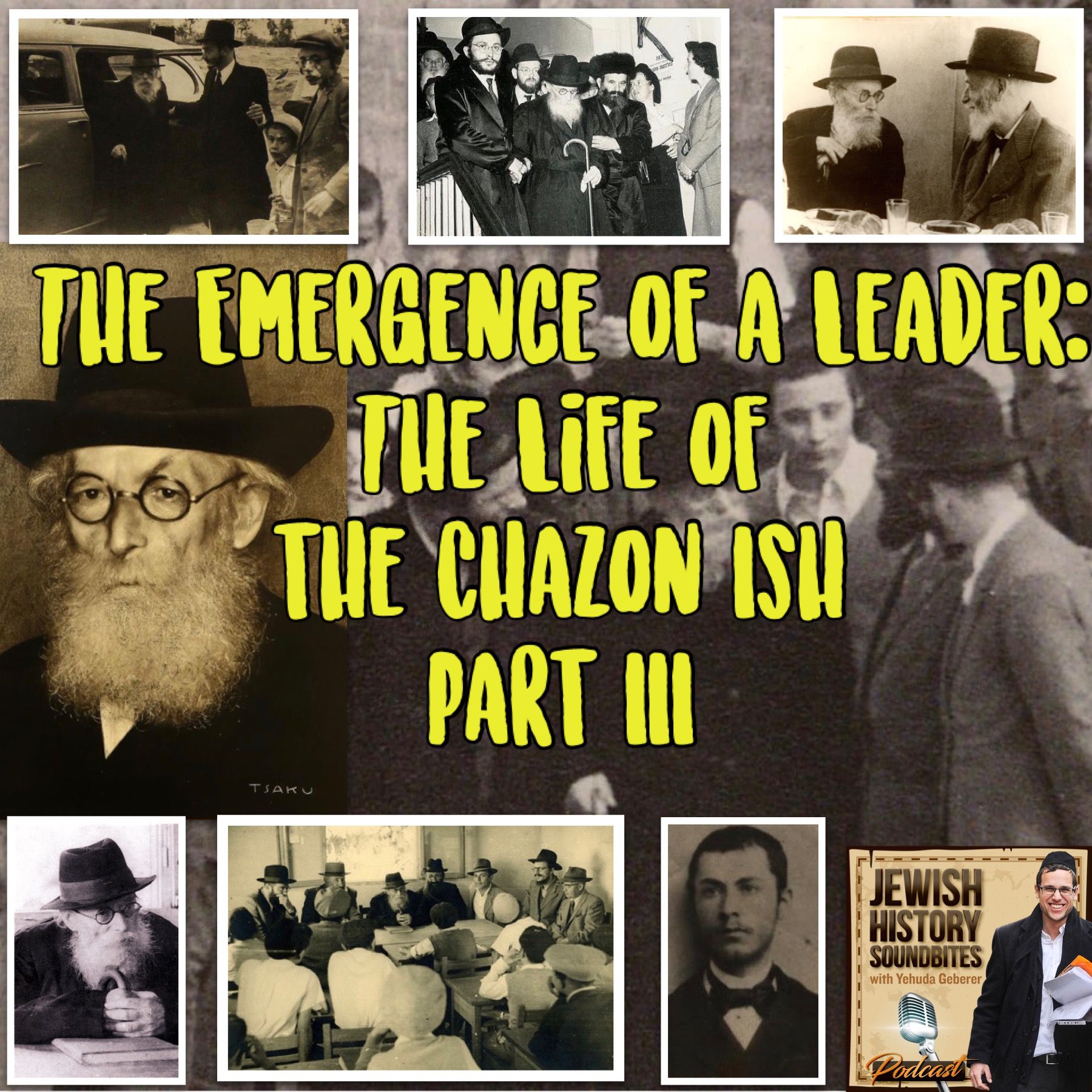 Jewish History SoundbitesThe Emergence of a Leader: The Life of the Chazon Ish Part IIIIn part 3 of the story of Rav Avraham Yeshaya Karelitz (1878-1953), the Chazon Ish, his path is traced from his relative obscurity to his emergence as a leader. From expressing halachic positions for the Poalei Agudas Yisrael agricultural settlements, to building yeshivos across the new yishuv, the Chazon Ish soon emerged as a well known posek with the psak he issued regarding the International Dateline.
While losing much of his family during the Holocaust and suffering other personal challenges during the 1940’s, the decade saw him become an address for many seeking his advice and blessing as his...2021-12-2535 min
Jewish History SoundbitesThe Emergence of a Leader: The Life of the Chazon Ish Part IIIIn part 3 of the story of Rav Avraham Yeshaya Karelitz (1878-1953), the Chazon Ish, his path is traced from his relative obscurity to his emergence as a leader. From expressing halachic positions for the Poalei Agudas Yisrael agricultural settlements, to building yeshivos across the new yishuv, the Chazon Ish soon emerged as a well known posek with the psak he issued regarding the International Dateline.
While losing much of his family during the Holocaust and suffering other personal challenges during the 1940’s, the decade saw him become an address for many seeking his advice and blessing as his...2021-12-2535 min Jewish History SoundbitesIron Yid: The Story of Zishe BreitbartZishe or Siegmund Breitbart (1893-1925) was a circus strongman, and a Jewish folk hero of his day. Having grown up in an observant home in Strykov in Poland, his remarkable strength eventually led him to the Busch circus in Germany, where he toured the world, bending iron, and holding incredible weights on his chest, among other feats of strength.
To the Jewish masses of Eastern Europe, he was a superhero. He was proud of his Jewish identity and never shied away even in the face of anti-Semitism. His generosity to Jewish causes knew no bounds, and he c...2021-12-2033 min
Jewish History SoundbitesIron Yid: The Story of Zishe BreitbartZishe or Siegmund Breitbart (1893-1925) was a circus strongman, and a Jewish folk hero of his day. Having grown up in an observant home in Strykov in Poland, his remarkable strength eventually led him to the Busch circus in Germany, where he toured the world, bending iron, and holding incredible weights on his chest, among other feats of strength.
To the Jewish masses of Eastern Europe, he was a superhero. He was proud of his Jewish identity and never shied away even in the face of anti-Semitism. His generosity to Jewish causes knew no bounds, and he c...2021-12-2033 min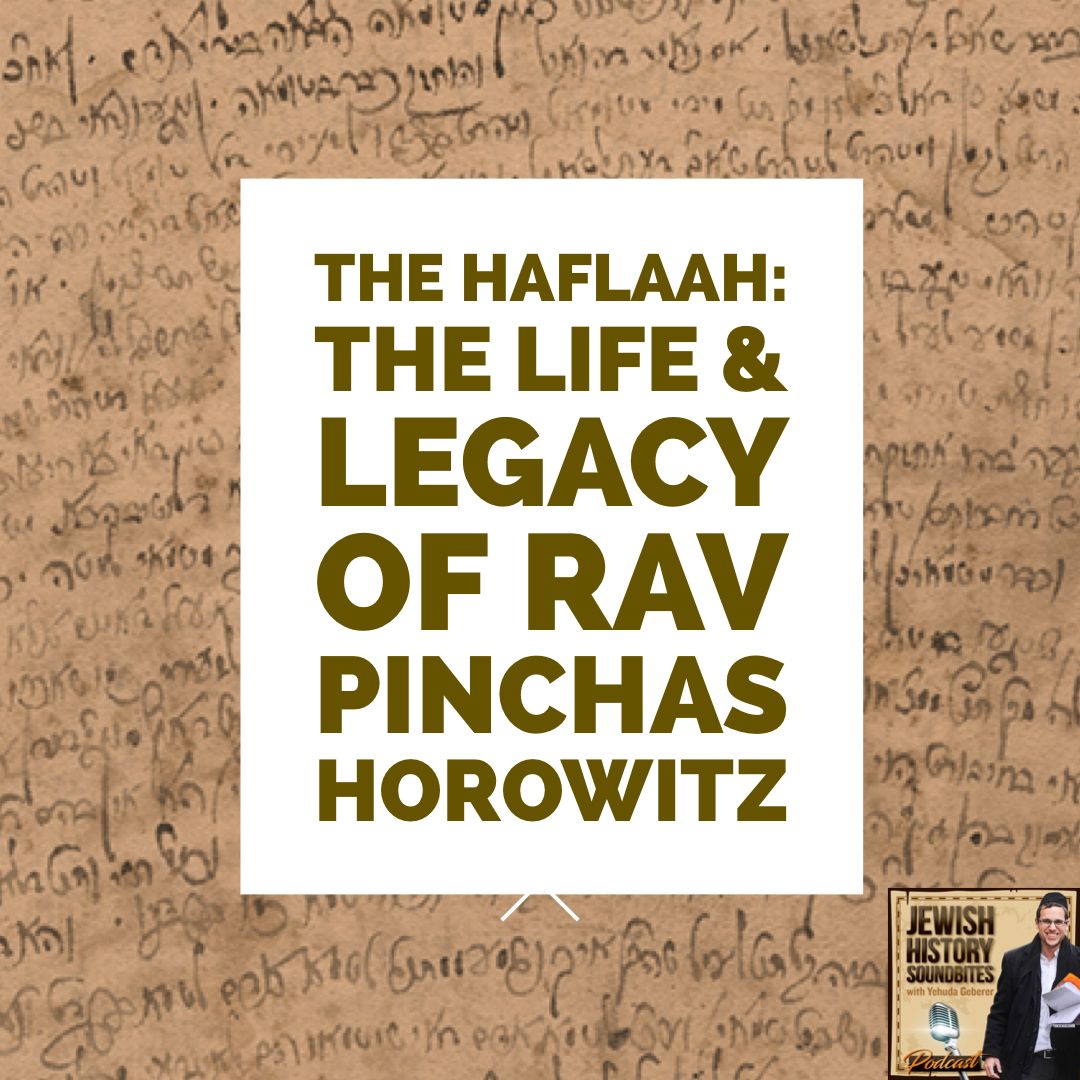 Jewish History SoundbitesThe Haflaah: The Life & Legacy of Rav Pinchas HorowitzRav Pinchas Horowitz (1731-1805), known by his most enduring literary work ‘the Hafla’ah’, was unique in the respect that the varied aspects of his legacy enjoyed a broad consensus across the Jewish world. He served for 33 years at the helm of the Frankfurt rabbinate. His works Hafla’ah, Makneh and others on Shas have become classics in the yeshiva world, while his Torah commentary Panim Yafos enjoys enduring popularity as well. His relationship with the Maggid of Mezritch and the level of Rav Pinchas’s identity as a chassid has been a matter of dispute, and has also come to de...2021-12-1231 min
Jewish History SoundbitesThe Haflaah: The Life & Legacy of Rav Pinchas HorowitzRav Pinchas Horowitz (1731-1805), known by his most enduring literary work ‘the Hafla’ah’, was unique in the respect that the varied aspects of his legacy enjoyed a broad consensus across the Jewish world. He served for 33 years at the helm of the Frankfurt rabbinate. His works Hafla’ah, Makneh and others on Shas have become classics in the yeshiva world, while his Torah commentary Panim Yafos enjoys enduring popularity as well. His relationship with the Maggid of Mezritch and the level of Rav Pinchas’s identity as a chassid has been a matter of dispute, and has also come to de...2021-12-1231 min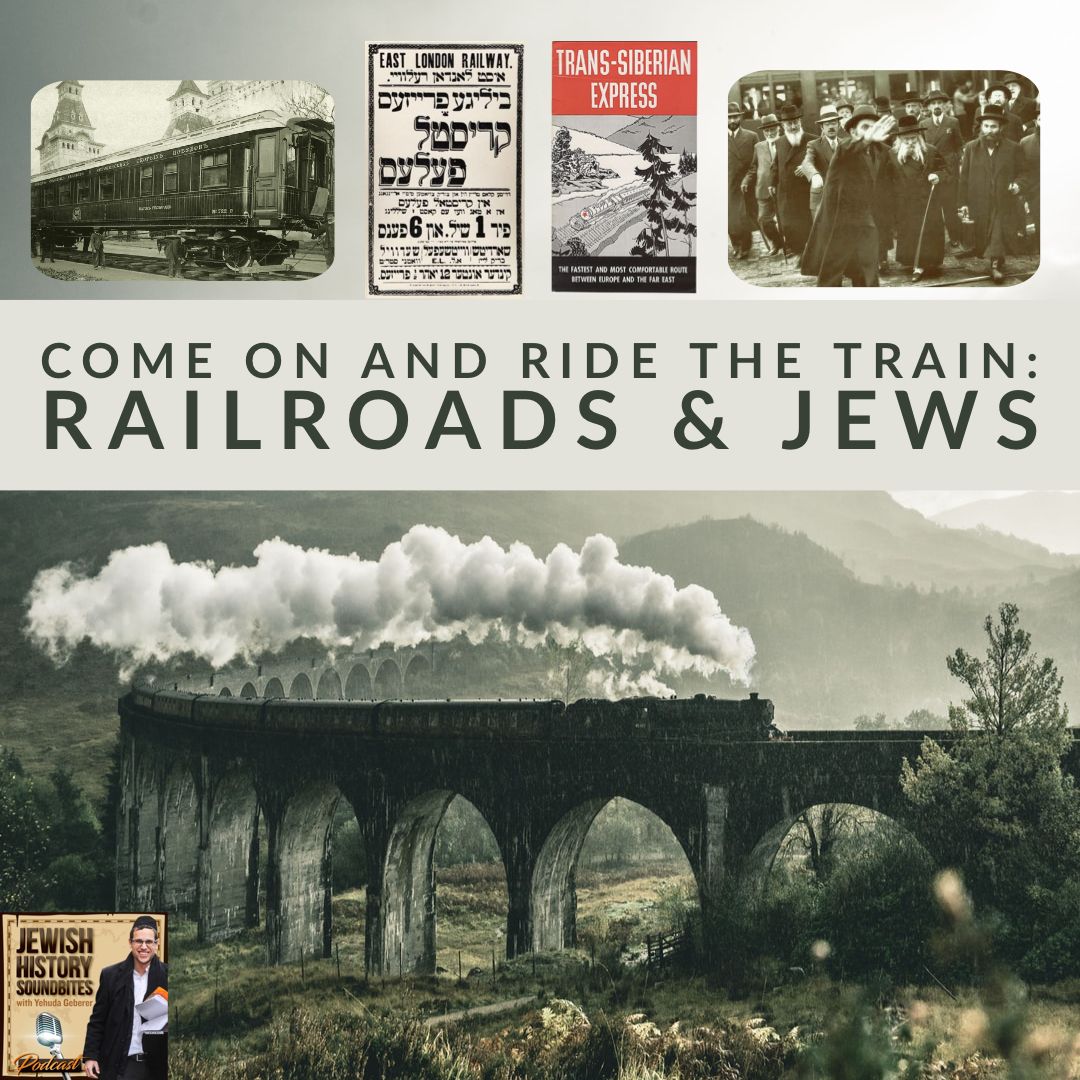 Jewish History SoundbitesCome on and Ride the Train: Railroads & JewsThe development of the railroad and the laying of rail track across the Russian Empire in the late 19th century, had a tremendous impact on traditional Jewish life in the Pale of Settlement. The railroad brought economic changes, implosion of communal structures and challenges to traditional norms. It enabled information to travel and for the spread of ideas, and for isolated shtetl’s to have access to wider society.
Among other things, the development of the railroad in Russia enabled the spread of anti-Semitism and pogroms. It also played a crucial role in facilitating the Great Immigration. Wit...2021-12-0728 min
Jewish History SoundbitesCome on and Ride the Train: Railroads & JewsThe development of the railroad and the laying of rail track across the Russian Empire in the late 19th century, had a tremendous impact on traditional Jewish life in the Pale of Settlement. The railroad brought economic changes, implosion of communal structures and challenges to traditional norms. It enabled information to travel and for the spread of ideas, and for isolated shtetl’s to have access to wider society.
Among other things, the development of the railroad in Russia enabled the spread of anti-Semitism and pogroms. It also played a crucial role in facilitating the Great Immigration. Wit...2021-12-0728 min Jewish History SoundbitesChabad & Zionism Part I: The RashabRav Sholom Dovber Schneerson (1860-1920), better known as the Rashab, as the fifth Rebbe of Chabad-Lubavitch, was one of the leaders of Russian Jewry at a time when it confronted many challenges of modernity. One of those challenges was the new Jewish nationalism as expressed in the nascent Zionist movement in the late 1890’s. The Rashab decided to confront what he understood to be a danger to traditional Judaism, by initiating a project which would present a united Orthodox front in opposition to Zionism.
To that end he partnered with Yaakov Lifshitz and the ‘Lishka Hashechora’ in Kovno...2021-12-0130 min
Jewish History SoundbitesChabad & Zionism Part I: The RashabRav Sholom Dovber Schneerson (1860-1920), better known as the Rashab, as the fifth Rebbe of Chabad-Lubavitch, was one of the leaders of Russian Jewry at a time when it confronted many challenges of modernity. One of those challenges was the new Jewish nationalism as expressed in the nascent Zionist movement in the late 1890’s. The Rashab decided to confront what he understood to be a danger to traditional Judaism, by initiating a project which would present a united Orthodox front in opposition to Zionism.
To that end he partnered with Yaakov Lifshitz and the ‘Lishka Hashechora’ in Kovno...2021-12-0130 min Jewish History SoundbitesThe Legacy of the Vilna GaonThe Vilna Gaon, or the Gra, or Hagaon Hachassid, were just several of the titles by which Rav Eliyahu ben Shlomo Zalman (1720-1797) was known during his lifetime and to posterity. It would be difficult to find many others who had the influence and impact on Jewish life which the Gaon had and continues to have on Jewish society. This episode will examine some of the aspects of the Vilna Gaon’s legacy, both during his own lifetime and through the more than two centuries since his passing.
For sponsorship opportunities about your favorite topics of J...2021-11-2532 min
Jewish History SoundbitesThe Legacy of the Vilna GaonThe Vilna Gaon, or the Gra, or Hagaon Hachassid, were just several of the titles by which Rav Eliyahu ben Shlomo Zalman (1720-1797) was known during his lifetime and to posterity. It would be difficult to find many others who had the influence and impact on Jewish life which the Gaon had and continues to have on Jewish society. This episode will examine some of the aspects of the Vilna Gaon’s legacy, both during his own lifetime and through the more than two centuries since his passing.
For sponsorship opportunities about your favorite topics of J...2021-11-2532 min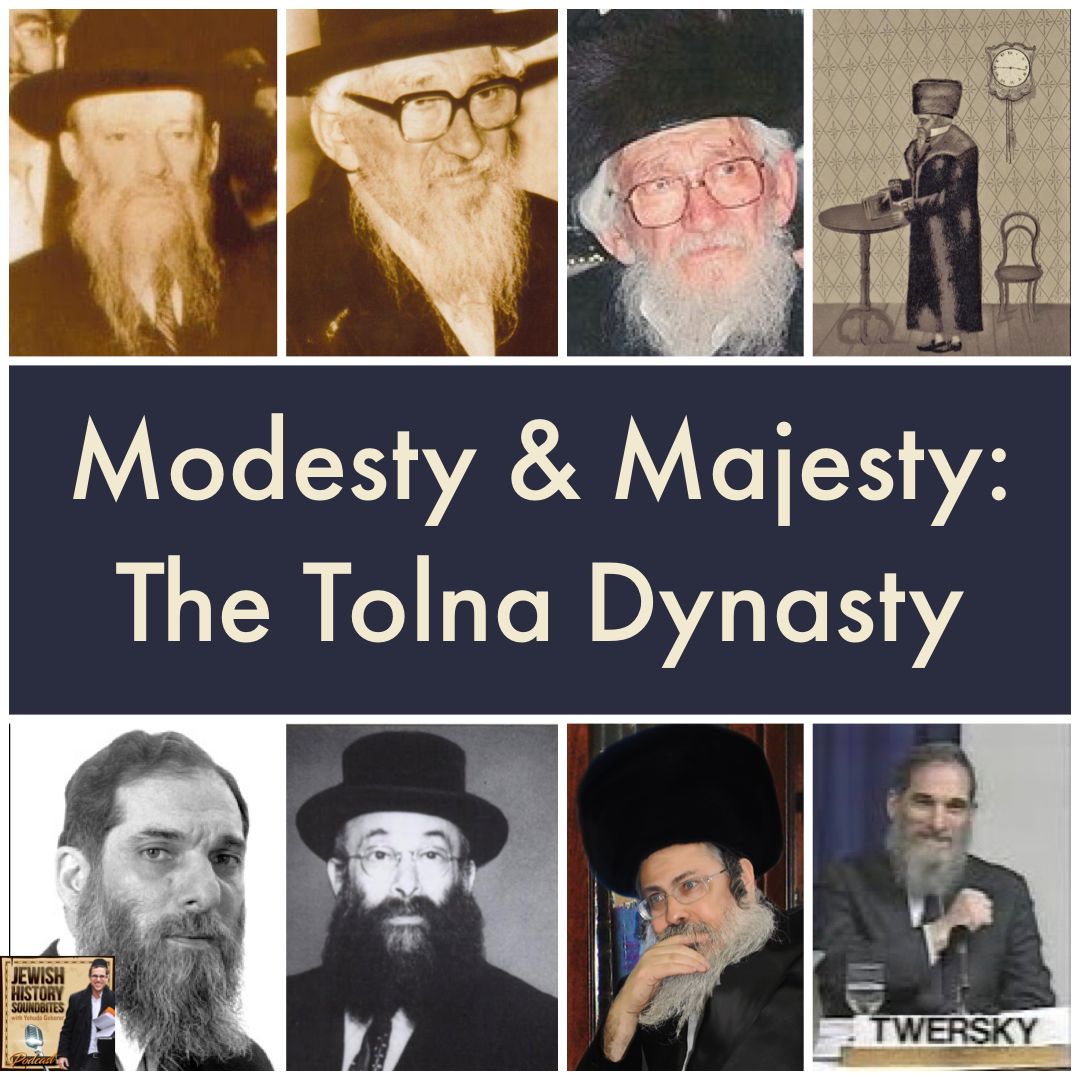 Jewish History SoundbitesModesty & Majesty: The Tolna DynastyThe Tolna chassidic dynasty is a branch of the Chernobyl dynasty founded in Ukraine in the 19th century. Rav Dovid Twersky of Tolna (1808-1882) was one of the most influential leaders of chassidic Ukraine in the mid 19th century, spreading his influence throughout the Kiev area. He was succeeded by his grandson Rav Menachem Nochum, who in turn was succeeded by his three sons, all of whom immigrated to the United States.
The prominent Tolna Rebbe of modern times was Rav Yochanan Twersky (1906-1999). Presumably the first active Rebbe in Montreal, he had an impact on Canadian J...2021-11-1731 min
Jewish History SoundbitesModesty & Majesty: The Tolna DynastyThe Tolna chassidic dynasty is a branch of the Chernobyl dynasty founded in Ukraine in the 19th century. Rav Dovid Twersky of Tolna (1808-1882) was one of the most influential leaders of chassidic Ukraine in the mid 19th century, spreading his influence throughout the Kiev area. He was succeeded by his grandson Rav Menachem Nochum, who in turn was succeeded by his three sons, all of whom immigrated to the United States.
The prominent Tolna Rebbe of modern times was Rav Yochanan Twersky (1906-1999). Presumably the first active Rebbe in Montreal, he had an impact on Canadian J...2021-11-1731 min Jewish History SoundbitesRosh Yeshiva & Rebbe: The Pnei Menachem of GerRav Pinchas Menachem Alter (1926-1996), known as the Pnei Menachem of Ger, led an interesting career in public leadership. Born into prewar Polish chassidic aristocracy, he escaped with his father the Ger Rebbe following the outbreak of the war. He eventually became the rosh yeshiva of the flagship Sfas Emes Yeshiva, and later the head of Agudas Yisroel in Israel.
In his last years, he served as the Rebbe of Ger for just over three years before his passing in 1996. Renowned for his Torah scholarship, warmth, modesty and accessibility, he was beloved well beyond the confines of t...2021-11-1136 min
Jewish History SoundbitesRosh Yeshiva & Rebbe: The Pnei Menachem of GerRav Pinchas Menachem Alter (1926-1996), known as the Pnei Menachem of Ger, led an interesting career in public leadership. Born into prewar Polish chassidic aristocracy, he escaped with his father the Ger Rebbe following the outbreak of the war. He eventually became the rosh yeshiva of the flagship Sfas Emes Yeshiva, and later the head of Agudas Yisroel in Israel.
In his last years, he served as the Rebbe of Ger for just over three years before his passing in 1996. Renowned for his Torah scholarship, warmth, modesty and accessibility, he was beloved well beyond the confines of t...2021-11-1136 min Jewish History SoundbitesA House Divided: The Partitions of Poland & the JewsThe three partitions of Poland in 1772, 1793 & 1795 ended the Polish Kingdom (or the Polish-Lithuanian Commonwealth), and divided it between Austria, Russia and Prussia. This had far reaching consequences for the largest Jewish community in the world which had resided within the borders of the kingdom.
Their new rulers desired a more central authority, and much of the Jewish autonomy was curtailed as a result. The Jewish communities of each empire found themselves under new political entities, new laws, new language and culture, and they now were on a different trajectory than their brethren who were on the other s...2021-11-0336 min
Jewish History SoundbitesA House Divided: The Partitions of Poland & the JewsThe three partitions of Poland in 1772, 1793 & 1795 ended the Polish Kingdom (or the Polish-Lithuanian Commonwealth), and divided it between Austria, Russia and Prussia. This had far reaching consequences for the largest Jewish community in the world which had resided within the borders of the kingdom.
Their new rulers desired a more central authority, and much of the Jewish autonomy was curtailed as a result. The Jewish communities of each empire found themselves under new political entities, new laws, new language and culture, and they now were on a different trajectory than their brethren who were on the other s...2021-11-0336 min Jewish History SoundbitesAccording to Rav Tikochinsky.... The Live of Rav Yechiel Michel TikochinskyOne of the leaders and influential poskim of the Old Yishuv in Jerusalem, Rav Yechiel Michel Tikochinsky (1871-1955) had an outsized impact on the world of halacha, especially in regards to zmanim- halachic time. As the long-time administrator of the Eitz Chaim Yeshiva and accompanying institutions, he oversaw its move to the new city in Yerushalayim, where it entered an era of expansion and growth.
He pioneered many areas of halacha, including the laws of mourning, shmittah, the halachic international dateline, laws of Jerusalem and the Bais Hamikdash. Having cultivated both a love as well as a k...2021-10-2833 min
Jewish History SoundbitesAccording to Rav Tikochinsky.... The Live of Rav Yechiel Michel TikochinskyOne of the leaders and influential poskim of the Old Yishuv in Jerusalem, Rav Yechiel Michel Tikochinsky (1871-1955) had an outsized impact on the world of halacha, especially in regards to zmanim- halachic time. As the long-time administrator of the Eitz Chaim Yeshiva and accompanying institutions, he oversaw its move to the new city in Yerushalayim, where it entered an era of expansion and growth.
He pioneered many areas of halacha, including the laws of mourning, shmittah, the halachic international dateline, laws of Jerusalem and the Bais Hamikdash. Having cultivated both a love as well as a k...2021-10-2833 min Jewish History SoundbitesThe Chief Rabbi: Rabbi Lord Jonathan SacksRabbi Lord Jonathan Sacks (1948-2020) was one of the great figures of recent Jewish history. As Chief Rabbi of the United Hebrew Congregations of the Commonwealth from 1991-2013, he was the great spokesman for both British Jewry as well as on the larger Jewish stage.
Sponsored in tribute to one of the generation's inspiring Torah luminaries - join a special evening of learning and conversation in memory of Rabbi Lord Jonathan Sacks ztz"l upon the occasion of his first yahrzeit - register to watch on Tuesday, October 26 at 7:00 pm EST at ou.org/rabbisacks ...2021-10-2426 min
Jewish History SoundbitesThe Chief Rabbi: Rabbi Lord Jonathan SacksRabbi Lord Jonathan Sacks (1948-2020) was one of the great figures of recent Jewish history. As Chief Rabbi of the United Hebrew Congregations of the Commonwealth from 1991-2013, he was the great spokesman for both British Jewry as well as on the larger Jewish stage.
Sponsored in tribute to one of the generation's inspiring Torah luminaries - join a special evening of learning and conversation in memory of Rabbi Lord Jonathan Sacks ztz"l upon the occasion of his first yahrzeit - register to watch on Tuesday, October 26 at 7:00 pm EST at ou.org/rabbisacks ...2021-10-2426 min Jewish History SoundbitesGreat American Jewish Cities #19: Boston Part IIBoston part II is here, with another foray into the history of the Boston Jewish community. As the Jewish community migrated from the West End to Roxbury, Dorchester and eventually Brookline, new institutions were built to accommodate the needs of the growing community.
Rav Joseph B. and Tonya Soloveitchik established the Maimonides Hebrew Day School, and hired Rabbi Moses Cohen as the principal. Other early rabbis included Rabbi Rephoel Landau, the Tolna Rebbe Rav Meshulam Zusha Twersky, the Boston Rebbe Rav Levi Yitzchak Horowitz, Rav Shlomo Margolis and out in Chelsea was Rabbi Kalman Lichtenstein. Generations of t...2021-10-2132 min
Jewish History SoundbitesGreat American Jewish Cities #19: Boston Part IIBoston part II is here, with another foray into the history of the Boston Jewish community. As the Jewish community migrated from the West End to Roxbury, Dorchester and eventually Brookline, new institutions were built to accommodate the needs of the growing community.
Rav Joseph B. and Tonya Soloveitchik established the Maimonides Hebrew Day School, and hired Rabbi Moses Cohen as the principal. Other early rabbis included Rabbi Rephoel Landau, the Tolna Rebbe Rav Meshulam Zusha Twersky, the Boston Rebbe Rav Levi Yitzchak Horowitz, Rav Shlomo Margolis and out in Chelsea was Rabbi Kalman Lichtenstein. Generations of t...2021-10-2132 min Jewish History Soundbites10th Yahrtzeit Special: Memories of Rav Nosson Tzvi FinkelTo commemorate the 10th yahrtzeit of the Mir Rosh Yeshiva Rav Nosson Tzvi Finkel (1943-2011), here is another installment of impressions and recollections of this great man and his impact on the larger Torah world. Viewing his great accomplishments over the course of his 22 year tenure at the helm of Mir Yeshiva, one is tempted to see them in the greater context of the rebirth of the Torah world in the postwar era. His projects can be seen as launching an era of expansion, following decades of modest rebuilding.
From his modest beginnings as a youth in...2021-10-1626 min
Jewish History Soundbites10th Yahrtzeit Special: Memories of Rav Nosson Tzvi FinkelTo commemorate the 10th yahrtzeit of the Mir Rosh Yeshiva Rav Nosson Tzvi Finkel (1943-2011), here is another installment of impressions and recollections of this great man and his impact on the larger Torah world. Viewing his great accomplishments over the course of his 22 year tenure at the helm of Mir Yeshiva, one is tempted to see them in the greater context of the rebirth of the Torah world in the postwar era. His projects can be seen as launching an era of expansion, following decades of modest rebuilding.
From his modest beginnings as a youth in...2021-10-1626 min Jewish History SoundbitesGreat American Jewish Cities #23: Houston Part IIIn this second installment on the Jewish history of Houston and South Texas, the renaissance of Orthodox through the pioneering efforts of Rabbi Joseph Radinsky of the United Orthodox Synagogue, Rabbi Shimon Lazaroff of Chabad and Rabbi Yehoshua Wender of the Young Israel of Houston. The development of air conditioning led to a population explosion in Houston in 1960’s, and the S&L scandal led to its reduction in the late 80’s. Nevertheless, institutions were built, schools grew and a Kollel was founded in recent times as well.
40 miles to the west lies the town of Hempstead. Its...2021-10-1236 min
Jewish History SoundbitesGreat American Jewish Cities #23: Houston Part IIIn this second installment on the Jewish history of Houston and South Texas, the renaissance of Orthodox through the pioneering efforts of Rabbi Joseph Radinsky of the United Orthodox Synagogue, Rabbi Shimon Lazaroff of Chabad and Rabbi Yehoshua Wender of the Young Israel of Houston. The development of air conditioning led to a population explosion in Houston in 1960’s, and the S&L scandal led to its reduction in the late 80’s. Nevertheless, institutions were built, schools grew and a Kollel was founded in recent times as well.
40 miles to the west lies the town of Hempstead. Its...2021-10-1236 min Jewish History SoundbitesGreat American Jewish Cities #23: Houston Part IJewish roots in southern Texas precede the Civil War. Jewish communities emerged in Houston, Galveston and other cities and towns across the Texan frontier. As commerce developed in the second half of the 19th century, the Jewish population grew and established synagogues.
From the Reform Beth Israel - which started out as Orthodox - to the Orthodox Adath Israel, the immigrants from Germany and later Eastern Europe left an imprint on Jewish and general Houston society. Rabbi Yaakov Geller was a rabbi from Galicia, and Max Goodman was a shochet from Lithuania. Pioneers in recent history include t...2021-10-1032 min
Jewish History SoundbitesGreat American Jewish Cities #23: Houston Part IJewish roots in southern Texas precede the Civil War. Jewish communities emerged in Houston, Galveston and other cities and towns across the Texan frontier. As commerce developed in the second half of the 19th century, the Jewish population grew and established synagogues.
From the Reform Beth Israel - which started out as Orthodox - to the Orthodox Adath Israel, the immigrants from Germany and later Eastern Europe left an imprint on Jewish and general Houston society. Rabbi Yaakov Geller was a rabbi from Galicia, and Max Goodman was a shochet from Lithuania. Pioneers in recent history include t...2021-10-1032 min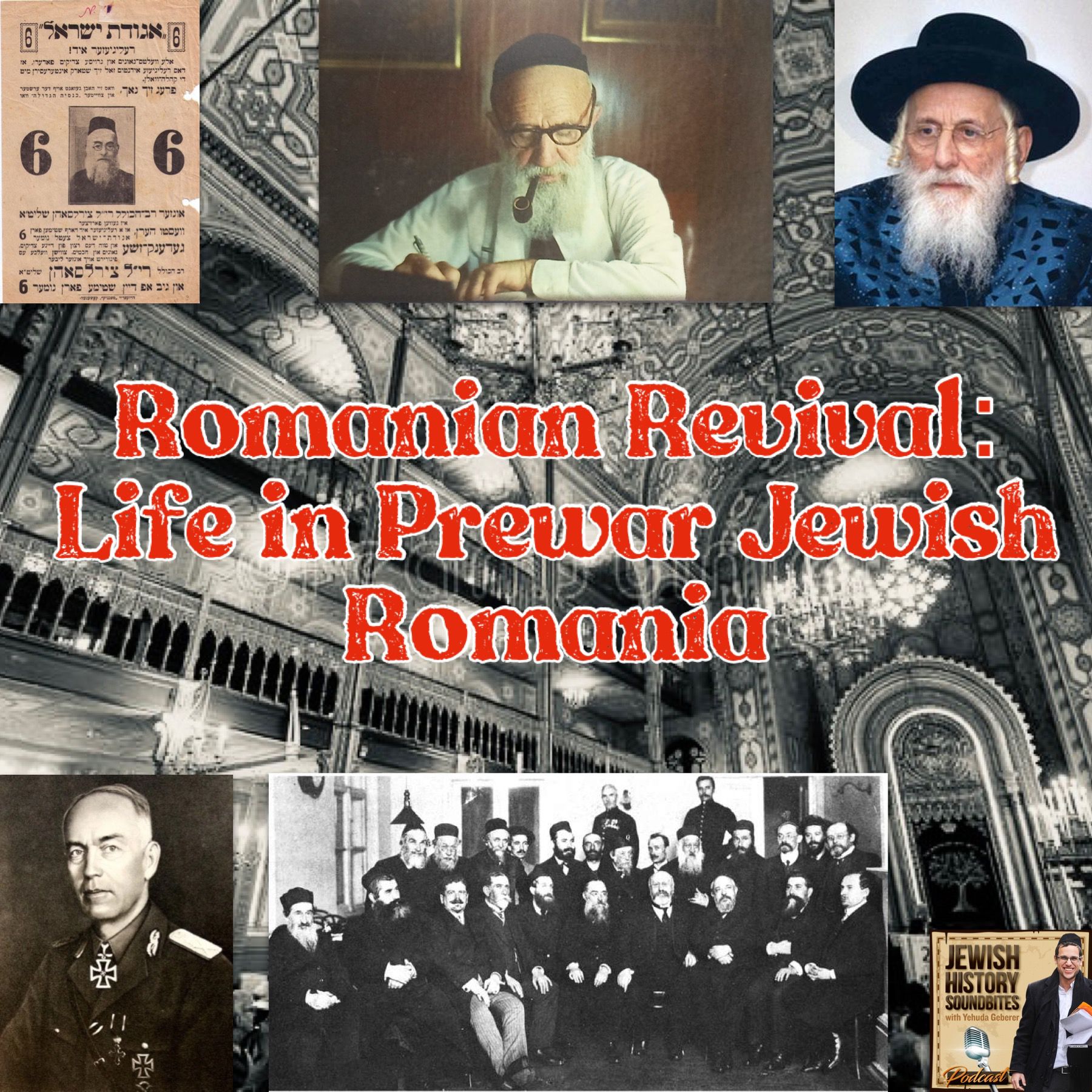 Jewish History SoundbitesRomanian Revival: Interwar Romanian Rabbinical LeadershipRav Yehuda Leib Tzirelson (1859-1941) and his younger compatriot Rabbi Moshe Yosef Rubin (1895-1980), were but two examples of the unique rabbinical leadership enjoyed by the Romanian Jewish community during the tumultuous first half of the 20th century. With the outer districts of Bukovina and Bessarabia being absorbed into the new nationalistic and increasingly anti Semitic Romania, it took courageous leadership to provide an anchor of tradition during that time period.
What made the story even more unique was their leadership in the Romanian Agudas Yisroel organization, while maintaining Zionistic positions on settlement of the Land of Israel a...2021-10-0335 min
Jewish History SoundbitesRomanian Revival: Interwar Romanian Rabbinical LeadershipRav Yehuda Leib Tzirelson (1859-1941) and his younger compatriot Rabbi Moshe Yosef Rubin (1895-1980), were but two examples of the unique rabbinical leadership enjoyed by the Romanian Jewish community during the tumultuous first half of the 20th century. With the outer districts of Bukovina and Bessarabia being absorbed into the new nationalistic and increasingly anti Semitic Romania, it took courageous leadership to provide an anchor of tradition during that time period.
What made the story even more unique was their leadership in the Romanian Agudas Yisroel organization, while maintaining Zionistic positions on settlement of the Land of Israel a...2021-10-0335 min Jewish History SoundbitesSale or No Sale? Shemitah in Modern Times Part IIWith the passing of Rav Yitzchak Elchanan Spektor in 1896, his true opinion of the 'Heter Mechira' which he had authored became a matter of everlasting dispute. In the ensuing shmittah years, other rabbis weighed in on the issue, with some supporting the heter mechira, while others remained opposed.
With the rise of settlements during the Second Aliyah in the early 1900's, as well as the more secular nature of the colonists, the shmittah issue came to the fore again with the upcoming shmittah year of 1910. Rav Yaakov Dovid Wilovsky - the Ridbaz - was the most vocal opponent of the...2021-09-2534 min
Jewish History SoundbitesSale or No Sale? Shemitah in Modern Times Part IIWith the passing of Rav Yitzchak Elchanan Spektor in 1896, his true opinion of the 'Heter Mechira' which he had authored became a matter of everlasting dispute. In the ensuing shmittah years, other rabbis weighed in on the issue, with some supporting the heter mechira, while others remained opposed.
With the rise of settlements during the Second Aliyah in the early 1900's, as well as the more secular nature of the colonists, the shmittah issue came to the fore again with the upcoming shmittah year of 1910. Rav Yaakov Dovid Wilovsky - the Ridbaz - was the most vocal opponent of the...2021-09-2534 min Jewish History SoundbitesLand on Sabbatical: Shemitah in Modern Times Part I
With the onset of the First Aliyah in the 1880's, and the beginnings of Jewish agricultural settlements as a result, the issue of how to observe Shmita came to the fore. Most of the original colonies were funded and managed by Baron Edmund De Rothschild, and he and his managers weren't too keen on having the farmers disengage from agricultural activities for an entire year.
The leaders of the Chovevei Zion movement sought a way to resolve the issue and the original 'Heter Mechira' was formulated. With the tacit support of Rav Yitzchak Elchanan Spektor, the land was sold to a...2021-09-1936 min
Jewish History SoundbitesLand on Sabbatical: Shemitah in Modern Times Part I
With the onset of the First Aliyah in the 1880's, and the beginnings of Jewish agricultural settlements as a result, the issue of how to observe Shmita came to the fore. Most of the original colonies were funded and managed by Baron Edmund De Rothschild, and he and his managers weren't too keen on having the farmers disengage from agricultural activities for an entire year.
The leaders of the Chovevei Zion movement sought a way to resolve the issue and the original 'Heter Mechira' was formulated. With the tacit support of Rav Yitzchak Elchanan Spektor, the land was sold to a...2021-09-1936 min Jewish History SoundbitesThe Chant of Torah: The Life of Rav Naftali TropHaving gained fame as the Radin Yeshiva, as well as immortality through his Torah which is still studied worldwide, Rav Naftali Trop (1871-1928) was an important Torah leader who left an impact on the pre war yeshiva world of Eastern Europe.
A product of Slabodka and Kelm, he brought Talmudic scholarship as well as the mussar movement to his students. Imparting life lessons by personal example, Rav Naftali was a caring individual who took responsibility for others beyond the walls of the yeshiva as well.
Though his untimely passing in his 50's brought an end to a life of teaching...2021-09-0932 min
Jewish History SoundbitesThe Chant of Torah: The Life of Rav Naftali TropHaving gained fame as the Radin Yeshiva, as well as immortality through his Torah which is still studied worldwide, Rav Naftali Trop (1871-1928) was an important Torah leader who left an impact on the pre war yeshiva world of Eastern Europe.
A product of Slabodka and Kelm, he brought Talmudic scholarship as well as the mussar movement to his students. Imparting life lessons by personal example, Rav Naftali was a caring individual who took responsibility for others beyond the walls of the yeshiva as well.
Though his untimely passing in his 50's brought an end to a life of teaching...2021-09-0932 min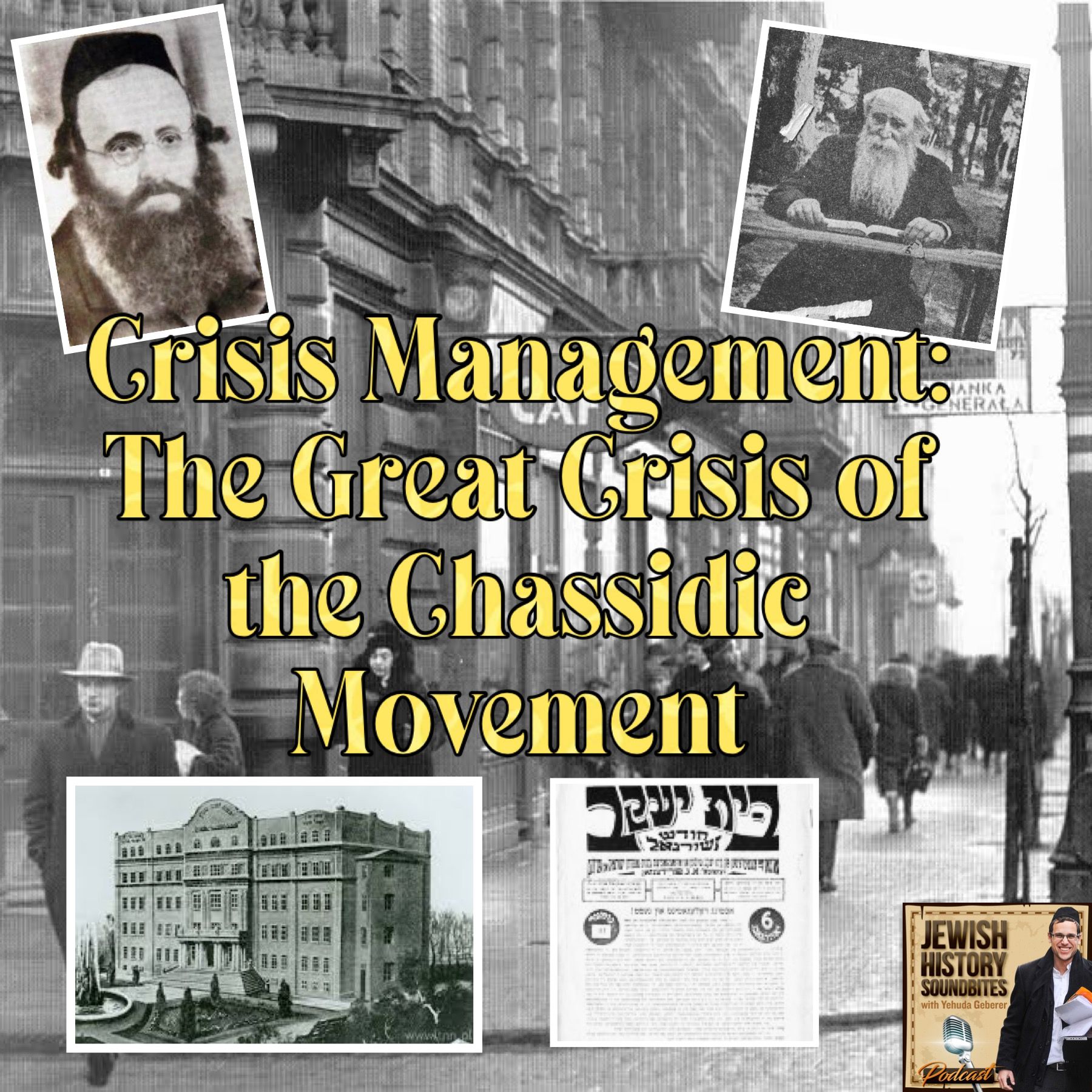 Jewish History SoundbitesCrisis Management: The Great Crisis of the Chassidic MovementModern times brought a host of challenges to the Chassidic movement in the closing decades of the 19th century and intensified in the 20th. World War One and the havoc that it wreaked led to a full blown crisis. Demographically the chassidic movement began to decline in numbers for the first time in its history. Urbanization transformed the chassidic experience and the interaction between the Rebbe and his followers. The Russian Revolution left the chassidic heartland and birthplace of the movement behind the Iron Curtain. Immigration to the west and United States loosened the affiliation of the immigrants to the...2021-09-0338 min
Jewish History SoundbitesCrisis Management: The Great Crisis of the Chassidic MovementModern times brought a host of challenges to the Chassidic movement in the closing decades of the 19th century and intensified in the 20th. World War One and the havoc that it wreaked led to a full blown crisis. Demographically the chassidic movement began to decline in numbers for the first time in its history. Urbanization transformed the chassidic experience and the interaction between the Rebbe and his followers. The Russian Revolution left the chassidic heartland and birthplace of the movement behind the Iron Curtain. Immigration to the west and United States loosened the affiliation of the immigrants to the...2021-09-0338 min Jewish History SoundbitesThe Chofetz Chaim & His Attempts to Move to the Holy Land
Rav Yisrael Meir of Radin, better known as the Chofetz Chaim (1838-1933), is one of the most beloved historical figures in recent memory. His storied life convers many aspects, and in this episode the focus is on the saga of his attempts at immigrating to the Land of Israel.
While yearning to move there for many years, he laid practical plans to carry it out as well. Over the course of a half a century, several attempts were made but none brought to fruition. In 1925 his bags were packed and a home was even purchased for him in Petach Tikvah...2021-09-0132 min
Jewish History SoundbitesThe Chofetz Chaim & His Attempts to Move to the Holy Land
Rav Yisrael Meir of Radin, better known as the Chofetz Chaim (1838-1933), is one of the most beloved historical figures in recent memory. His storied life convers many aspects, and in this episode the focus is on the saga of his attempts at immigrating to the Land of Israel.
While yearning to move there for many years, he laid practical plans to carry it out as well. Over the course of a half a century, several attempts were made but none brought to fruition. In 1925 his bags were packed and a home was even purchased for him in Petach Tikvah...2021-09-0132 min Jewish History SoundbitesOn the Way to Canaan's Land: The Five Aliyot to PalestineKnown to history as the five waves of 'Aliyah', immigration to the Land of Israel, the late 19th and early 20th century saw a slow but steady stream of Jewish immigration which laid the foundations of what later become the State of Israel. These waves of immigration were part of a larger trend of general and specifically Jewish immigration to the west during this time.
The first aliyah was a product of the Chovevei Zion movement and established the first agricultural colonies. The second aliyah was a result of the nascent Zionist movement and beginning of the socialist and nationalistic...2021-08-3036 min
Jewish History SoundbitesOn the Way to Canaan's Land: The Five Aliyot to PalestineKnown to history as the five waves of 'Aliyah', immigration to the Land of Israel, the late 19th and early 20th century saw a slow but steady stream of Jewish immigration which laid the foundations of what later become the State of Israel. These waves of immigration were part of a larger trend of general and specifically Jewish immigration to the west during this time.
The first aliyah was a product of the Chovevei Zion movement and established the first agricultural colonies. The second aliyah was a result of the nascent Zionist movement and beginning of the socialist and nationalistic...2021-08-3036 min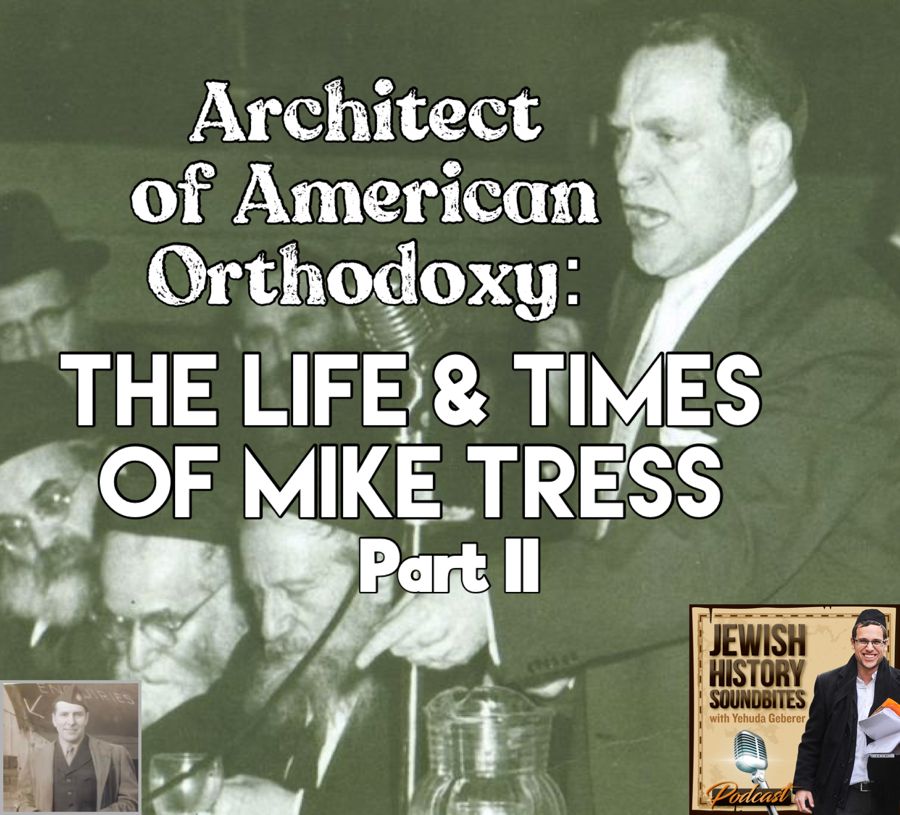 Jewish History SoundbitesArchitect of American Orthodoxy: The Life & Times of Mike Tress Part IIHe was a clean shaven, American born, public school educated, successful businessman. And he was also the architect of American Orthodoxy and a leading rescue activist during the dark years of the Holocaust. Mike Tress (1909-1967) grew up as an orphan in Williamsburg. Joining the nascent Zeirei Agudas Yisroel organization, he soon emerged as its leader, giving it a sense of mission and purpose. Spearheading shabbos campaigns, activating Pirchei and Bnos chapters, and founding Camp Agudah in the midst of a world war and rescue work, are just some of the projects which he initiated to promote Orthodoxy in the...2021-08-2642 min
Jewish History SoundbitesArchitect of American Orthodoxy: The Life & Times of Mike Tress Part IIHe was a clean shaven, American born, public school educated, successful businessman. And he was also the architect of American Orthodoxy and a leading rescue activist during the dark years of the Holocaust. Mike Tress (1909-1967) grew up as an orphan in Williamsburg. Joining the nascent Zeirei Agudas Yisroel organization, he soon emerged as its leader, giving it a sense of mission and purpose. Spearheading shabbos campaigns, activating Pirchei and Bnos chapters, and founding Camp Agudah in the midst of a world war and rescue work, are just some of the projects which he initiated to promote Orthodoxy in the...2021-08-2642 min Jewish History SoundbitesArchitect of American Orthodoxy: The Life & Times of Mike Tress Part IHe was a clean shaven, American born, public school educated, successful businessman. And he was also the architect of American Orthodoxy and a leading rescue activist during the dark years of the Holocaust. Mike Tress (1909-1967) grew up as an orphan in Williamsburg. Joining the nascent Zeirei Agudas Yisroel organization, he soon emerged as its leader, giving it a sense of mission and purpose. Spearheading shabbos campaigns, activating Pirchei and Bnos chapters, and founding Camp Agudah in the midst of a world war and rescue work, are just some of the projects which he initiated to promote Orthodoxy in the...2021-08-2433 min
Jewish History SoundbitesArchitect of American Orthodoxy: The Life & Times of Mike Tress Part IHe was a clean shaven, American born, public school educated, successful businessman. And he was also the architect of American Orthodoxy and a leading rescue activist during the dark years of the Holocaust. Mike Tress (1909-1967) grew up as an orphan in Williamsburg. Joining the nascent Zeirei Agudas Yisroel organization, he soon emerged as its leader, giving it a sense of mission and purpose. Spearheading shabbos campaigns, activating Pirchei and Bnos chapters, and founding Camp Agudah in the midst of a world war and rescue work, are just some of the projects which he initiated to promote Orthodoxy in the...2021-08-2433 min Jewish History SoundbitesA Guiding Light: The Life of the Chazon Ish Part IIRav Avraham Yeshaya Karelitz (1878-1953) known by his magnum opus the Chazon Ish, was indisputably one of the greatest Torah leaders of the 20th century. In this second installment about his life, achievements and influence, the period of his residence in Vilna is examined. During his thirteen years in the 'Jerusalem of Lithuania', he formed a close relationship with Rav Chaim Ozer Grodzinski, who often sought his advice on a myriad of issues. The Chazon Ish also studied with young students, and developed some interesting relationships, most notably with the future noted Yiddish writer Chaim Grade.
In 1933 the Chazon Ish m...2021-08-1937 min
Jewish History SoundbitesA Guiding Light: The Life of the Chazon Ish Part IIRav Avraham Yeshaya Karelitz (1878-1953) known by his magnum opus the Chazon Ish, was indisputably one of the greatest Torah leaders of the 20th century. In this second installment about his life, achievements and influence, the period of his residence in Vilna is examined. During his thirteen years in the 'Jerusalem of Lithuania', he formed a close relationship with Rav Chaim Ozer Grodzinski, who often sought his advice on a myriad of issues. The Chazon Ish also studied with young students, and developed some interesting relationships, most notably with the future noted Yiddish writer Chaim Grade.
In 1933 the Chazon Ish m...2021-08-1937 min Jewish History SoundbitesMussar Makes a Mir DebutThe Mussar Movement was promulgated by Rav Yisrael Salanter in the mid 19th century, as an attempt to bring ethical standards of conduct to the forefront of national consciousness. In the closing decades of the century, Rav Nosson Tzvi Finkel, the Alter of Slabodka, incorporated the ideas of mussar into an educational philosophy which would become part of the curriculum of the great Lithuanian style yeshivos.
In 1907, the Mir Yeshiva decided to associate with the mussar movement and hired its first Mashgiach, Rav Zalman Dolinsky. In the years leading up to World War One, Rav Yerucham Levovitz served...2021-08-1733 min
Jewish History SoundbitesMussar Makes a Mir DebutThe Mussar Movement was promulgated by Rav Yisrael Salanter in the mid 19th century, as an attempt to bring ethical standards of conduct to the forefront of national consciousness. In the closing decades of the century, Rav Nosson Tzvi Finkel, the Alter of Slabodka, incorporated the ideas of mussar into an educational philosophy which would become part of the curriculum of the great Lithuanian style yeshivos.
In 1907, the Mir Yeshiva decided to associate with the mussar movement and hired its first Mashgiach, Rav Zalman Dolinsky. In the years leading up to World War One, Rav Yerucham Levovitz served...2021-08-1733 min Jewish History SoundbitesFrom Cromwell to Montefiore: The Jews of London Part IIFollowing the Edict of Expulsion in 1290, no organized Jewish life existed in England for centuries. Following the Spanish Expulsion in 1492, a few Conversos secretly settled in England under a Christian identity. The official resettlement of Jews in England commenced with the negotiations held between Menashe ben Israel and Oliver Cromwell in the 1650's. Though allowed to unofficially resettle in England, full emancipation wasn't achieved until 1858. Prominent Jews of the 19th century included the Rothschild family, Moses Montefiore and Benjamin Disreali, who though born Jewish, was baptized at the age of 12.
The Sephardic community of London achieved prominence and...2021-08-1336 min
Jewish History SoundbitesFrom Cromwell to Montefiore: The Jews of London Part IIFollowing the Edict of Expulsion in 1290, no organized Jewish life existed in England for centuries. Following the Spanish Expulsion in 1492, a few Conversos secretly settled in England under a Christian identity. The official resettlement of Jews in England commenced with the negotiations held between Menashe ben Israel and Oliver Cromwell in the 1650's. Though allowed to unofficially resettle in England, full emancipation wasn't achieved until 1858. Prominent Jews of the 19th century included the Rothschild family, Moses Montefiore and Benjamin Disreali, who though born Jewish, was baptized at the age of 12.
The Sephardic community of London achieved prominence and...2021-08-1336 min Jewish History SoundbitesA Moroccan Legacy: Rav Yitzchak Ibn WalidOne of the greatest leaders of the Moroccan Jewish community in the 19th century was Rav Yitzchak Ibn Walid (1777-1870). The Jewish community of Tetuan was founded by Spanish exiles and saw commercial success over the coming centuries.
Despite his reluctance to assume a rabbinical position, Rav Ibn Walid was appointed rabbi of Tetuan in 1830 and led the community until his passing four decades later. As a noted halachic posek he corresponded with rabbis across the Sephardic world, much of it published in his magnum opus Vayomer Yitzchak. As a leader of his community, he cared especially for the poor, t...2021-08-0636 min
Jewish History SoundbitesA Moroccan Legacy: Rav Yitzchak Ibn WalidOne of the greatest leaders of the Moroccan Jewish community in the 19th century was Rav Yitzchak Ibn Walid (1777-1870). The Jewish community of Tetuan was founded by Spanish exiles and saw commercial success over the coming centuries.
Despite his reluctance to assume a rabbinical position, Rav Ibn Walid was appointed rabbi of Tetuan in 1830 and led the community until his passing four decades later. As a noted halachic posek he corresponded with rabbis across the Sephardic world, much of it published in his magnum opus Vayomer Yitzchak. As a leader of his community, he cared especially for the poor, t...2021-08-0636 min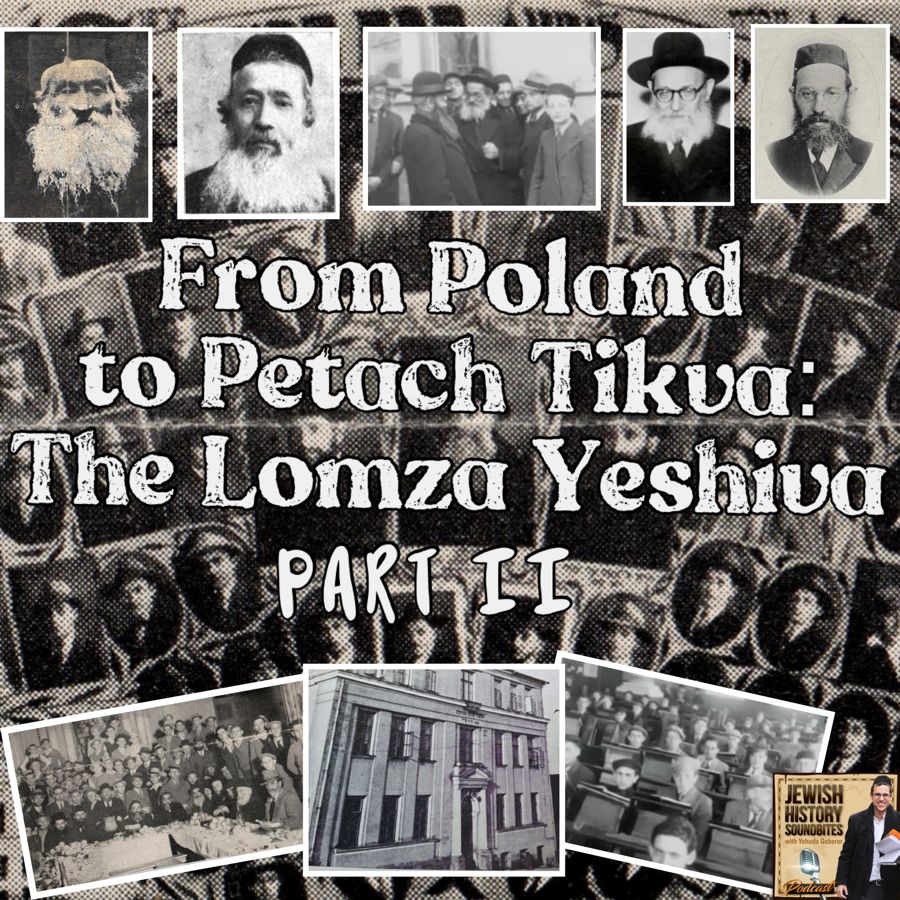 Jewish History SoundbitesFrom Poland to Petach Tikva: The Lomza Yeshiva Part II
The Lomza Yeshiva in Poland and later in Petach Tikva, Israel, was unique in many respects. Founded in 1883 by a student of Rav Yisrael Salanter named Rav Eliezer Shulevitz, it was the first Lithuanian style yeshiva in the area of chassidic Poland. In its heyday, the majority of its students would come from chassidic backgrounds.
With its expansion, his capable sons in law took over - Rav Yechiel Mordechai Gordon, Rav Yehoshua Zelig Roch and Rav Moshe Leib Ozer. The latter's son Rav Eliezer Ozer, ran the Kollel in Lomza Petach Tikva until his recent passing.
The famed mashgiach Rav...2021-08-0127 min
Jewish History SoundbitesFrom Poland to Petach Tikva: The Lomza Yeshiva Part II
The Lomza Yeshiva in Poland and later in Petach Tikva, Israel, was unique in many respects. Founded in 1883 by a student of Rav Yisrael Salanter named Rav Eliezer Shulevitz, it was the first Lithuanian style yeshiva in the area of chassidic Poland. In its heyday, the majority of its students would come from chassidic backgrounds.
With its expansion, his capable sons in law took over - Rav Yechiel Mordechai Gordon, Rav Yehoshua Zelig Roch and Rav Moshe Leib Ozer. The latter's son Rav Eliezer Ozer, ran the Kollel in Lomza Petach Tikva until his recent passing.
The famed mashgiach Rav...2021-08-0127 min Jewish History SoundbitesFrom Poland to Petach Tikva: The Lomza Yeshiva Part IThe Lomza Yeshiva in Poland and later in Petach Tikva, Israel, was unique in many respects. Founded in 1883 by a student of Rav Yisrael Salanter named Rav Eliezer Shulevitz, it was the first Lithuanian style yeshiva in the area of chassidic Poland. In its heyday, the majority of its students would come from chassidic backgrounds.
With its expansion, his capable sons in law took over - Rav Yechiel Mordechai Gordon, Rav Yehoshua Zelig Roch and Rav Moshe Leib Ozer. The latter's son Rav Eliezer Ozer, ran the Kollel in Lomza Petach Tikva until his recent passing.
The famed mashgiach Rav...2021-07-2828 min
Jewish History SoundbitesFrom Poland to Petach Tikva: The Lomza Yeshiva Part IThe Lomza Yeshiva in Poland and later in Petach Tikva, Israel, was unique in many respects. Founded in 1883 by a student of Rav Yisrael Salanter named Rav Eliezer Shulevitz, it was the first Lithuanian style yeshiva in the area of chassidic Poland. In its heyday, the majority of its students would come from chassidic backgrounds.
With its expansion, his capable sons in law took over - Rav Yechiel Mordechai Gordon, Rav Yehoshua Zelig Roch and Rav Moshe Leib Ozer. The latter's son Rav Eliezer Ozer, ran the Kollel in Lomza Petach Tikva until his recent passing.
The famed mashgiach Rav...2021-07-2828 min Jewish History SoundbitesLeader Among Peers: Rav Chaim Ozer Grodzinski at Rabbinical Conferences
Rav Chaim Ozer Grodzinski (1863-1940) was one of the greatest rabbinic leaders of the 20th century. A recent book by Rabbi Dovid Kamenetsky profiles some of the aspects of his leadership of Russian and world Jewry through the first decade of the century. One of the highlighted facets of his activities is his dominant role in various rabbinical conferences between the years 1907-1910.
There was the attempt to establish the Knesses Yisrael organization, which was the first ever attempt at the organization of traditional Jewry in Russia. Then there was the Vilna conference of 1909, which was a preliminary meeting to the r...2021-07-2537 min
Jewish History SoundbitesLeader Among Peers: Rav Chaim Ozer Grodzinski at Rabbinical Conferences
Rav Chaim Ozer Grodzinski (1863-1940) was one of the greatest rabbinic leaders of the 20th century. A recent book by Rabbi Dovid Kamenetsky profiles some of the aspects of his leadership of Russian and world Jewry through the first decade of the century. One of the highlighted facets of his activities is his dominant role in various rabbinical conferences between the years 1907-1910.
There was the attempt to establish the Knesses Yisrael organization, which was the first ever attempt at the organization of traditional Jewry in Russia. Then there was the Vilna conference of 1909, which was a preliminary meeting to the r...2021-07-2537 min Jewish History SoundbitesIn the City of Death: The 1903 Kishinev PogromSpecial Tisha Ba'av Episode
The 1903 Kishinev Pogrom was a tragic massacre, with reverberations within the wider Jewish world remaining until this very day. Goaded on by anti-Semitic newspapers with cries of 'Death to the Jews', a blood libel was fabricated and a mob was unleashed on Easter Sunday, April 19, 1903. Leaving 49 killed, hundreds maimed and injured in its wake, Jewish property was destroyed and looted as well. Claims of complicity of the police and government were voiced in many quarters.
But it was primarily the after effects of this pogrom which had a long term transformative effect on Jewish society in Ru...2021-07-1841 min
Jewish History SoundbitesIn the City of Death: The 1903 Kishinev PogromSpecial Tisha Ba'av Episode
The 1903 Kishinev Pogrom was a tragic massacre, with reverberations within the wider Jewish world remaining until this very day. Goaded on by anti-Semitic newspapers with cries of 'Death to the Jews', a blood libel was fabricated and a mob was unleashed on Easter Sunday, April 19, 1903. Leaving 49 killed, hundreds maimed and injured in its wake, Jewish property was destroyed and looted as well. Claims of complicity of the police and government were voiced in many quarters.
But it was primarily the after effects of this pogrom which had a long term transformative effect on Jewish society in Ru...2021-07-1841 min Jewish History SoundbitesFrom Brisk to Beitar: The Life of Menachem Begin Part IOne of the most influential leaders in the history of the State of Israel, Menachem Begin (1913-1992) led a very colorful life and career. Though known for his public persona, he was a very complex character who faced many setbacks at every stage. Growing up in a somewhat traditional home in Brisk, he later joined the Beitar movement of Revisionist Zionism led by Vladimir (Zev) Jabotinsky.
Arrested by the Soviets in the early part of the war, he was sentenced to slave labor in Siberia. In the interim, the Holocaust arrived in Brisk, and most of his family...2021-07-1538 min
Jewish History SoundbitesFrom Brisk to Beitar: The Life of Menachem Begin Part IOne of the most influential leaders in the history of the State of Israel, Menachem Begin (1913-1992) led a very colorful life and career. Though known for his public persona, he was a very complex character who faced many setbacks at every stage. Growing up in a somewhat traditional home in Brisk, he later joined the Beitar movement of Revisionist Zionism led by Vladimir (Zev) Jabotinsky.
Arrested by the Soviets in the early part of the war, he was sentenced to slave labor in Siberia. In the interim, the Holocaust arrived in Brisk, and most of his family...2021-07-1538 min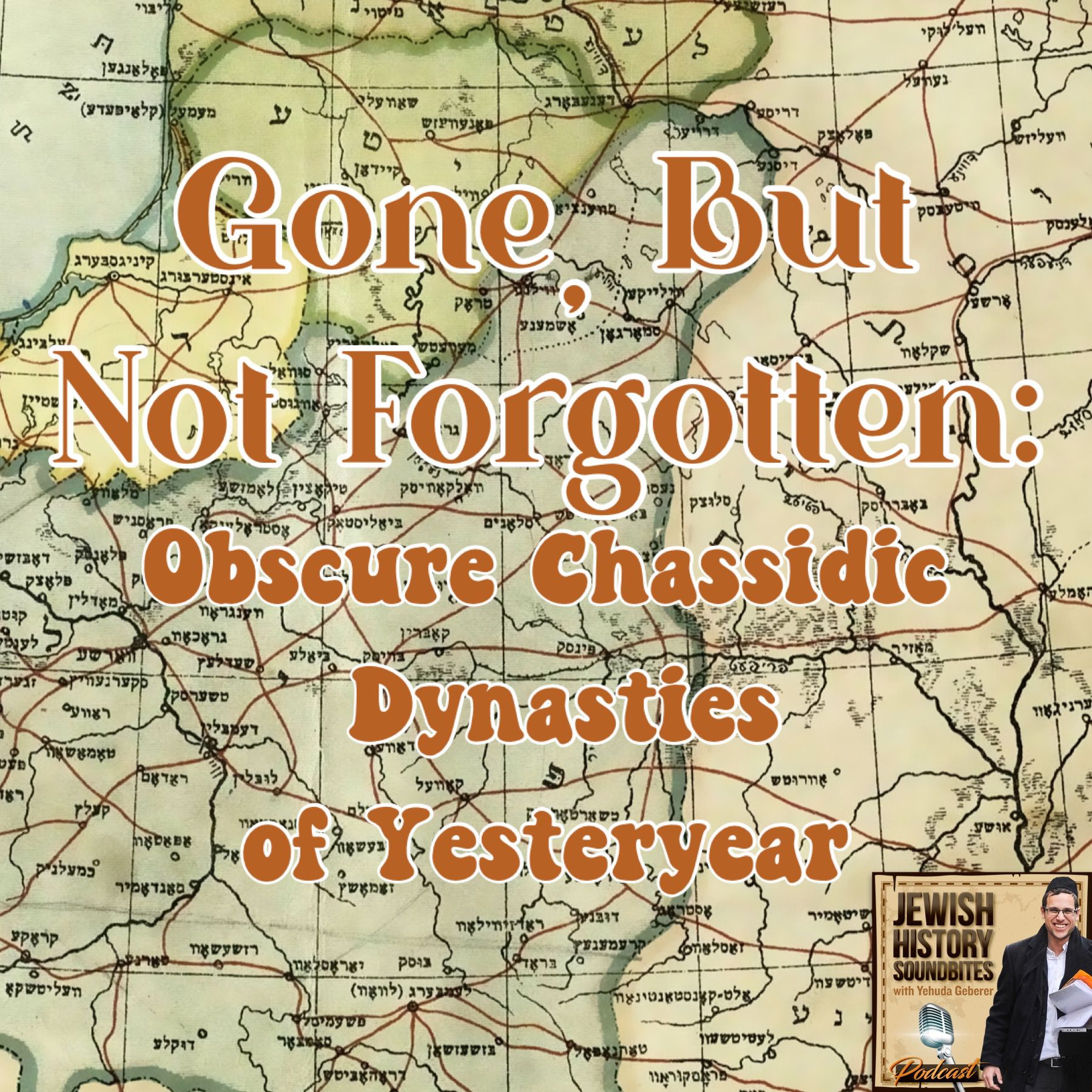 Jewish History SoundbitesGone, but not Forgotten: Obscure Chassidic Dynasties of YesteryearSmaller and lesser known Chassidic dynasties are almost entirely forgotten, as a result of their being almost entirely wiped out during the Holocaust. Each one had a following with a demographic and geographical reach and impact during centuries of their existence. And each one is a story.
The Ungar family of the Dombrova dynasty, Shpikov was a branch of Skver, large ones like Melitz, Alexander and Radomsk are more obscure today as well. Some were large, some very small, some influential, while others made less of an impact. But each and every one formed a component of eastern European Chassidic...2021-07-1132 min
Jewish History SoundbitesGone, but not Forgotten: Obscure Chassidic Dynasties of YesteryearSmaller and lesser known Chassidic dynasties are almost entirely forgotten, as a result of their being almost entirely wiped out during the Holocaust. Each one had a following with a demographic and geographical reach and impact during centuries of their existence. And each one is a story.
The Ungar family of the Dombrova dynasty, Shpikov was a branch of Skver, large ones like Melitz, Alexander and Radomsk are more obscure today as well. Some were large, some very small, some influential, while others made less of an impact. But each and every one formed a component of eastern European Chassidic...2021-07-1132 min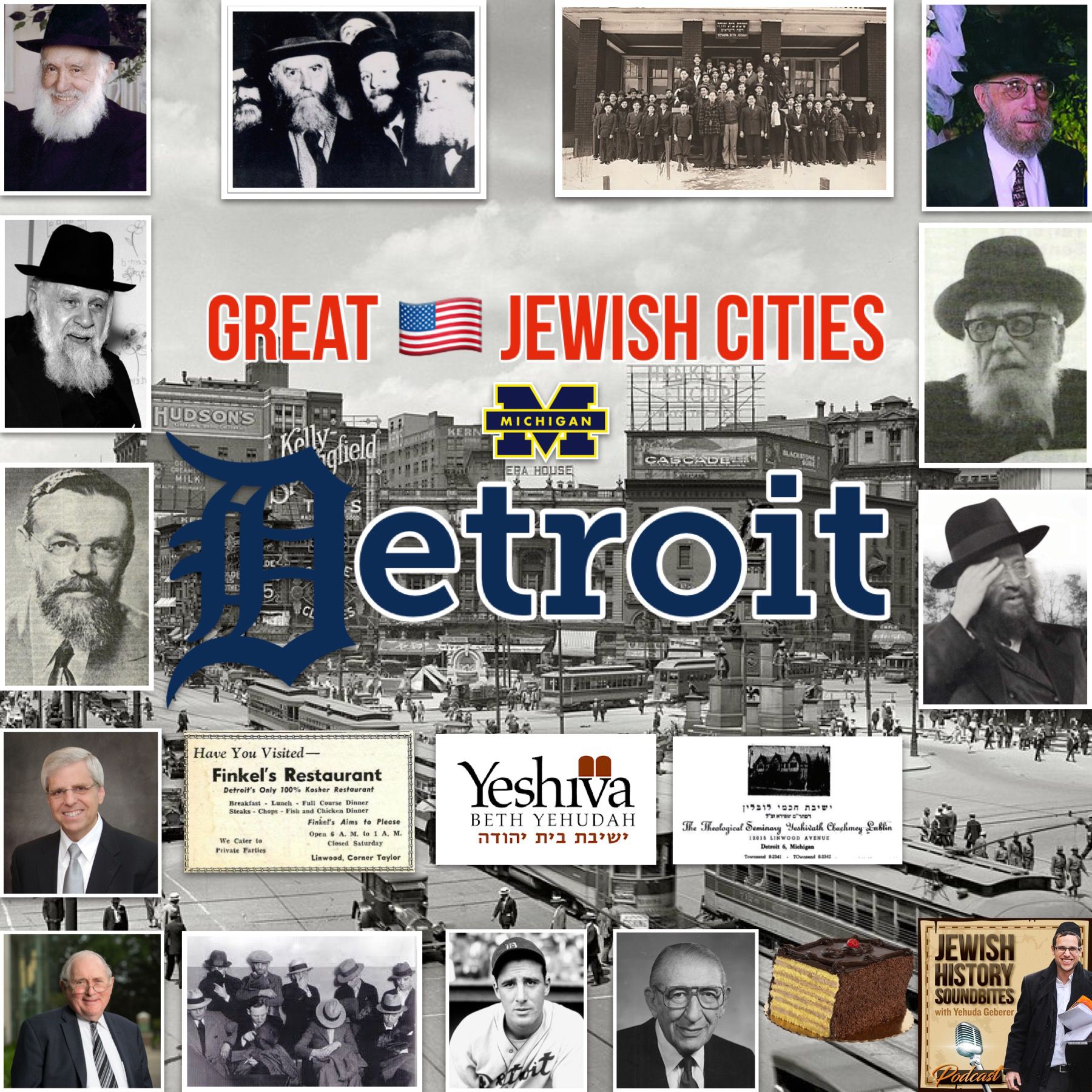 Jewish History SoundbitesGreat American Jewish Cities #22: Detroit Part IThe rich Jewish history of the Motor City includes many fascinating institutions and individuals. From the early farming settlements in Michigan, to the immigrant communities of Detroit proper, this part one of a series on Detroit Jewish history will examine some of the personalities and their impact on the developing community.
There was the interesting experiment of Yeshivas Chachmei Lublin of Detroit, which hosted one of the first Siyum Hashas celebrations in the United States. Rav Yehuda Leib Levin was an early rabbi who founded what was to become the Beth Yehuda school, eventually named for him. With the arrival...2021-07-0637 min
Jewish History SoundbitesGreat American Jewish Cities #22: Detroit Part IThe rich Jewish history of the Motor City includes many fascinating institutions and individuals. From the early farming settlements in Michigan, to the immigrant communities of Detroit proper, this part one of a series on Detroit Jewish history will examine some of the personalities and their impact on the developing community.
There was the interesting experiment of Yeshivas Chachmei Lublin of Detroit, which hosted one of the first Siyum Hashas celebrations in the United States. Rav Yehuda Leib Levin was an early rabbi who founded what was to become the Beth Yehuda school, eventually named for him. With the arrival...2021-07-0637 min Jewish History SoundbitesJustice for All: The Incredible Story of Jacob RobinsonA relatively unknown, yet one of the most influential Jews of the 20th century, Jacob Robinson's (1889-1977) list of accomplishments are seemingly endless. After receiving his doctorate in law, he was drafted into the Czarist military with the outbreak of World War One. After spending three years in a German POW camp, he returned to the newly created independent Lithuania, where he emerged as a leading Zionist, politician, jurist, educator, writer and much more.
First representing Jewish interests in the Lithuanian parliament, he soon reached the international stage, arguing for minorities rights in international platforms such as the...2021-07-0232 min
Jewish History SoundbitesJustice for All: The Incredible Story of Jacob RobinsonA relatively unknown, yet one of the most influential Jews of the 20th century, Jacob Robinson's (1889-1977) list of accomplishments are seemingly endless. After receiving his doctorate in law, he was drafted into the Czarist military with the outbreak of World War One. After spending three years in a German POW camp, he returned to the newly created independent Lithuania, where he emerged as a leading Zionist, politician, jurist, educator, writer and much more.
First representing Jewish interests in the Lithuanian parliament, he soon reached the international stage, arguing for minorities rights in international platforms such as the...2021-07-0232 min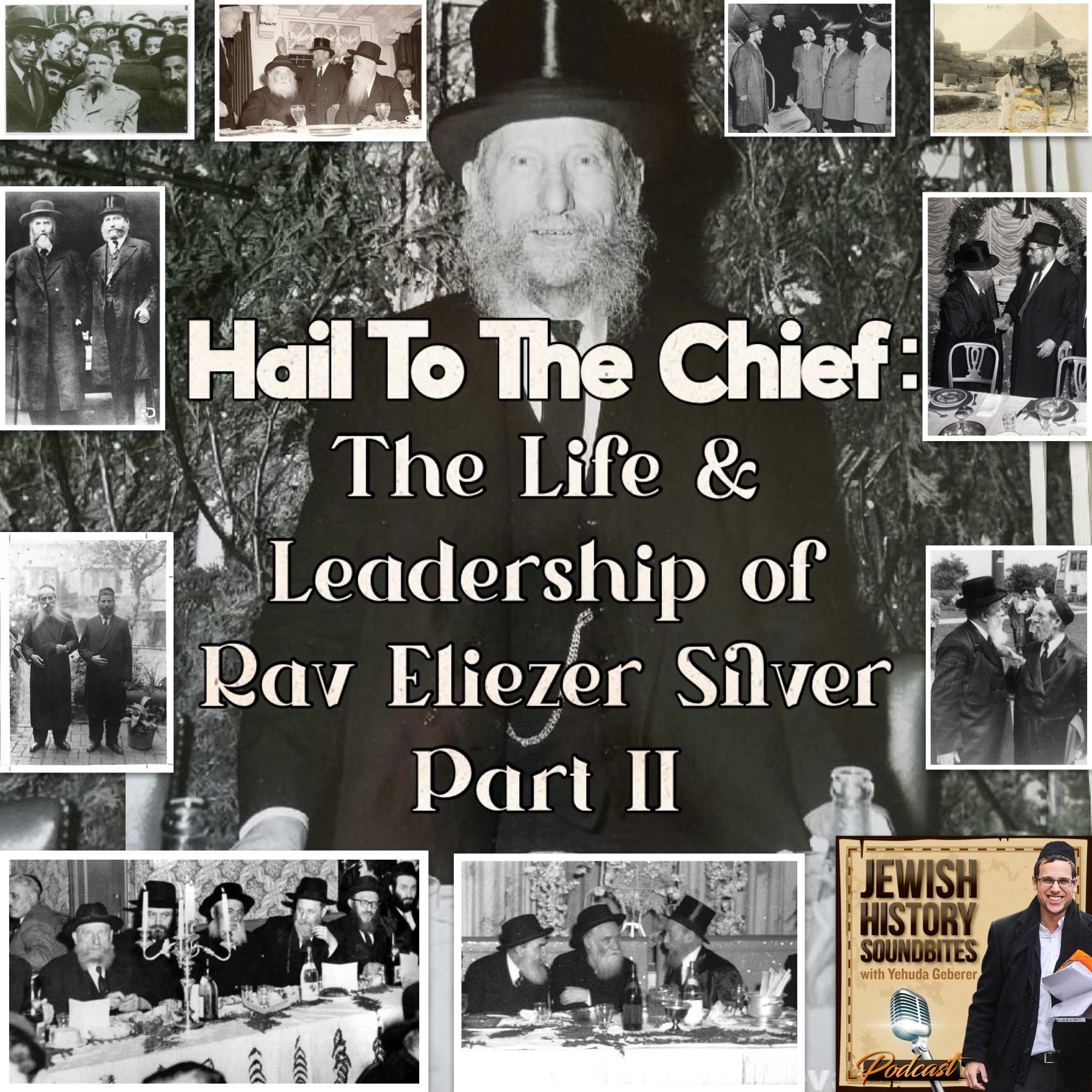 Jewish History SoundbitesHail to the Chief: The Life & Leadership of Rav Eliezer Silver Part IIIn this second installment on the incredible life and accomplishments of Rav Eliezer Silver (1886-1968), his rise in the rabbinic leadership in the United States is traced from his meeting with President Taft to his being in stranded in Europe during World War One, which led to the founding of Ezras Torah.
One of the most active chapters of his activism was his founding of the Vaad Hatzalah and his myriad rescue efforts during the years of World War Two and the Holocaust. Rav Leizer Silver founded this rescue organization in November 1939 as a means of supporting refugee students in...2021-06-2742 min
Jewish History SoundbitesHail to the Chief: The Life & Leadership of Rav Eliezer Silver Part IIIn this second installment on the incredible life and accomplishments of Rav Eliezer Silver (1886-1968), his rise in the rabbinic leadership in the United States is traced from his meeting with President Taft to his being in stranded in Europe during World War One, which led to the founding of Ezras Torah.
One of the most active chapters of his activism was his founding of the Vaad Hatzalah and his myriad rescue efforts during the years of World War Two and the Holocaust. Rav Leizer Silver founded this rescue organization in November 1939 as a means of supporting refugee students in...2021-06-2742 min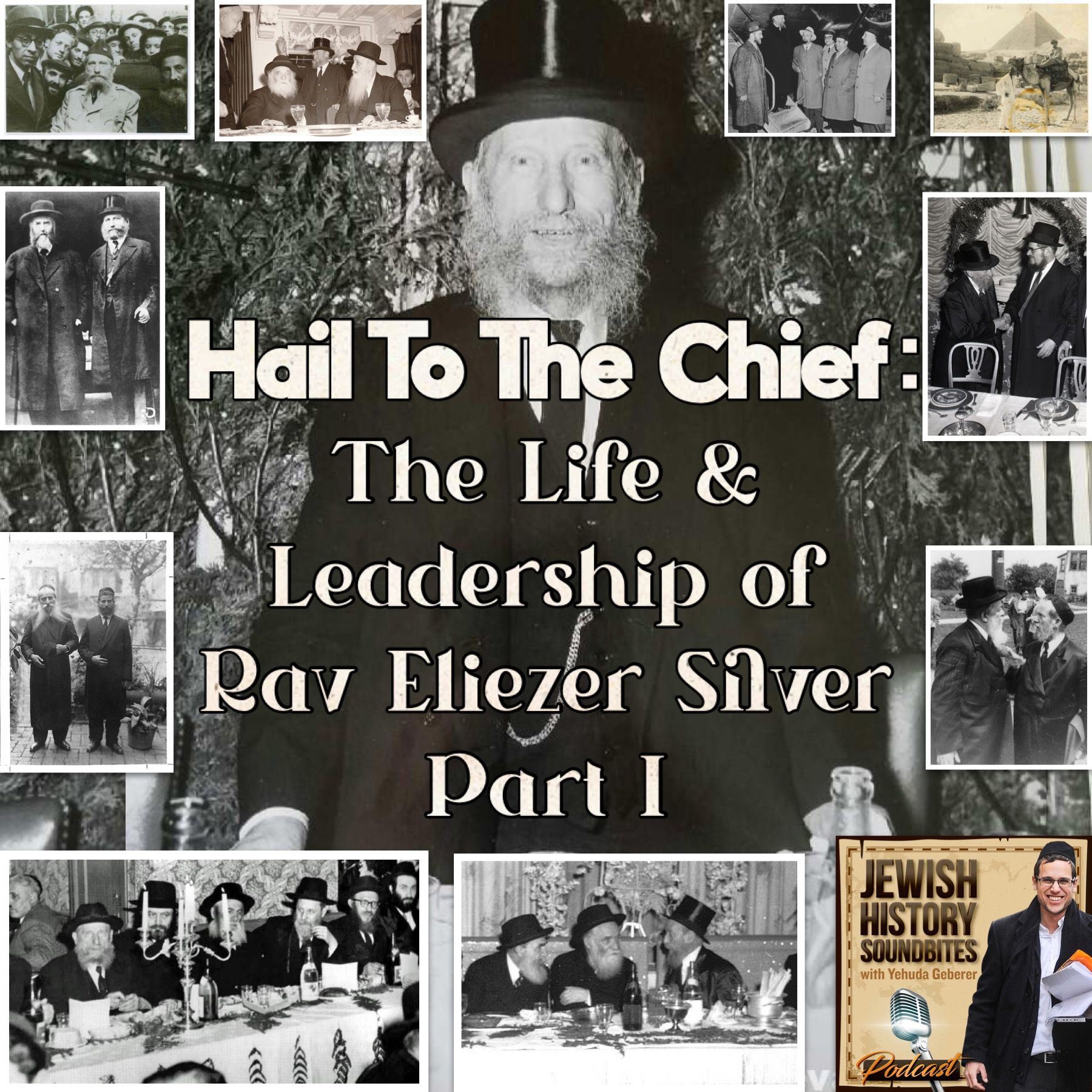 Jewish History SoundbitesHail to the Chief: The Life & Leadership of Rav Eliezer Silver Part IOne of the architects or American Orthodoxy and perhaps the greatest Orthodox rabbinical leader in that country of the 20th century, Rav Eliezer Silver (1886-1968) had a decisive impact on Jewish life. Through his communal rabbinical leadership, his national leadership on the American scene, through the organizations which he spearheaded and ran for decades, and of course his myriad efforts on behalf of Eastern European Jewry.
Having studied under Rav Chaim Ozer Grodzinski in Vilna, Rav Yosef Rosen the Rogatchover in Dvinsk and Rav Chaim Brisker in Brisk, he then immigrated to the United States at the peak of the...2021-06-2238 min
Jewish History SoundbitesHail to the Chief: The Life & Leadership of Rav Eliezer Silver Part IOne of the architects or American Orthodoxy and perhaps the greatest Orthodox rabbinical leader in that country of the 20th century, Rav Eliezer Silver (1886-1968) had a decisive impact on Jewish life. Through his communal rabbinical leadership, his national leadership on the American scene, through the organizations which he spearheaded and ran for decades, and of course his myriad efforts on behalf of Eastern European Jewry.
Having studied under Rav Chaim Ozer Grodzinski in Vilna, Rav Yosef Rosen the Rogatchover in Dvinsk and Rav Chaim Brisker in Brisk, he then immigrated to the United States at the peak of the...2021-06-2238 min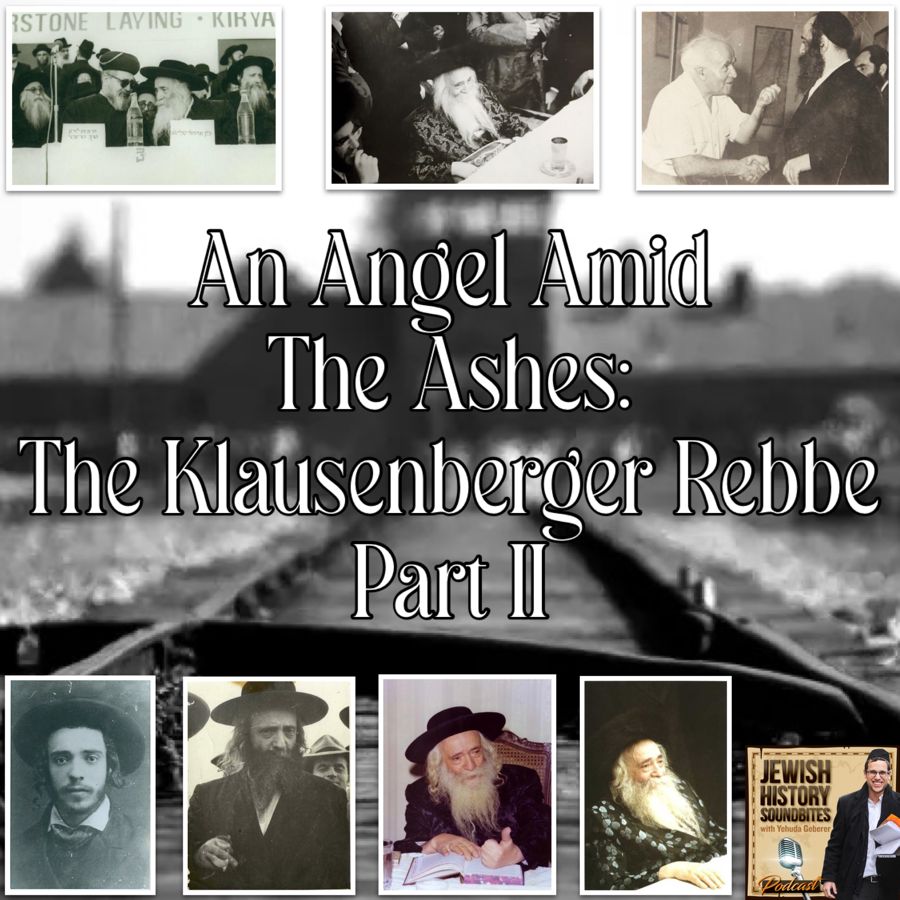 Jewish History SoundbitesAn Angel Amid the Ashes: The Klausenberger Rebbe Part II
In honor of the yahrtzeit of Rav Yekusiel Yehuda Halberstam, the Sanz-Klausenburg Rebbe (1905-1994), another chapter in his storied life is presented, as his charismatic leadership and Torah greatness is examined in greater detail.
Having emerged from the horrors of the Holocaust while losing his entire family and community, he set out to rebuild while strongly maintaining the independence of his own community. Building institutions and teaching Torah, he assumed roles which were atypical of a standard chassidic leader. His leading an independent stance ons many issues brought him occasionally into dispute with other Torah leaders, but he maintained his p...2021-06-2043 min
Jewish History SoundbitesAn Angel Amid the Ashes: The Klausenberger Rebbe Part II
In honor of the yahrtzeit of Rav Yekusiel Yehuda Halberstam, the Sanz-Klausenburg Rebbe (1905-1994), another chapter in his storied life is presented, as his charismatic leadership and Torah greatness is examined in greater detail.
Having emerged from the horrors of the Holocaust while losing his entire family and community, he set out to rebuild while strongly maintaining the independence of his own community. Building institutions and teaching Torah, he assumed roles which were atypical of a standard chassidic leader. His leading an independent stance ons many issues brought him occasionally into dispute with other Torah leaders, but he maintained his p...2021-06-2043 min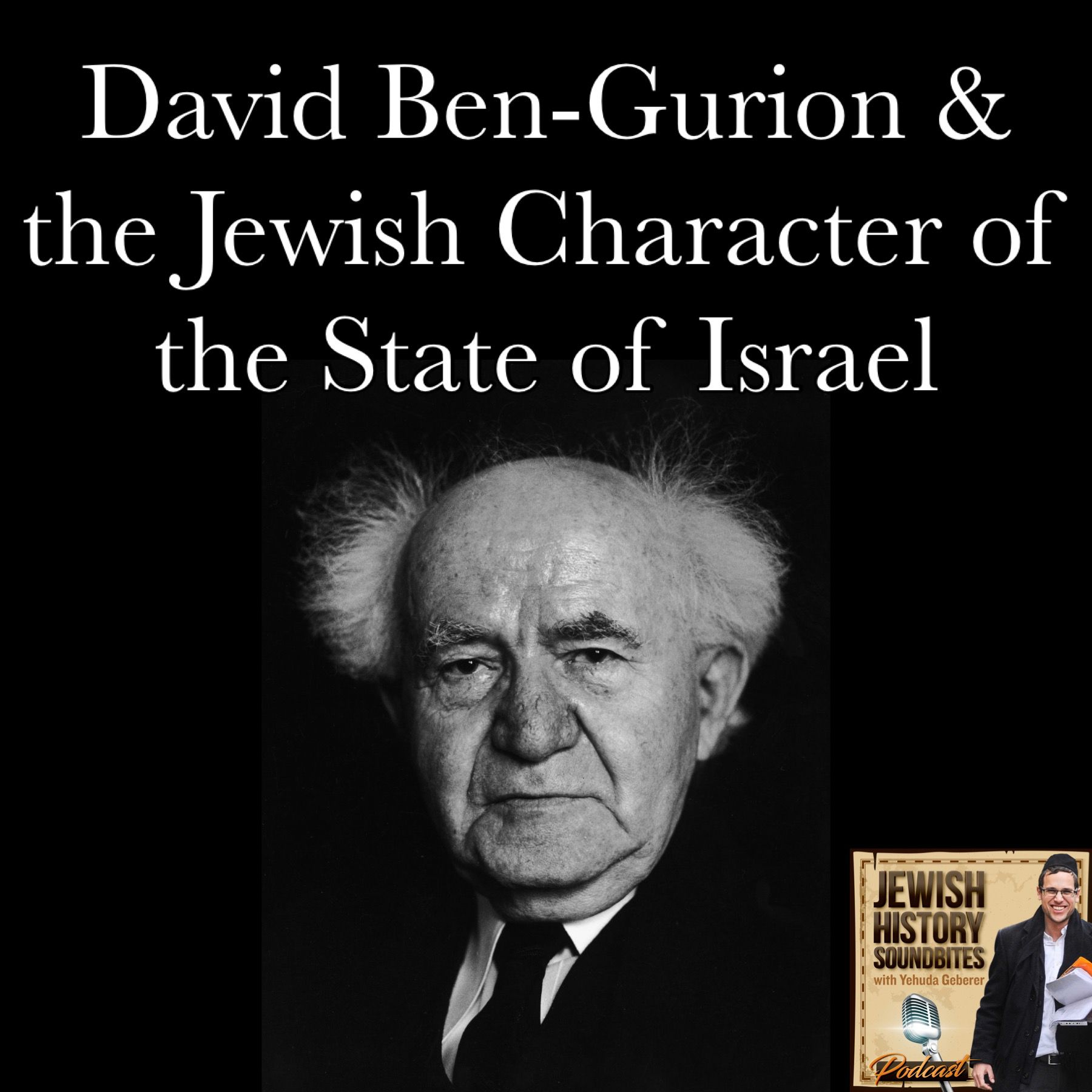 Jewish History SoundbitesDavid Ben-Gurion & the Jewish Character of the State of IsraelConsidered by many as the founding father of the State of Israel, David Ben-Gurion (1886-1973) had a unique vision of the Jewish character of the Jewish state. With an antagonism towards religious practice and his negative view of the 'diaspora Jew', he also had a sense of realpolitik and understood the practical gains of reaching a status quo agreement. On October 20, 1952 he paid a visit to Israel's most venerable sage, Rav Avraham Yeshaya Karelitz, the Chazon Ish.
Though thoroughly secular himself, he had a strong love for Tanach. And though he wouldn't set foot into a synagogue in...2021-06-1836 min
Jewish History SoundbitesDavid Ben-Gurion & the Jewish Character of the State of IsraelConsidered by many as the founding father of the State of Israel, David Ben-Gurion (1886-1973) had a unique vision of the Jewish character of the Jewish state. With an antagonism towards religious practice and his negative view of the 'diaspora Jew', he also had a sense of realpolitik and understood the practical gains of reaching a status quo agreement. On October 20, 1952 he paid a visit to Israel's most venerable sage, Rav Avraham Yeshaya Karelitz, the Chazon Ish.
Though thoroughly secular himself, he had a strong love for Tanach. And though he wouldn't set foot into a synagogue in...2021-06-1836 min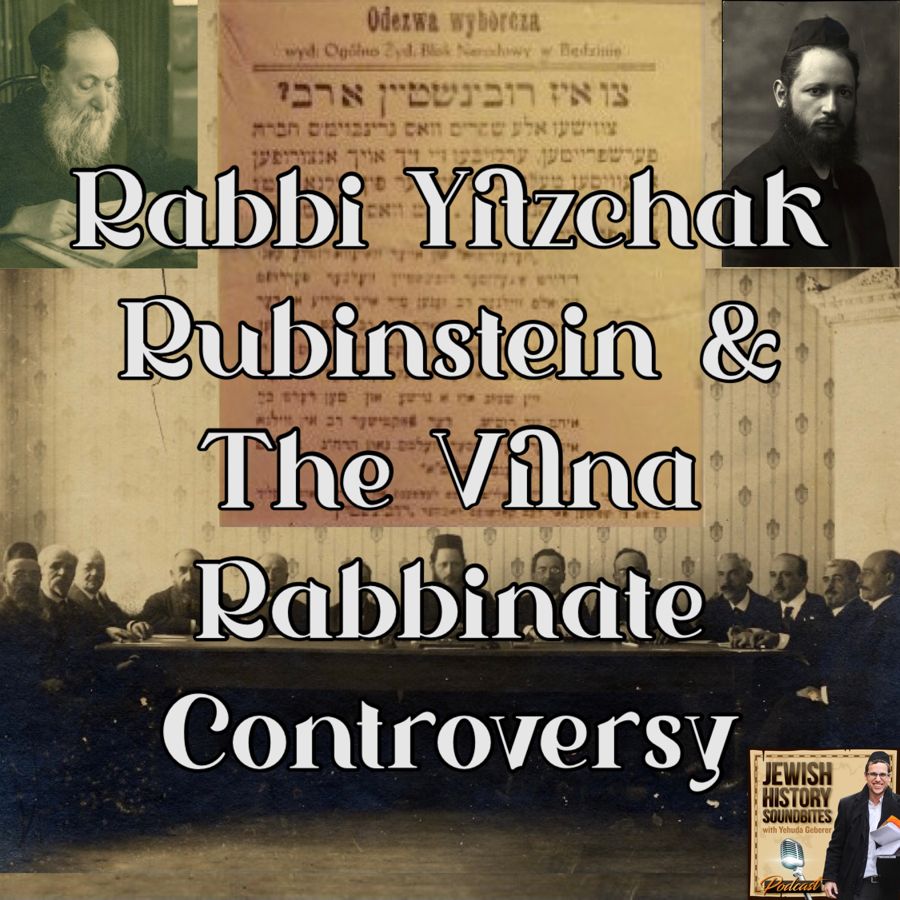 Jewish History SoundbitesRabbi Yitzchak Rubinstein & The Vilna Rabbinate ControversyThough Vilna was known as the Jerusalem of Lithuania, it hadn't had an official chief rabbi since a dispute about the position ended in 1791. As a result of the Polish government requiring the hiring of chief rabbi in the 1920's, the Vilna Jewish community council hired Rav Yitzchak Rubinstein (1880-1945) as the official chief rabbi of the city. He had served as the official 'Rav Mitaam' government rabbi since 1910, and was beloved by the community to his leadership and activism during the First World War.
This appointment was made despite the fact that Rav Chaim Ozer Grodzinski was...2021-06-1131 min
Jewish History SoundbitesRabbi Yitzchak Rubinstein & The Vilna Rabbinate ControversyThough Vilna was known as the Jerusalem of Lithuania, it hadn't had an official chief rabbi since a dispute about the position ended in 1791. As a result of the Polish government requiring the hiring of chief rabbi in the 1920's, the Vilna Jewish community council hired Rav Yitzchak Rubinstein (1880-1945) as the official chief rabbi of the city. He had served as the official 'Rav Mitaam' government rabbi since 1910, and was beloved by the community to his leadership and activism during the First World War.
This appointment was made despite the fact that Rav Chaim Ozer Grodzinski was...2021-06-1131 min Jewish History SoundbitesThe Great Defender of Israel: Rav Levi Yitzchak of BerditchevOne of the most legendary leaders the Chassidic movement has ever produced Rav Levi Yitzchak of Berditchev (1740-1809) is a universally beloved figure as well. Following his conversion to the nascent movement in the court of the Maggid of Mezritch, he spread the ideas of chassidus while simultaneously leading a lucrative rabbinic career in Zelichov, Pinsk and Berditchev.
Known to posterity as the Great Defender of the Jewish People, he devoted his life to seeking out the good in every individual as well as the Jewish People as a collective.
For sponsorship opportunities about your favorite topics of...2021-06-0732 min
Jewish History SoundbitesThe Great Defender of Israel: Rav Levi Yitzchak of BerditchevOne of the most legendary leaders the Chassidic movement has ever produced Rav Levi Yitzchak of Berditchev (1740-1809) is a universally beloved figure as well. Following his conversion to the nascent movement in the court of the Maggid of Mezritch, he spread the ideas of chassidus while simultaneously leading a lucrative rabbinic career in Zelichov, Pinsk and Berditchev.
Known to posterity as the Great Defender of the Jewish People, he devoted his life to seeking out the good in every individual as well as the Jewish People as a collective.
For sponsorship opportunities about your favorite topics of...2021-06-0732 min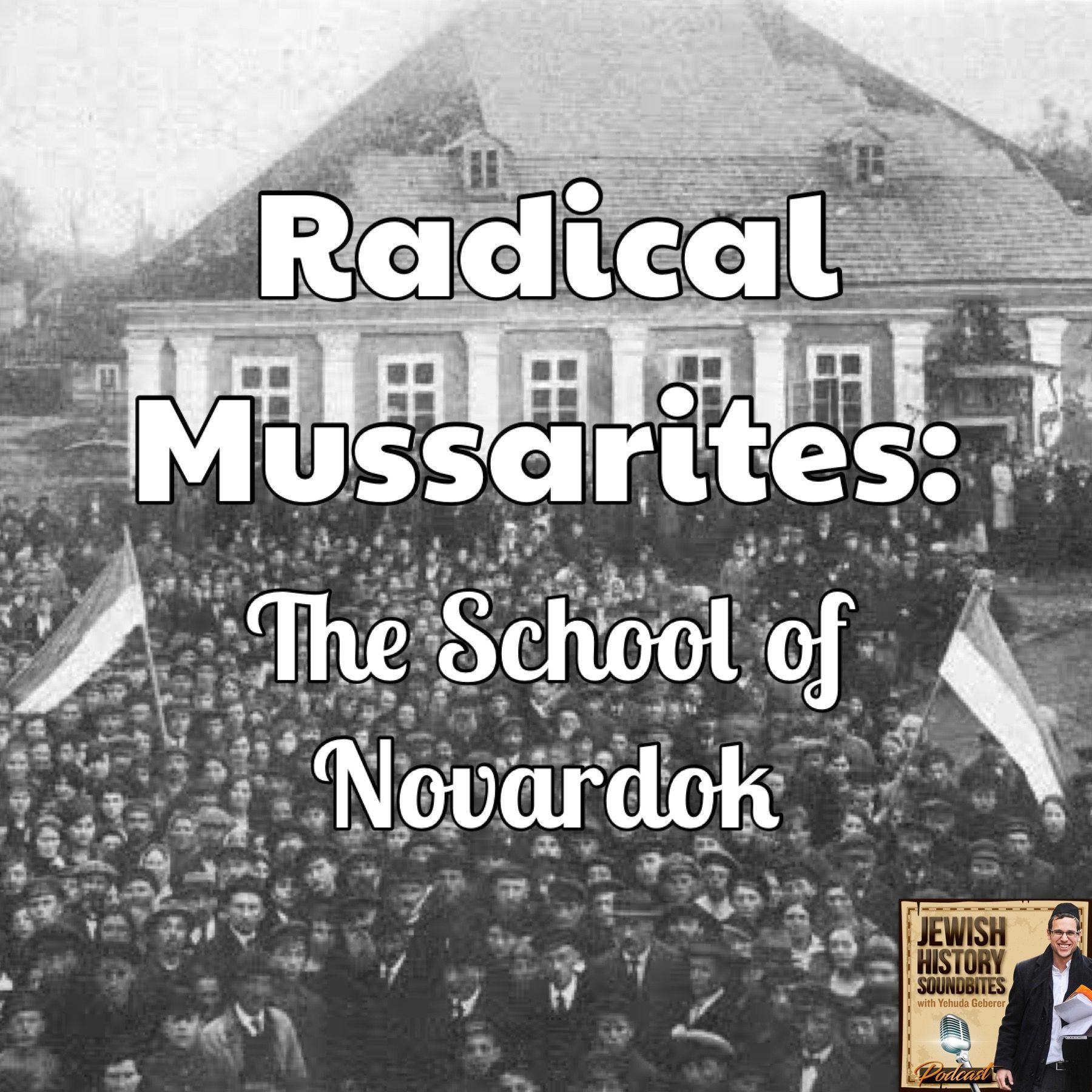 Jewish History SoundbitesRadical Mussarites: The School of NovardokThe Novardok Yeshiva was both a mussar philosophy as well as a movement. Founded by Rav Yosef Yoizel Horowitz (1850-1919), the Alter of Novardok, in 1896, it soon grew into tens of branches across Russia. Known for its rather radical approach to mussar, educational philosophy and growth, it was seemingly influenced by the general revolutionary zeitgeist in the Russian Empire at the turn of the century.
Exiled during World War One, the entire movement would eventually make a daring border crossing into Poland in order to escape from Soviet Russia. The flagship yeshiva was established in Bialystok under the...2021-06-0329 min
Jewish History SoundbitesRadical Mussarites: The School of NovardokThe Novardok Yeshiva was both a mussar philosophy as well as a movement. Founded by Rav Yosef Yoizel Horowitz (1850-1919), the Alter of Novardok, in 1896, it soon grew into tens of branches across Russia. Known for its rather radical approach to mussar, educational philosophy and growth, it was seemingly influenced by the general revolutionary zeitgeist in the Russian Empire at the turn of the century.
Exiled during World War One, the entire movement would eventually make a daring border crossing into Poland in order to escape from Soviet Russia. The flagship yeshiva was established in Bialystok under the...2021-06-0329 min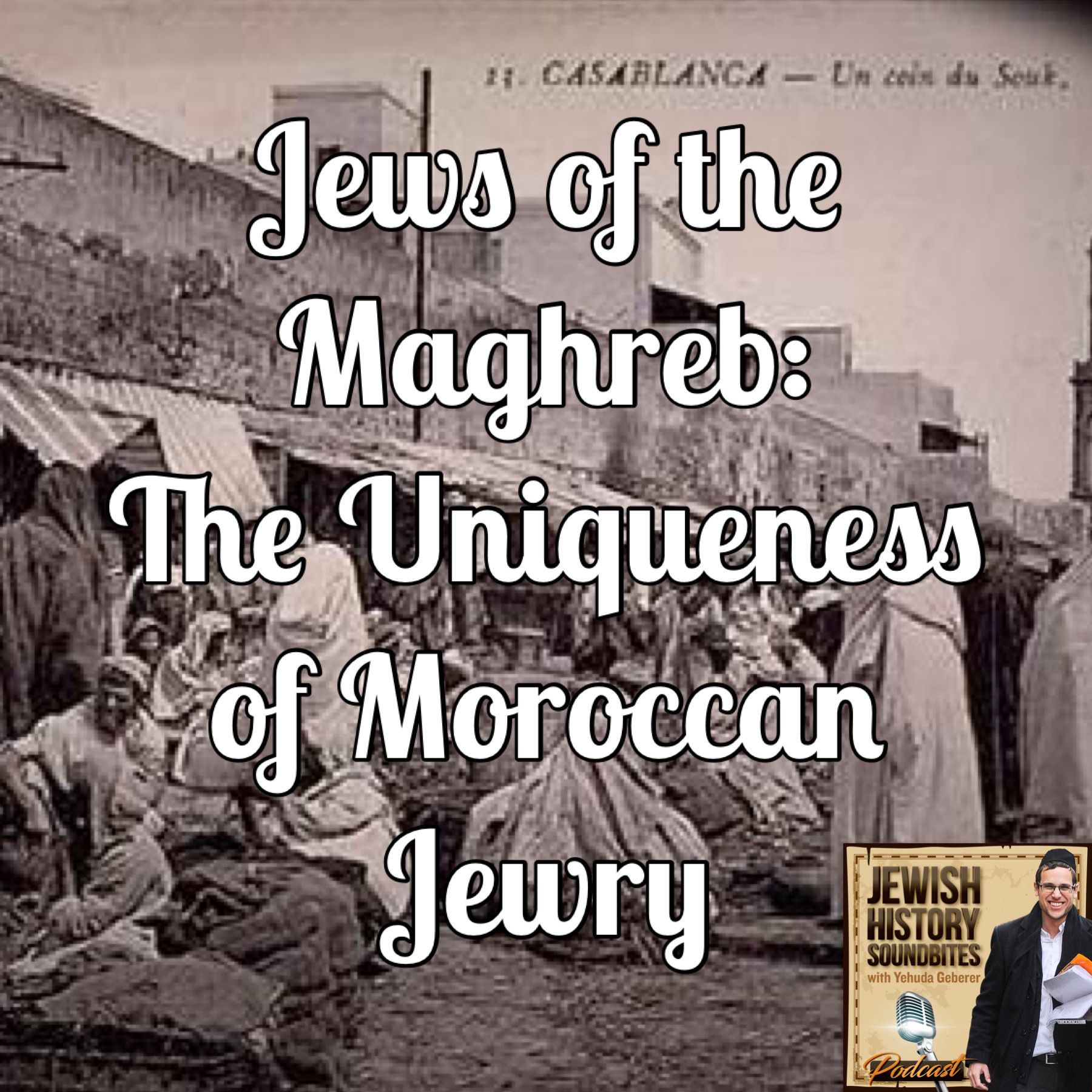 Jewish History SoundbitesJews of the Maghreb: The Uniqueness of Moroccan JewryThere is a certain uniqueness to the storied and ancient Jewish community of Morocco. At least 2,000 years old, it became the numerically largest Sephardic community in the world by the mid 20th century. On the other hand, for several centuries the community and many of its Torah leaders were relatively unknown beyond the confines of Moroccan Jewry.
This was primarily due to its relative isolation. Nestled on the western edge of the African continent, it remained distant from both Europe as well as the vast Ottoman Empire. This isolation assisted in preserving and enriching the heritage and culture unique to M...2021-05-2825 min
Jewish History SoundbitesJews of the Maghreb: The Uniqueness of Moroccan JewryThere is a certain uniqueness to the storied and ancient Jewish community of Morocco. At least 2,000 years old, it became the numerically largest Sephardic community in the world by the mid 20th century. On the other hand, for several centuries the community and many of its Torah leaders were relatively unknown beyond the confines of Moroccan Jewry.
This was primarily due to its relative isolation. Nestled on the western edge of the African continent, it remained distant from both Europe as well as the vast Ottoman Empire. This isolation assisted in preserving and enriching the heritage and culture unique to M...2021-05-2825 min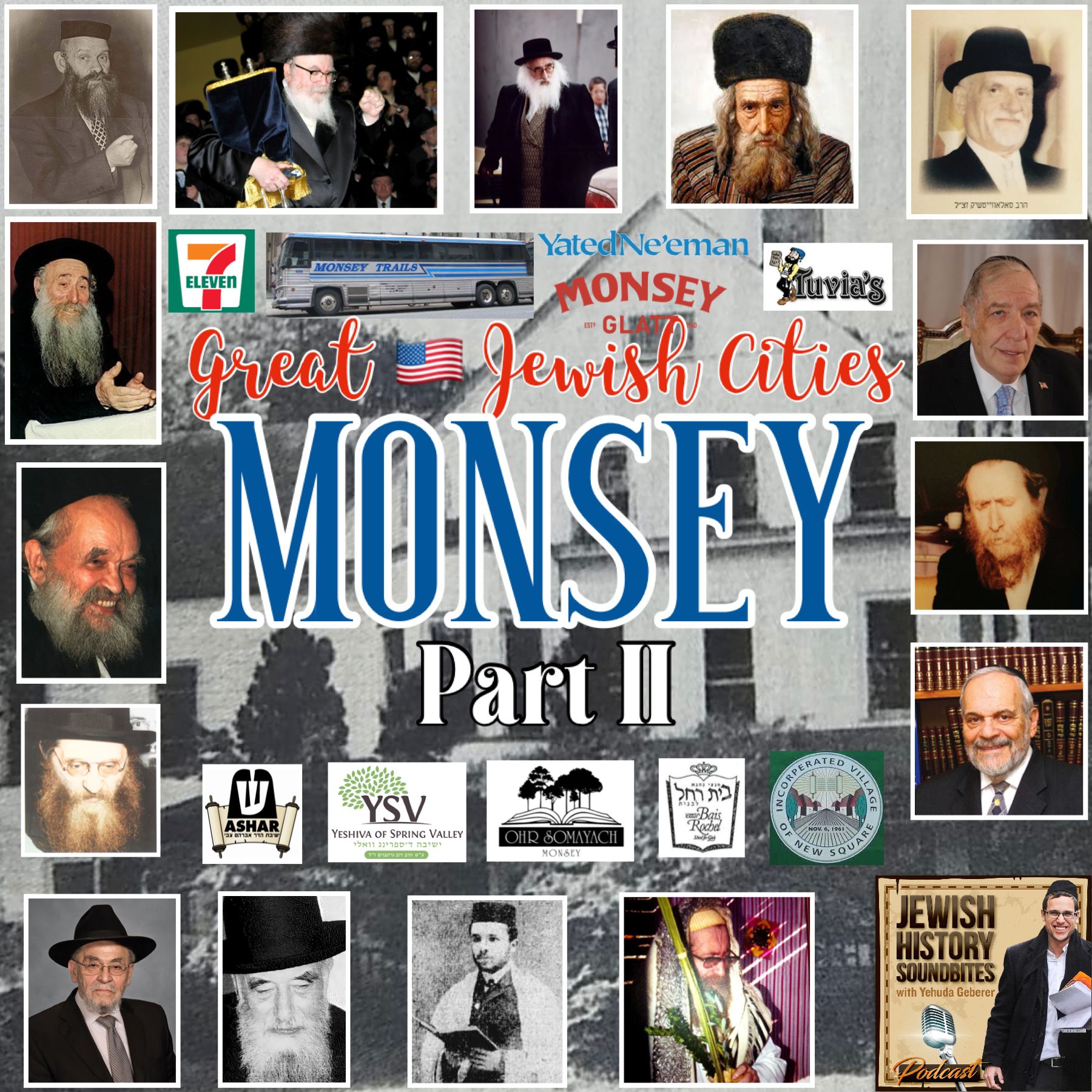 Jewish History SoundbitesGreat American Jewish Cities #21: Monsey Part IIFrom the early days of Bais Medrash Elyon and its prominent alumni, Monsey continued to develop both up and down "the hill". Rav Yaakov Lipschutz, Rav Chaim Flohr and others were prominent rabbis, as Rav Yaakov Kamenetsky still had a large impact on the town overall. Diverse schools opened up from ASHAR to Bais Dovid for boys and Bais Yaakov to Bais Rochel for girls.
Soon Satmar arrived on the scene and first joining the Chareidim Shul, they then opened up an entire empire of their own institutions. Even Neturei Karta US headquarters were in Monsey led by...2021-05-2444 min
Jewish History SoundbitesGreat American Jewish Cities #21: Monsey Part IIFrom the early days of Bais Medrash Elyon and its prominent alumni, Monsey continued to develop both up and down "the hill". Rav Yaakov Lipschutz, Rav Chaim Flohr and others were prominent rabbis, as Rav Yaakov Kamenetsky still had a large impact on the town overall. Diverse schools opened up from ASHAR to Bais Dovid for boys and Bais Yaakov to Bais Rochel for girls.
Soon Satmar arrived on the scene and first joining the Chareidim Shul, they then opened up an entire empire of their own institutions. Even Neturei Karta US headquarters were in Monsey led by...2021-05-2444 min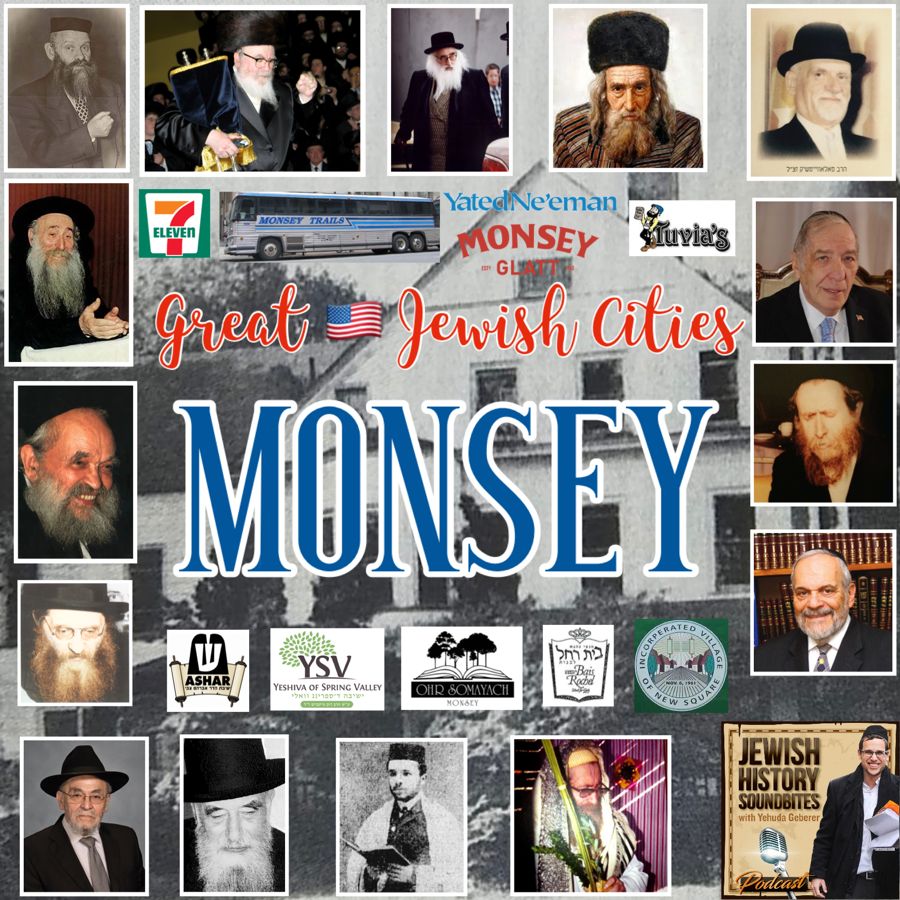 Jewish History SoundbitesGreat American Jewish Cities #21: Monsey Part IMonsey. Rockland County. The Hudson River Valley. The image of suburbia. This small town across the Tappan Zee Bridge somehow developed into one of the largest Jewish Orthodox enclaves worldwide.
Though the area had some minor Jewish beginnings from the end of the 19th century, it was with the vision of Rav Shraga Feivel Mendlowitz that Monsey began to develop as a Jewish community. Rav Shraga Feivel built Bais Medrash Elyon and his family and students laid the foundations of many Torah institutions including Yeshiva of Spring Valley and Bais Shraga. Rabbi Yosef Dov Soloveitchik was an early r...2021-05-1844 min
Jewish History SoundbitesGreat American Jewish Cities #21: Monsey Part IMonsey. Rockland County. The Hudson River Valley. The image of suburbia. This small town across the Tappan Zee Bridge somehow developed into one of the largest Jewish Orthodox enclaves worldwide.
Though the area had some minor Jewish beginnings from the end of the 19th century, it was with the vision of Rav Shraga Feivel Mendlowitz that Monsey began to develop as a Jewish community. Rav Shraga Feivel built Bais Medrash Elyon and his family and students laid the foundations of many Torah institutions including Yeshiva of Spring Valley and Bais Shraga. Rabbi Yosef Dov Soloveitchik was an early r...2021-05-1844 min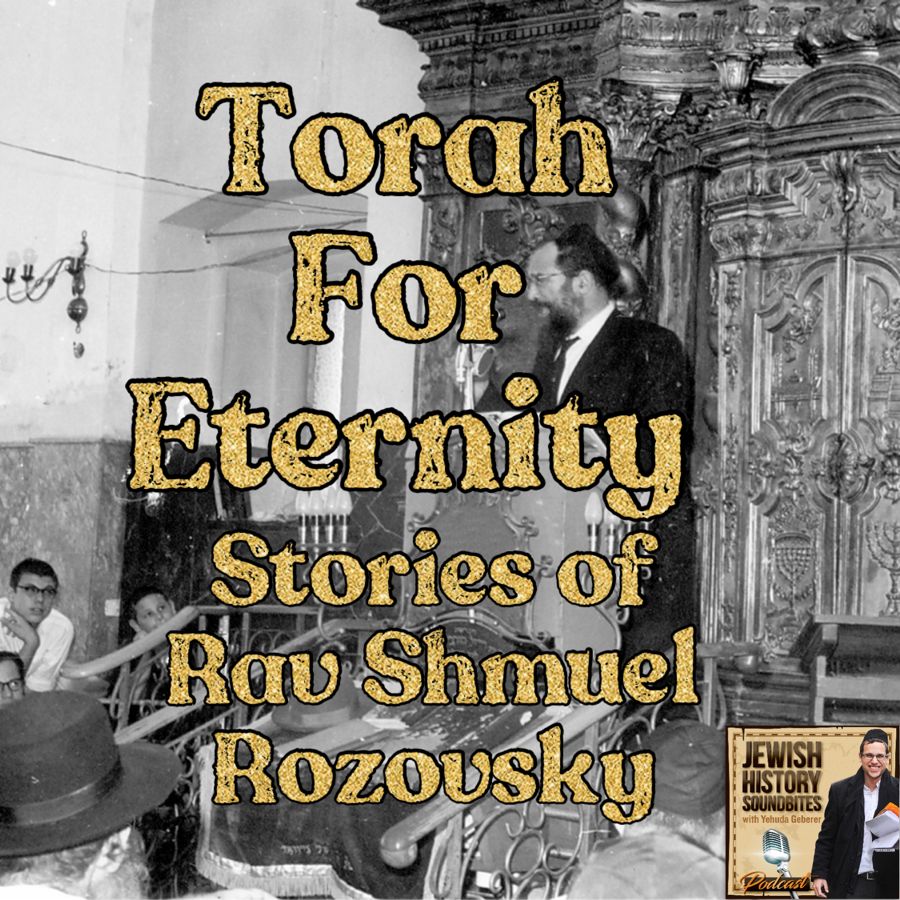 Jewish History SoundbitesTorah for Eternity: Stories of Rav Shmuel RozovskyRav Shmuel Rozovsky (1913-1979) was perhaps the most influential teacher of Torah in the rebuilding of the post war Yeshiva world. Born into a rabbinic family in Grodno, he eventually moved to Palestine to escape the Polish army draft. There he joined the Lomza Yeshiva in Petach Tikva, later becoming the first rosh yeshiva in Ponovezh in Bnei Brak.
When he was diagnosed with cancer, he sought out treatment in the United States, spending several months in Boston. Through the many challenges he faced in life, he continued to see his primary focus as a teacher of Torah.
Fo...2021-05-1633 min
Jewish History SoundbitesTorah for Eternity: Stories of Rav Shmuel RozovskyRav Shmuel Rozovsky (1913-1979) was perhaps the most influential teacher of Torah in the rebuilding of the post war Yeshiva world. Born into a rabbinic family in Grodno, he eventually moved to Palestine to escape the Polish army draft. There he joined the Lomza Yeshiva in Petach Tikva, later becoming the first rosh yeshiva in Ponovezh in Bnei Brak.
When he was diagnosed with cancer, he sought out treatment in the United States, spending several months in Boston. Through the many challenges he faced in life, he continued to see his primary focus as a teacher of Torah.
Fo...2021-05-1633 min Jewish History SoundbitesThe Kabbalists of Komarno: Part IIIn keeping with the mystical leanings of the Komarno dynasty, it is interesting to note the frequency in which the leaders of the dynasty passed away during the time of Sefiras Haomer, a fact which has mystical significance as well.
Their involvement in Kabbalistic practice made the Zhiditchov-Komarno courts a prime target of Yosef Perl and other Galicia maskilim in the 19th century. Undeterred, the Komarno Rebbes continued to teach what they saw as the authentic mysticism of the Baal Shem Tov, refusing to adapt to the downplay of mysticism becoming so common throughout the chassidic movement of...2021-05-1331 min
Jewish History SoundbitesThe Kabbalists of Komarno: Part IIIn keeping with the mystical leanings of the Komarno dynasty, it is interesting to note the frequency in which the leaders of the dynasty passed away during the time of Sefiras Haomer, a fact which has mystical significance as well.
Their involvement in Kabbalistic practice made the Zhiditchov-Komarno courts a prime target of Yosef Perl and other Galicia maskilim in the 19th century. Undeterred, the Komarno Rebbes continued to teach what they saw as the authentic mysticism of the Baal Shem Tov, refusing to adapt to the downplay of mysticism becoming so common throughout the chassidic movement of...2021-05-1331 min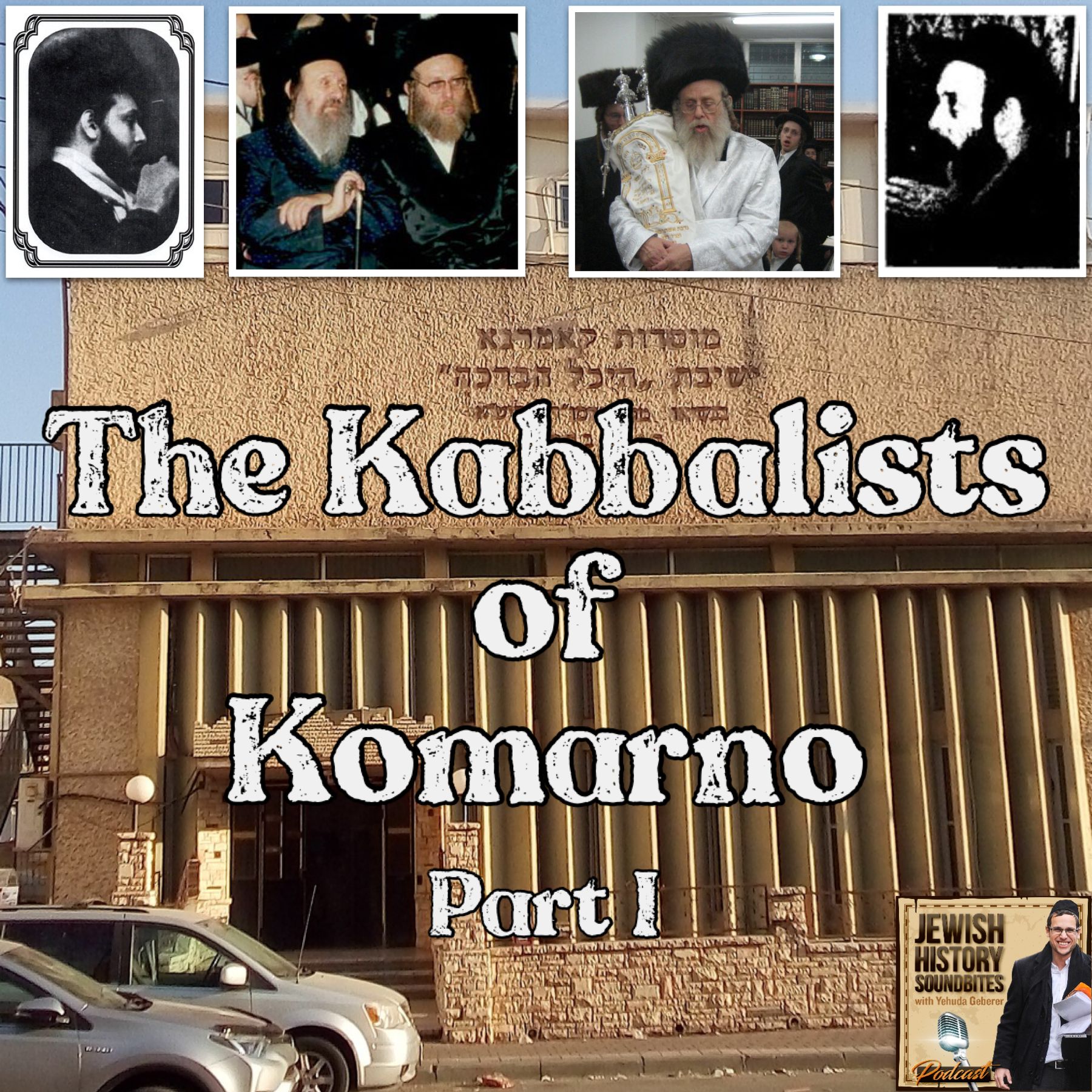 Jewish History SoundbitesThe Kabbalists of Komarno: The Komarno Dynasty Part IOne of the most unusual dynasties in the annals of the Chassidic movement is the Komarno dynasty. Closely related to the Zhiditchov dynasty, it carved out its own niche in Galicia and beyond, with its emphasis on the study of Kabbalah and deep mysticism. The primary personality of the movement was Rav Yitzchak Eizek Safrin of Komarno (1806-1874), who was a prolific writer. Among his works are the acclaimed Heichal Habracha and the Shulchan Hatohar. He was in turn succeeded by his son Rav Eliezer Tzvi Safrin (1830-1898), known by his famous work the Damesek Eliezer.
Though much o...2021-05-1129 min
Jewish History SoundbitesThe Kabbalists of Komarno: The Komarno Dynasty Part IOne of the most unusual dynasties in the annals of the Chassidic movement is the Komarno dynasty. Closely related to the Zhiditchov dynasty, it carved out its own niche in Galicia and beyond, with its emphasis on the study of Kabbalah and deep mysticism. The primary personality of the movement was Rav Yitzchak Eizek Safrin of Komarno (1806-1874), who was a prolific writer. Among his works are the acclaimed Heichal Habracha and the Shulchan Hatohar. He was in turn succeeded by his son Rav Eliezer Tzvi Safrin (1830-1898), known by his famous work the Damesek Eliezer.
Though much o...2021-05-1129 min Jewish History SoundbitesStories Of Ner Israel Part IIIAnother installment of stories of the Ner Israel Yeshiva in Baltimore throughout its history. Led by its legendary Rosh Yeshiva Rav Yaakov Yitzchak Ruderman, the Yeshiva grew and was to have a lasting impact on the American Torah landscape.
Listen to the two previous installments on the history of Yeshivas Ner Israel here:
https://jsoundbites.podbean.com/e/stories-of-ner-israel-part-i/
https://jsoundbites.podbean.com/e/stories-of-ner-israel-part-ii/
For sponsorship opportunities about your favorite topics of Jewish history contact Yehuda at: yehuda@yehudageberer.com
Subscribe To Our Podcast on:
PodBean: htt...2021-05-0528 min
Jewish History SoundbitesStories Of Ner Israel Part IIIAnother installment of stories of the Ner Israel Yeshiva in Baltimore throughout its history. Led by its legendary Rosh Yeshiva Rav Yaakov Yitzchak Ruderman, the Yeshiva grew and was to have a lasting impact on the American Torah landscape.
Listen to the two previous installments on the history of Yeshivas Ner Israel here:
https://jsoundbites.podbean.com/e/stories-of-ner-israel-part-i/
https://jsoundbites.podbean.com/e/stories-of-ner-israel-part-ii/
For sponsorship opportunities about your favorite topics of Jewish history contact Yehuda at: yehuda@yehudageberer.com
Subscribe To Our Podcast on:
PodBean: htt...2021-05-0528 min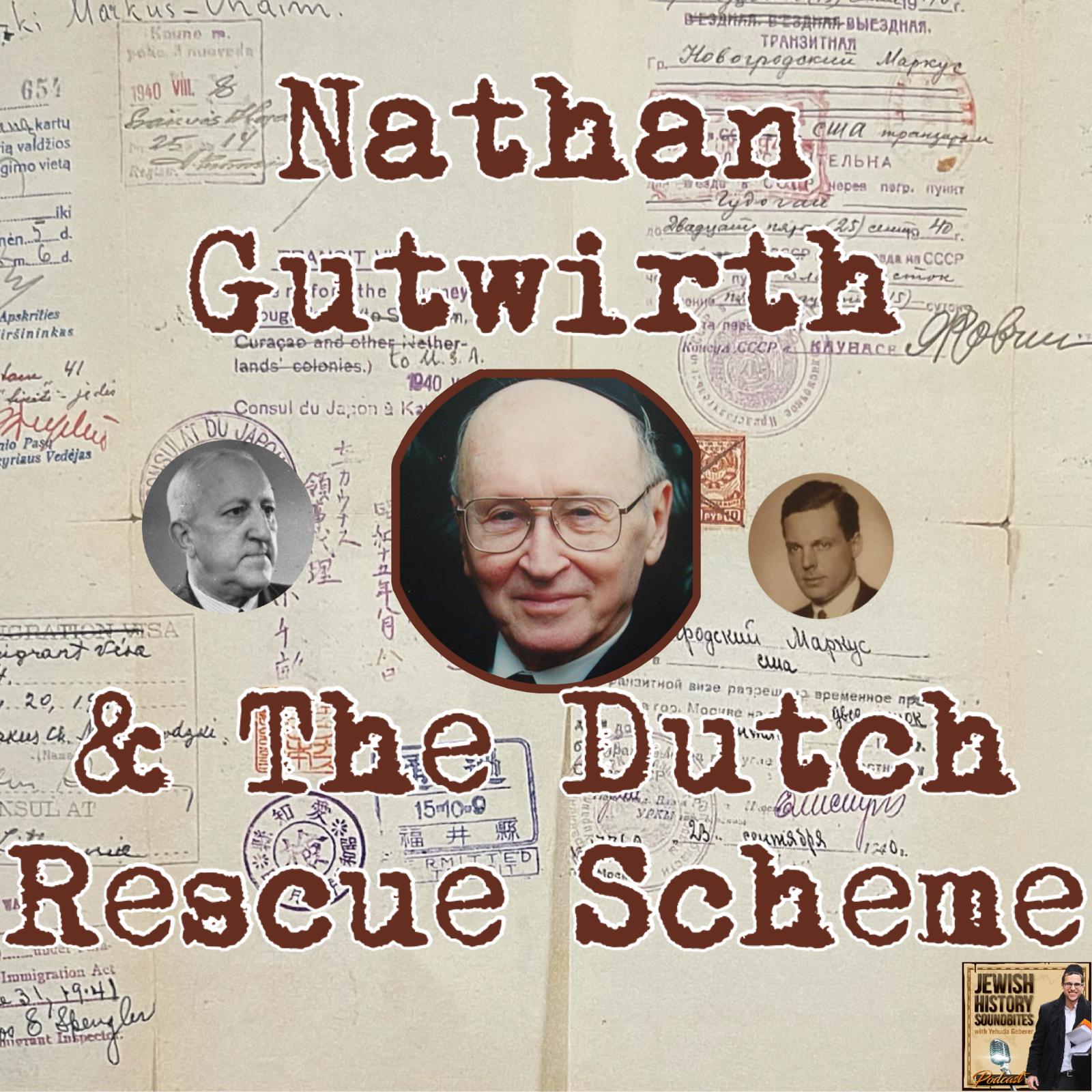 Jewish History SoundbitesNathan Gutwirth & the Dutch Rescue SchemeNathan Gutwirth was a Dutch yeshiva student at the Telz Yeshiva in Lithuania when he was thrust onto the stage of history. He was someone at the right place, at the right time, who did the right thing. When the Second World War broke out, he sought a way for he and his fiancée to escape to one of the Dutch overseas possessions and away from the developing inferno.
Corresponding with the local Dutch consul Jan Zwartendijk and the Dutch ambassador in Riga LPJ De Decker, the island of Curacao became a possible destination. Ultimately, this would se...2021-04-3029 min
Jewish History SoundbitesNathan Gutwirth & the Dutch Rescue SchemeNathan Gutwirth was a Dutch yeshiva student at the Telz Yeshiva in Lithuania when he was thrust onto the stage of history. He was someone at the right place, at the right time, who did the right thing. When the Second World War broke out, he sought a way for he and his fiancée to escape to one of the Dutch overseas possessions and away from the developing inferno.
Corresponding with the local Dutch consul Jan Zwartendijk and the Dutch ambassador in Riga LPJ De Decker, the island of Curacao became a possible destination. Ultimately, this would se...2021-04-3029 min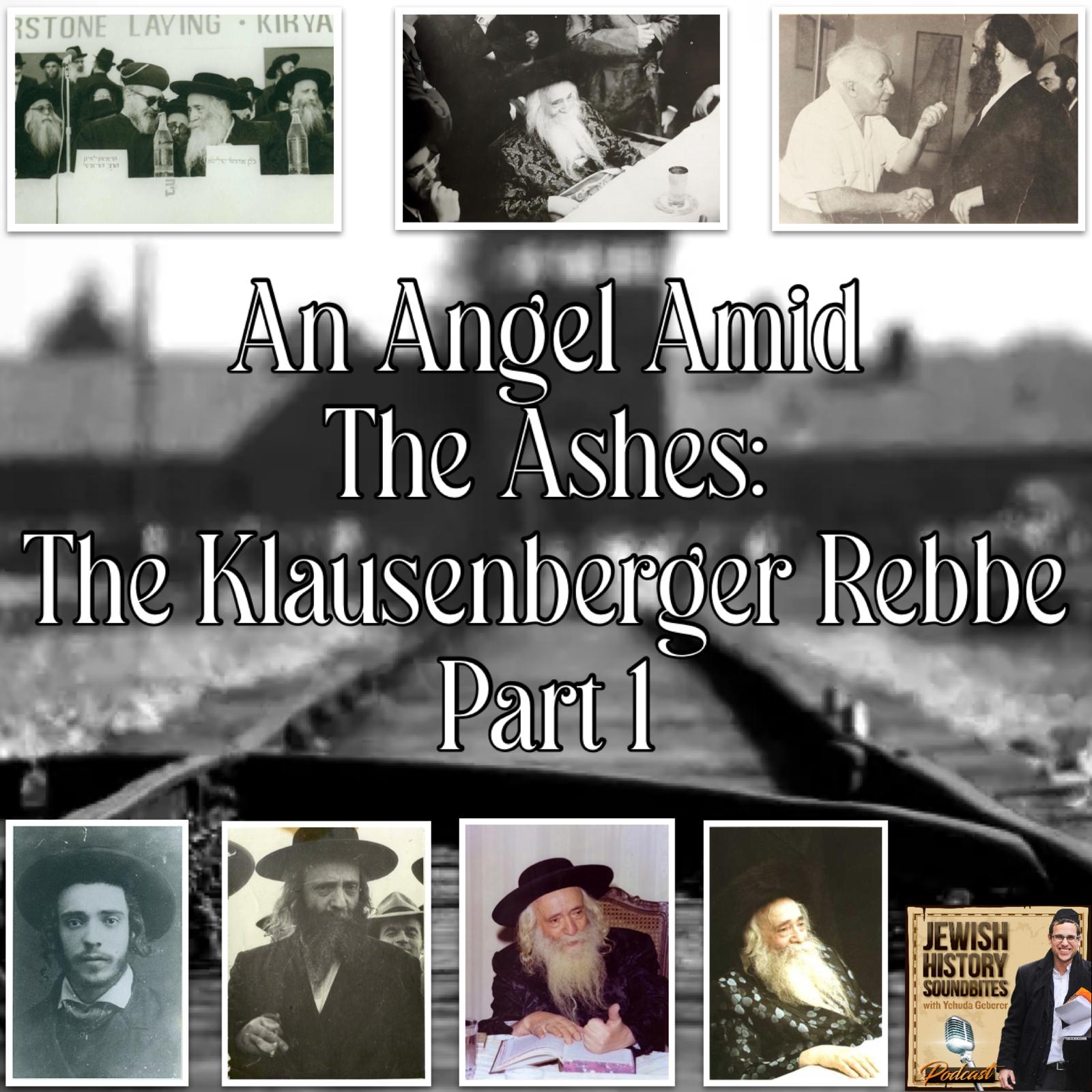 Jewish History SoundbitesAn Angel Amid the Ashes: The Klausenberger Rebbe Part IRav Yekusiel Yehuda Halberstam (1905-1994), known as the Sanz-Klausenberger Rebbe was a scion of the Sanz dynasty & rabbi in prewar Klausenburg (Kluj), but achieved renown for his heroic experiences during the horrors of the Holocaust and rebuilding efforts in its aftermath.
After losing his wife and all his children, he survived Auschwitz, a labor camp in Warsaw, Dachau and Mühldorf, all the while refraining from consuming non-kosher food. Following liberation, he threw himself into rebuilding Jewish life in the Displaced Persons camps of Feldafing and Foehrenwald.
Upon immigrating to the United States he remarried and attempted to carry out his...2021-04-2741 min
Jewish History SoundbitesAn Angel Amid the Ashes: The Klausenberger Rebbe Part IRav Yekusiel Yehuda Halberstam (1905-1994), known as the Sanz-Klausenberger Rebbe was a scion of the Sanz dynasty & rabbi in prewar Klausenburg (Kluj), but achieved renown for his heroic experiences during the horrors of the Holocaust and rebuilding efforts in its aftermath.
After losing his wife and all his children, he survived Auschwitz, a labor camp in Warsaw, Dachau and Mühldorf, all the while refraining from consuming non-kosher food. Following liberation, he threw himself into rebuilding Jewish life in the Displaced Persons camps of Feldafing and Foehrenwald.
Upon immigrating to the United States he remarried and attempted to carry out his...2021-04-2741 min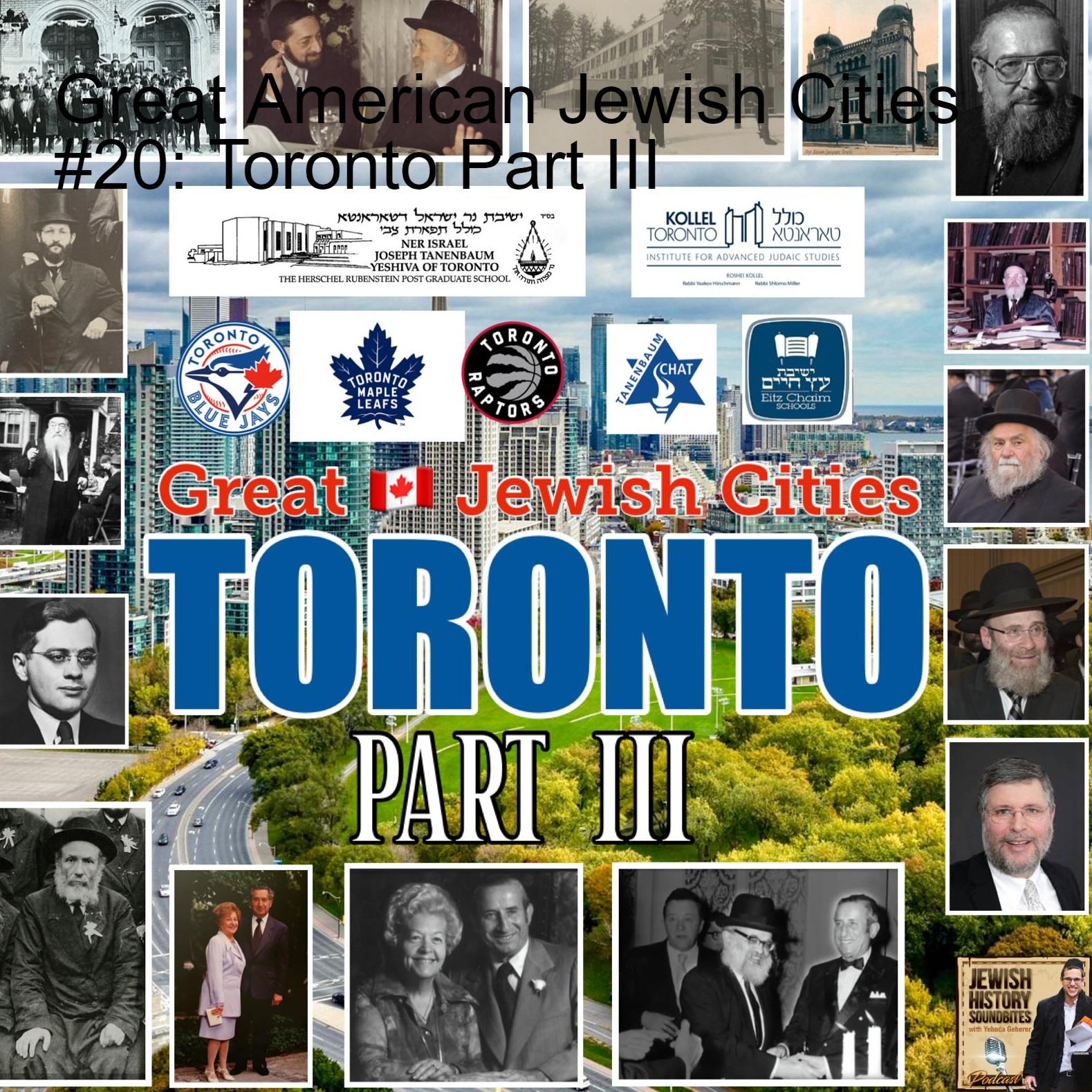 Jewish History SoundbitesGreat American Jewish Cities #20: Toronto Part III
The founding of the Toronto Kollel in 1970 was a turning point in the development of the Toronto Jewish community, and was just one of the many institutions built and supported by the Reichmann family. A Bais Yaakov for girls opened as well, which was headed by Rabbi Akiva Stefansky.
Postwar Toronto contained a large contingent of Holocaust survivors, and one of the close knit communities was the Clanton Park community, headed by Rabbi Nachum Rabinovitch and later Rabbi Yitzchak Kerzner.
Going back to prewar Jewish culture, Yiddish culture and education flourished, and Jewish politics covered the full gamut from socialists t...2021-04-2237 min
Jewish History SoundbitesGreat American Jewish Cities #20: Toronto Part III
The founding of the Toronto Kollel in 1970 was a turning point in the development of the Toronto Jewish community, and was just one of the many institutions built and supported by the Reichmann family. A Bais Yaakov for girls opened as well, which was headed by Rabbi Akiva Stefansky.
Postwar Toronto contained a large contingent of Holocaust survivors, and one of the close knit communities was the Clanton Park community, headed by Rabbi Nachum Rabinovitch and later Rabbi Yitzchak Kerzner.
Going back to prewar Jewish culture, Yiddish culture and education flourished, and Jewish politics covered the full gamut from socialists t...2021-04-2237 min Jewish History SoundbitesGreat American Jewish Cities #20: Toronto Part IIJewish Toronto in the post war saw a development of the community in its leadership and institutions. Rav Dovid Ochs replaced Rav Yaakov Kamenetsky at the helm of the Toras Emes community, and Chabad began to have a presence in town as well. A rising rabbinic leader at this time was Rav Gedalya Felder, while at the same time there started to arrive a large influx of Holocaust survivors, with Rav Meir Grunwald, the Teitcher Rov as a leader in the community as well.
The Holy Blossom Synagogue started off as Orthodox and gradually shifted towards Reform in t...2021-04-1929 min
Jewish History SoundbitesGreat American Jewish Cities #20: Toronto Part IIJewish Toronto in the post war saw a development of the community in its leadership and institutions. Rav Dovid Ochs replaced Rav Yaakov Kamenetsky at the helm of the Toras Emes community, and Chabad began to have a presence in town as well. A rising rabbinic leader at this time was Rav Gedalya Felder, while at the same time there started to arrive a large influx of Holocaust survivors, with Rav Meir Grunwald, the Teitcher Rov as a leader in the community as well.
The Holy Blossom Synagogue started off as Orthodox and gradually shifted towards Reform in t...2021-04-1929 min Jewish History SoundbitesGreat American Jewish Cities #20: Toronto Part IJewish immigrants in the late 19th century populated 'The Ward', an immigrant neighborhood in Toronto, Canada, formulating the nucleus of the fast growing Toronto Jewish community. Eventually the Jewish population shifted to Kensington Market.
Rabbinic leadership in the early years was provided by Rav Yosef Weinreb, Rav Yaakov Gordon, and later Rav Yehuda Leib Graubart. The latter headed the Polish faction of the community and clashed with the former two in their efforts to organize the chaotic kashrus situation and in the organization of the Toronto Kehilla. Rav Yaakov Kamenetsky served as a rabbi in Toronto for several years during...2021-04-1835 min
Jewish History SoundbitesGreat American Jewish Cities #20: Toronto Part IJewish immigrants in the late 19th century populated 'The Ward', an immigrant neighborhood in Toronto, Canada, formulating the nucleus of the fast growing Toronto Jewish community. Eventually the Jewish population shifted to Kensington Market.
Rabbinic leadership in the early years was provided by Rav Yosef Weinreb, Rav Yaakov Gordon, and later Rav Yehuda Leib Graubart. The latter headed the Polish faction of the community and clashed with the former two in their efforts to organize the chaotic kashrus situation and in the organization of the Toronto Kehilla. Rav Yaakov Kamenetsky served as a rabbi in Toronto for several years during...2021-04-1835 min Jewish History SoundbitesBuilding the 'Kehilla': The Leadership of Rav Dr. Joseph BreuerRav Dr. Joseph Breuer (1882-1980) was a visionary leader who successfully rebuilt the Kheilla of Frankfurt of Kahal Adas Jeshurun on American shores. Born to his parents Rav Dr. Solomon Breuer and Sophie Hirsch, daughter of Rav Samson Raphael Hirsch, he moved from Hungary to Frankfurt as a child. He later became the Rosh Yeshiva of the Frankfurt Yeshiva. Following Kristallnacht in November 1938, he managed to escape with his family, arriving in the United States in February 1939.
He immediately set out to establish a fully structured kehilla, not limiting his position to congregational rabbi. With a goal of es...2021-04-1349 min
Jewish History SoundbitesBuilding the 'Kehilla': The Leadership of Rav Dr. Joseph BreuerRav Dr. Joseph Breuer (1882-1980) was a visionary leader who successfully rebuilt the Kheilla of Frankfurt of Kahal Adas Jeshurun on American shores. Born to his parents Rav Dr. Solomon Breuer and Sophie Hirsch, daughter of Rav Samson Raphael Hirsch, he moved from Hungary to Frankfurt as a child. He later became the Rosh Yeshiva of the Frankfurt Yeshiva. Following Kristallnacht in November 1938, he managed to escape with his family, arriving in the United States in February 1939.
He immediately set out to establish a fully structured kehilla, not limiting his position to congregational rabbi. With a goal of es...2021-04-1349 min Jewish History SoundbitesGreat American Jewish Cities #19: Worcester & BostonJewish History Soundbites is back to launch season two of our popular series "Great American Jewish Cities"!
We commence with Worcester, Massachusetts which has a prominent Jewish history. Boasting 13 active shuls in the early decades of the 20th century, it also was home to one of the first Lubavitch Yeshivas in the United States. Visionaries such as Rav Zorach Hurwitz and Rav Hershel Fogelman invested in Jewish education at a time when in out of town America it didn't seem possible.
Other notables of Jewish Worcester includes the leader of the counterculture movement Abbie Hoffman, while...2021-04-0841 min
Jewish History SoundbitesGreat American Jewish Cities #19: Worcester & BostonJewish History Soundbites is back to launch season two of our popular series "Great American Jewish Cities"!
We commence with Worcester, Massachusetts which has a prominent Jewish history. Boasting 13 active shuls in the early decades of the 20th century, it also was home to one of the first Lubavitch Yeshivas in the United States. Visionaries such as Rav Zorach Hurwitz and Rav Hershel Fogelman invested in Jewish education at a time when in out of town America it didn't seem possible.
Other notables of Jewish Worcester includes the leader of the counterculture movement Abbie Hoffman, while...2021-04-0841 min Jewish History SoundbitesRav Hakollel: The Tragic Story of Rabbi Jacob Joseph Part IThe Rav Hakolel or Chief Rabbi of New York City, was the title held by Rabbi Jacob Joseph (1841-1902). A student of the Volozhin Yeshiva and later of Rav Yisrael Salanter, he enjoyed a successful rabbinic career in Lithuania which culminated with his appointment to be the Maggid of Vilna. In 1888 he was invited to become the chief rabbi of a federation of synagogues in Manhattan's Lower East Side. Although it wasn't a very successful venture, behind it lies the story of a great rabbinical leader.
For sponsorship opportunities about your favorite topics of Jewish history contact Yehuda at: yehuda@yeh...2021-04-0523 min
Jewish History SoundbitesRav Hakollel: The Tragic Story of Rabbi Jacob Joseph Part IThe Rav Hakolel or Chief Rabbi of New York City, was the title held by Rabbi Jacob Joseph (1841-1902). A student of the Volozhin Yeshiva and later of Rav Yisrael Salanter, he enjoyed a successful rabbinic career in Lithuania which culminated with his appointment to be the Maggid of Vilna. In 1888 he was invited to become the chief rabbi of a federation of synagogues in Manhattan's Lower East Side. Although it wasn't a very successful venture, behind it lies the story of a great rabbinical leader.
For sponsorship opportunities about your favorite topics of Jewish history contact Yehuda at: yehuda@yeh...2021-04-0523 min Jewish History SoundbitesFrom Oberland to Boro Park: The Arugas Habosem & His DescendantsChust, Tzeilem, Pupa, Satmar. All towns associated with Hungarian Jewry. All were towns where one of the most prominent rabbinical families had representatives who served in its rabbinate. Rav Moshe Greenwald (1853-1910), known by his work the 'Arugas Habosem' was the patriarch of the Greenwald family dynasty. As the family made the transition from the world of Oberland/Chasam Sofer to Hungarian Chasidism, they made their mark as rabbis in Chust, Tzeilem, Pupa and as Roshei Yeshiva as well.
This continued through the Holocaust, where several of them narrowly escaped after losing their families and communities. They ultimately were successful in...2021-03-3130 min
Jewish History SoundbitesFrom Oberland to Boro Park: The Arugas Habosem & His DescendantsChust, Tzeilem, Pupa, Satmar. All towns associated with Hungarian Jewry. All were towns where one of the most prominent rabbinical families had representatives who served in its rabbinate. Rav Moshe Greenwald (1853-1910), known by his work the 'Arugas Habosem' was the patriarch of the Greenwald family dynasty. As the family made the transition from the world of Oberland/Chasam Sofer to Hungarian Chasidism, they made their mark as rabbis in Chust, Tzeilem, Pupa and as Roshei Yeshiva as well.
This continued through the Holocaust, where several of them narrowly escaped after losing their families and communities. They ultimately were successful in...2021-03-3130 min Jewish History SoundbitesBack to his Roots: The Novominsker Rebbe & His PredecessorsIn honor of the first yahrtzeit of the late Novominsk Rebbe Rav Yaakov Perlow (1930-2020), we'll explore a bit more about his illustrious and diverse career and leadership. His first stint was in the Skokie Yeshiva was in the 1960's, forging close relationships with his talmidim whom he taught and inspired there. This was followed by more than a decade as Rosh Yeshiva in Yeshivas Rav Samson Raphael Hirsch (Breuer's) in Washington Heights, where he developed a close relationship with Rav Joseph Breuer.
Later in life he was known as a leader in Agudas Yisroel and for Jews worldwide.
His...2021-03-2534 min
Jewish History SoundbitesBack to his Roots: The Novominsker Rebbe & His PredecessorsIn honor of the first yahrtzeit of the late Novominsk Rebbe Rav Yaakov Perlow (1930-2020), we'll explore a bit more about his illustrious and diverse career and leadership. His first stint was in the Skokie Yeshiva was in the 1960's, forging close relationships with his talmidim whom he taught and inspired there. This was followed by more than a decade as Rosh Yeshiva in Yeshivas Rav Samson Raphael Hirsch (Breuer's) in Washington Heights, where he developed a close relationship with Rav Joseph Breuer.
Later in life he was known as a leader in Agudas Yisroel and for Jews worldwide.
His...2021-03-2534 min Jewish History SoundbitesThe History of the Kiruv Movement Part IThe Kiruv movement, or the Baal Teshuva movement, or the movement of Jewish Outreach, is a curious postwar historical phenomenon. In the counter culture environment of the 1960's, many youth began searching for their Jewish identity and roots, and pioneers and eventually institutions began to fill the role of providing them.
The Lubavitcher Rebbe, the Bostoner Rebbe, Reb Shlomo Carlebach, Rabbi Shlomo Freifeld, Rebbetzin Esther Jungreis, Rabbi Pinchos Stolper with NCSY, are just some of the many pioneers in the United States.
In Israel the movement gained more steam following the Yom Kippur War. Rav Reuven Elbaz, Rav S...2021-03-2141 min
Jewish History SoundbitesThe History of the Kiruv Movement Part IThe Kiruv movement, or the Baal Teshuva movement, or the movement of Jewish Outreach, is a curious postwar historical phenomenon. In the counter culture environment of the 1960's, many youth began searching for their Jewish identity and roots, and pioneers and eventually institutions began to fill the role of providing them.
The Lubavitcher Rebbe, the Bostoner Rebbe, Reb Shlomo Carlebach, Rabbi Shlomo Freifeld, Rebbetzin Esther Jungreis, Rabbi Pinchos Stolper with NCSY, are just some of the many pioneers in the United States.
In Israel the movement gained more steam following the Yom Kippur War. Rav Reuven Elbaz, Rav S...2021-03-2141 min Jewish History SoundbitesBritish Royals, Baalei Tosfos & Blood Libels: The Story of London Part IMedieval Jewish London commences with the Norman conquest in 1066 by William the Conqueror. Jews were brought over from France to engage in moneylending. Officially the property of the kings, this gave them privileges and protection, while at the same time put them in a very precarious situation.
The first blood libel in history was at Norwich in 1144. The Ri of Orleans was killed in the London Massacre in 1189, in the events surrounding the coronation of Richard the Lionhearted. On shabbos hagadol, March 16, 1190 the York Massacre took place at Clifford's Tower. As the situation for English Jewry got worse, it finally c...2021-03-1840 min
Jewish History SoundbitesBritish Royals, Baalei Tosfos & Blood Libels: The Story of London Part IMedieval Jewish London commences with the Norman conquest in 1066 by William the Conqueror. Jews were brought over from France to engage in moneylending. Officially the property of the kings, this gave them privileges and protection, while at the same time put them in a very precarious situation.
The first blood libel in history was at Norwich in 1144. The Ri of Orleans was killed in the London Massacre in 1189, in the events surrounding the coronation of Richard the Lionhearted. On shabbos hagadol, March 16, 1190 the York Massacre took place at Clifford's Tower. As the situation for English Jewry got worse, it finally c...2021-03-1840 min Jewish History SoundbitesBranching out of Sanz: The Shinive & Gorlice DynastiesAmong the many branches which emerged from the children of the Divrei Chaim of Sanz, Shinive & Gorlice were important and influential dynasties. Rav Yechezkal Halberstam of Shinive (1815-1898) was the oldest of the Divrei Chaim's children. He emerged as a brilliant and popular leader in his own right, as he charted an independent path from his father. On a famous visit to the Land of Israel in 1869, he established the Sanz shul in Tzfas. One of his sons founded the Stropkov chassidic dynasty.
The youngest son of the Divrei Chaim's first marriage, Rav Boruch Halberstam of Gorlice (1829-1906) was his f...2021-03-1430 min
Jewish History SoundbitesBranching out of Sanz: The Shinive & Gorlice DynastiesAmong the many branches which emerged from the children of the Divrei Chaim of Sanz, Shinive & Gorlice were important and influential dynasties. Rav Yechezkal Halberstam of Shinive (1815-1898) was the oldest of the Divrei Chaim's children. He emerged as a brilliant and popular leader in his own right, as he charted an independent path from his father. On a famous visit to the Land of Israel in 1869, he established the Sanz shul in Tzfas. One of his sons founded the Stropkov chassidic dynasty.
The youngest son of the Divrei Chaim's first marriage, Rav Boruch Halberstam of Gorlice (1829-1906) was his f...2021-03-1430 min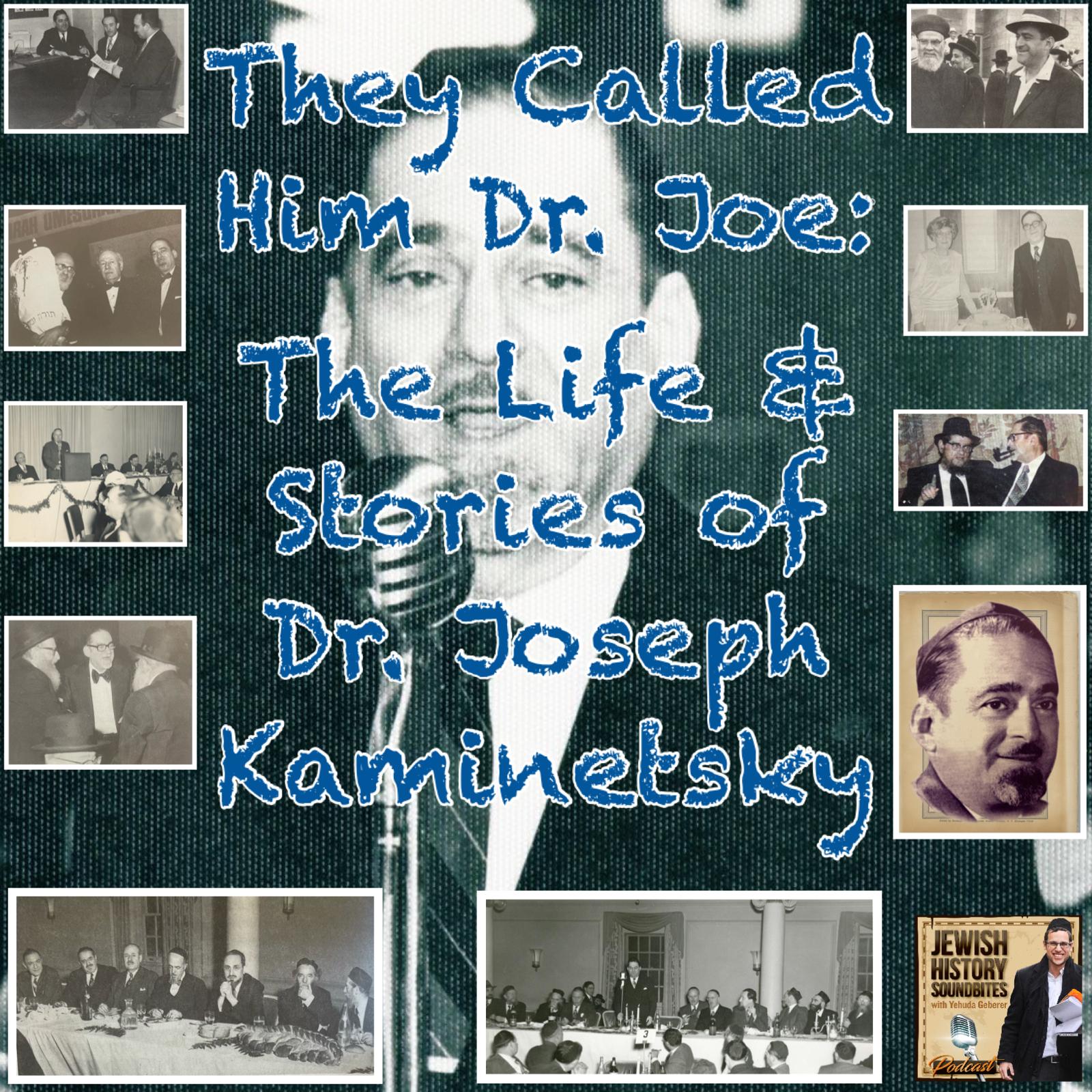 Jewish History SoundbitesThey Called him Dr. Joe: The Life & Stories of Dr. Joseph Kaminetsky Part IDr. Joe Kaminetsky (1911-1999) was one of the greatest architects of Jewish education in the post war era. His role in the leadership of Torah Umesorah spearheaded the Day School Movement. Born in Brooklyn into a home where his parents sold their house to ensure a Jewish education for their children, he later attended the first class of Yeshiva College in 1928. There he had a close relationship with Rabbi Leo Jung, the visiting Slabodka Rosh Yeshiva Rav Isaac Sher, and later on with Rav Soloveitchik.
Together with Rav Shraga Feivel Mendlowitz who was the founder of Torah Umesorah...2021-03-1029 min
Jewish History SoundbitesThey Called him Dr. Joe: The Life & Stories of Dr. Joseph Kaminetsky Part IDr. Joe Kaminetsky (1911-1999) was one of the greatest architects of Jewish education in the post war era. His role in the leadership of Torah Umesorah spearheaded the Day School Movement. Born in Brooklyn into a home where his parents sold their house to ensure a Jewish education for their children, he later attended the first class of Yeshiva College in 1928. There he had a close relationship with Rabbi Leo Jung, the visiting Slabodka Rosh Yeshiva Rav Isaac Sher, and later on with Rav Soloveitchik.
Together with Rav Shraga Feivel Mendlowitz who was the founder of Torah Umesorah...2021-03-1029 min Jewish History SoundbitesBekeshas, Boots & Blue Shirts: Jewish Dress in Modern TimesWhat is distinctive Jewish dress? Is it distinctive? How is Jewish traditional fashion influenced by the surrounding society? When did chassidic dress develop? Why does Chassidic and traditional Jewish fashion still follow modes of Eastern European Jewish fashion?
What makes the rabbinic frock Jewish and why is it for rabbis? Why are there different types of shtreimels? What is a 'tarbush'?
Fashion and accepted clothing styles in traditional Jewish communities was and is a mode of expression of Jewish and distinctive communal identity throughout Jewish history. Through the challenges of modernity, this was brought into much sharper focus in t...2021-03-0739 min
Jewish History SoundbitesBekeshas, Boots & Blue Shirts: Jewish Dress in Modern TimesWhat is distinctive Jewish dress? Is it distinctive? How is Jewish traditional fashion influenced by the surrounding society? When did chassidic dress develop? Why does Chassidic and traditional Jewish fashion still follow modes of Eastern European Jewish fashion?
What makes the rabbinic frock Jewish and why is it for rabbis? Why are there different types of shtreimels? What is a 'tarbush'?
Fashion and accepted clothing styles in traditional Jewish communities was and is a mode of expression of Jewish and distinctive communal identity throughout Jewish history. Through the challenges of modernity, this was brought into much sharper focus in t...2021-03-0739 min Jewish History SoundbitesLeader of His People: The Life of the Dvar AvrahamThe last rabbi of pre war Kovno, Rav Avraham Dovber Kahana-Shapira (1870-1943), was known by the name of the sefer he authored, the Dvar Avraham. Born into the Lithuanian rabbinic elite, and having studied at the Volozhin Yeshiva, he was appointed rabbi of Kovno (Kaunas) in 1913. He remained at his post until his passing in the Kovno Ghetto three decades later.
During this time he was recognized as one of the greatest leaders of Lithuanian Jewry, managing to navigate the various factions of the Kovno Jewish community, execute his rabbinical duties and serve as a worldwide posek fielding...2021-03-0235 min
Jewish History SoundbitesLeader of His People: The Life of the Dvar AvrahamThe last rabbi of pre war Kovno, Rav Avraham Dovber Kahana-Shapira (1870-1943), was known by the name of the sefer he authored, the Dvar Avraham. Born into the Lithuanian rabbinic elite, and having studied at the Volozhin Yeshiva, he was appointed rabbi of Kovno (Kaunas) in 1913. He remained at his post until his passing in the Kovno Ghetto three decades later.
During this time he was recognized as one of the greatest leaders of Lithuanian Jewry, managing to navigate the various factions of the Kovno Jewish community, execute his rabbinical duties and serve as a worldwide posek fielding...2021-03-0235 min Jewish History SoundbitesMyths & More: Deciphering the HaskalahThe Haskala movement, was a Jewish movement of the 18th and 19th centuries which sought to implement changes in Jewish life and society. Often discussed yet just as often misunderstood, it is intriguing as it is confusing.
Was the haskala the Jewish Enlightenment? When was this movement? Where did it take place? Can it even be classified as a 'movement'? How so? Who were its primary personalities? How did they impact Jewish life? Is the rise of Jewish nationalism at the end of the 19th century related to haskala movement of the earlier decades? When did the haskala end?
If there...2021-02-2437 min
Jewish History SoundbitesMyths & More: Deciphering the HaskalahThe Haskala movement, was a Jewish movement of the 18th and 19th centuries which sought to implement changes in Jewish life and society. Often discussed yet just as often misunderstood, it is intriguing as it is confusing.
Was the haskala the Jewish Enlightenment? When was this movement? Where did it take place? Can it even be classified as a 'movement'? How so? Who were its primary personalities? How did they impact Jewish life? Is the rise of Jewish nationalism at the end of the 19th century related to haskala movement of the earlier decades? When did the haskala end?
If there...2021-02-2437 min Jewish History SoundbitesTalking Jewish History with Moish Francesa: Purim Episode 2021Jewish History Soundbites is proud to present a special Purim episode, for some good Jewish History enjoyment and fun.
Honored to host a special guest, one of the most influential and historic figures of contemporary Jewish entertainment -- Moish Francesa.
Enjoy and a Happy Purim to all!
For sponsorship opportunities about your favorite topics of Jewish history contact Yehuda at: yehuda@yehudageberer.com
Subscribe To Our Podcast on:
PodBean: https://jsoundbites.podbean.com/
Follow us on Twitter or Instagram at @Jsoundbites
You can email Yehuda at yehuda@yehudageberer.com
2021-02-2317 min
Jewish History SoundbitesTalking Jewish History with Moish Francesa: Purim Episode 2021Jewish History Soundbites is proud to present a special Purim episode, for some good Jewish History enjoyment and fun.
Honored to host a special guest, one of the most influential and historic figures of contemporary Jewish entertainment -- Moish Francesa.
Enjoy and a Happy Purim to all!
For sponsorship opportunities about your favorite topics of Jewish history contact Yehuda at: yehuda@yehudageberer.com
Subscribe To Our Podcast on:
PodBean: https://jsoundbites.podbean.com/
Follow us on Twitter or Instagram at @Jsoundbites
You can email Yehuda at yehuda@yehudageberer.com
2021-02-2317 min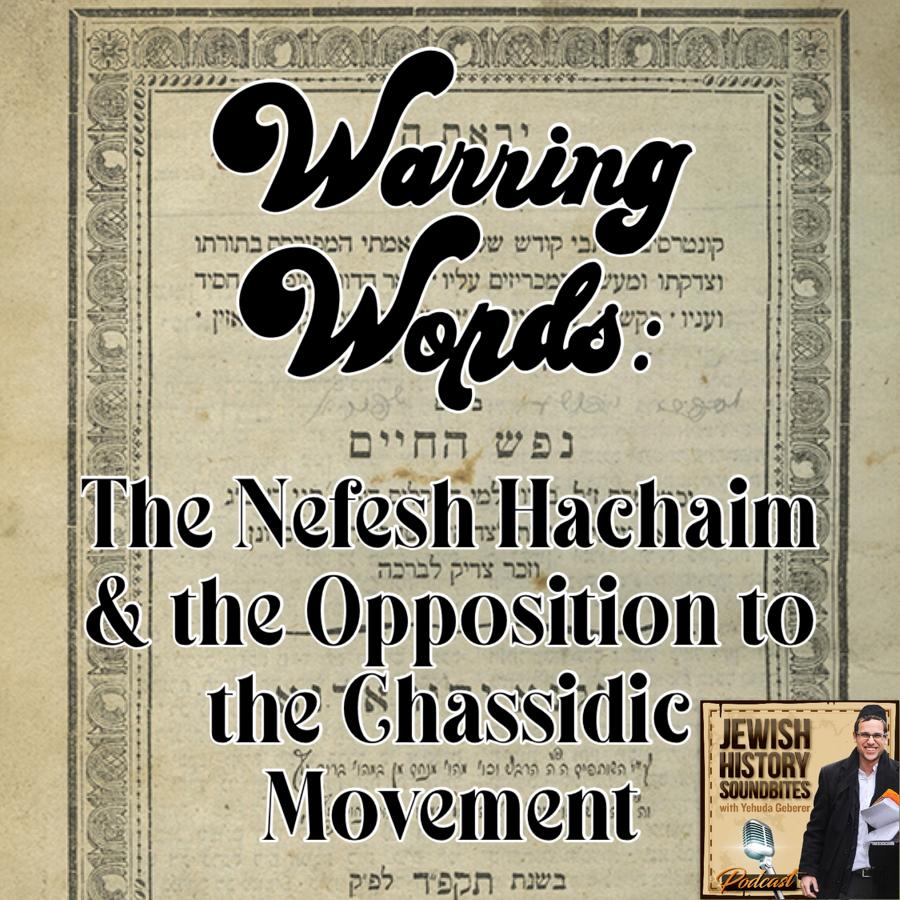 Jewish History SoundbitesWarring Words: The Nefesh Hachaim & the Opposition to the Chassidic MovementThe Sefer Nefesh Hachaim authored by Rav Chaim of Volozhin (1749-1821) was published posthumously by his son Rav Itzele in 1824, with an expanded version including eight additional chapters published in 1837. This was a theological work, as well as a polemical one, with Rav Chaim addressing issues he saw in the chassidic movement which he sought to oppose, correct and establish an alternative value system for his followers.
This signified a shift in the opposition to the Chassidic movement. Whereas Rav Chaim's teacher the Vilna Goan sought to excommunicate the chassidim completely, his student saw them as members of the Jewish com...2021-02-2035 min
Jewish History SoundbitesWarring Words: The Nefesh Hachaim & the Opposition to the Chassidic MovementThe Sefer Nefesh Hachaim authored by Rav Chaim of Volozhin (1749-1821) was published posthumously by his son Rav Itzele in 1824, with an expanded version including eight additional chapters published in 1837. This was a theological work, as well as a polemical one, with Rav Chaim addressing issues he saw in the chassidic movement which he sought to oppose, correct and establish an alternative value system for his followers.
This signified a shift in the opposition to the Chassidic movement. Whereas Rav Chaim's teacher the Vilna Goan sought to excommunicate the chassidim completely, his student saw them as members of the Jewish com...2021-02-2035 min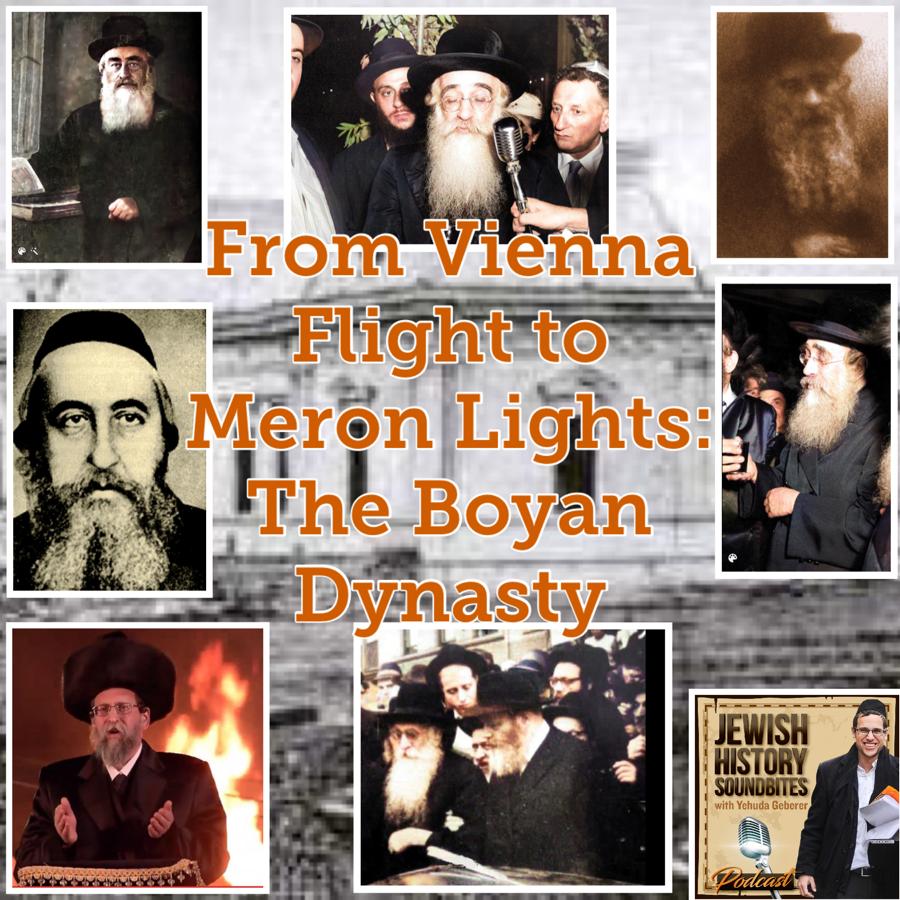 Jewish History SoundbitesFrom Vienna Flight to Meron Lights: The Boyan DynastyWith roots in the regal courts of Ruzhin/Sadagora the Boyan dynasty continued that legacy while also forging some uniquenesses of its own. Founded by Rav Yitzchak Friedman (1849-1917), the Pachad Yitzchak, who fled to Vienna with the outbreak of World War One.
He was succeeded by his four sons: Rav Menachem Nachum of Czernowitz, Rav Yisroel of Leipzig, Rav Avraham Yaakov of Lvov (Lemberg) and Rav Mordechai Shlomo of the Lower East Side (1890-1971). Another prominent Boyan Rebbe at this time was Rav Moshenyu Friedman who became one of the interwar leaders of Polish Jewry, until his...2021-02-1737 min
Jewish History SoundbitesFrom Vienna Flight to Meron Lights: The Boyan DynastyWith roots in the regal courts of Ruzhin/Sadagora the Boyan dynasty continued that legacy while also forging some uniquenesses of its own. Founded by Rav Yitzchak Friedman (1849-1917), the Pachad Yitzchak, who fled to Vienna with the outbreak of World War One.
He was succeeded by his four sons: Rav Menachem Nachum of Czernowitz, Rav Yisroel of Leipzig, Rav Avraham Yaakov of Lvov (Lemberg) and Rav Mordechai Shlomo of the Lower East Side (1890-1971). Another prominent Boyan Rebbe at this time was Rav Moshenyu Friedman who became one of the interwar leaders of Polish Jewry, until his...2021-02-1737 min Jewish History SoundbitesThe Jews of Scandinavia Part IThe more recent and relatively small Jewish communities of Scandinavia serve as an interesting chapter in Jewish history. While Finland was part of the Russian Empire for a time, the other Scandinavian countries had Jewish communities as well.
This episode will primarily focus on Sweden and the central Jewish story based in Stockholm in the 19th and 20th centuries. Though it was initially quite small, the Jewish community ballooned in size in the 1930's and during the war with a stream of refugees from Germany and later from Scandinavian countries under Nazi occupation. Many more survivors subsequently arrived f...2021-02-1336 min
Jewish History SoundbitesThe Jews of Scandinavia Part IThe more recent and relatively small Jewish communities of Scandinavia serve as an interesting chapter in Jewish history. While Finland was part of the Russian Empire for a time, the other Scandinavian countries had Jewish communities as well.
This episode will primarily focus on Sweden and the central Jewish story based in Stockholm in the 19th and 20th centuries. Though it was initially quite small, the Jewish community ballooned in size in the 1930's and during the war with a stream of refugees from Germany and later from Scandinavian countries under Nazi occupation. Many more survivors subsequently arrived f...2021-02-1336 min Jewish History SoundbitesJewish History Soundbites at 250: Reflections on Changes in Modern Jewish HistoryJewish History Soundbites 250th commemorative episode.
At this milestone, it is perhaps appropriate to take a step back and try to piece together an overview of the underlying theme of the episodes and stories of Jewish History Soundbites.
Modern Jewish history is generally defined as 1500-present, with the late modern period being roughly from 1850-present. The uniqueness of this period is the sweeping changes which developed and ultimately enveloped the Jewish people over the last few centuries.
Six of those primary changes are emancipation - the struggle for emancipation and equal rights in the 19th century; immigration...2021-02-0631 min
Jewish History SoundbitesJewish History Soundbites at 250: Reflections on Changes in Modern Jewish HistoryJewish History Soundbites 250th commemorative episode.
At this milestone, it is perhaps appropriate to take a step back and try to piece together an overview of the underlying theme of the episodes and stories of Jewish History Soundbites.
Modern Jewish history is generally defined as 1500-present, with the late modern period being roughly from 1850-present. The uniqueness of this period is the sweeping changes which developed and ultimately enveloped the Jewish people over the last few centuries.
Six of those primary changes are emancipation - the struggle for emancipation and equal rights in the 19th century; immigration...2021-02-0631 min Jewish History SoundbitesSisters of the Revolution Part III: The Pioneers : Separating Fact from FictionFor lectures, episode sponsorships and virtual tours, contact Yehuda at yehuda@yehudageberer.com
The first World War was to bring sweeping change to Jewish life in Eastern Europe, and one of the manifestations of that change was girls' education. With the German occupation came a new civil administration, and attempts at educational reform. Rabbis and educators serving in the German Army or civil authorities were key players in this turn of events. Rabbis Drs. Emmanuel Carlebach and Pinchos Kohn in Warsaw and Dr. Leo Deutschlander in Lithuania both founded the first formal Torah education schools for g...2020-09-3035 min
Jewish History SoundbitesSisters of the Revolution Part III: The Pioneers : Separating Fact from FictionFor lectures, episode sponsorships and virtual tours, contact Yehuda at yehuda@yehudageberer.com
The first World War was to bring sweeping change to Jewish life in Eastern Europe, and one of the manifestations of that change was girls' education. With the German occupation came a new civil administration, and attempts at educational reform. Rabbis and educators serving in the German Army or civil authorities were key players in this turn of events. Rabbis Drs. Emmanuel Carlebach and Pinchos Kohn in Warsaw and Dr. Leo Deutschlander in Lithuania both founded the first formal Torah education schools for g...2020-09-3035 min Jewish History SoundbitesYiddish Socialists and Polish Politics: Why Some Religious Jews Supported The Polish BundYehuda Geberer explores the story of "The Bund", the largest Jewish political party in pre-war Poland. Both anti-Zionist and anti-religious, the Socialist Workers Party used Yiddish language and culture and succeeded in its efforts to harm the Jewish establishment in interwar Poland. Yet, there were some positive aspects to this movement. Listen to Yehuda explain the surprising reasons why some religious Jews supported the Bund.
Subscribe To Our Podcast on:
PodBean: https://jsoundbites.podbean.com/
Follow us on Twitter or Instagram at @Jsoundbites
You can email Yehuda at yehuda@yehudageberer.com
2019-05-1912 min
Jewish History SoundbitesYiddish Socialists and Polish Politics: Why Some Religious Jews Supported The Polish BundYehuda Geberer explores the story of "The Bund", the largest Jewish political party in pre-war Poland. Both anti-Zionist and anti-religious, the Socialist Workers Party used Yiddish language and culture and succeeded in its efforts to harm the Jewish establishment in interwar Poland. Yet, there were some positive aspects to this movement. Listen to Yehuda explain the surprising reasons why some religious Jews supported the Bund.
Subscribe To Our Podcast on:
PodBean: https://jsoundbites.podbean.com/
Follow us on Twitter or Instagram at @Jsoundbites
You can email Yehuda at yehuda@yehudageberer.com
2019-05-1912 min JavaScript Jabber218 JSJ Ember.js with Yehuda KatzCheck out Newbie Remote Conf! 02:38 - Yehuda Katz IntroductionTwitterGitHubBlogTildePeter Solnic: My time with Rails is upPeter Solnic: Abstractions and the role of a framework (Follow-up)Ember.jsThe Skylight Blog: Inside Skylight05:37 - Batching Updates10:04 - NamingFastbootServicesglimmer14:19 - CommunicationSkylight16:21 - Decorators19:46 - “Junior Developer” and Knowledge BiasCodeNewbie Ep. 90: Creating EmberJS - Part I with Yehuda KatzCodeNewbie Ep. 91: Creating EmberJS - Part II with Yehuda Katz28:25 - Termanology in Tech29:23 - DiversityWomen Helping Women PicksEvent Driven: How to Run Memorable Tech Conferences by Leah Silber (Yehuda)TypeScript (Yehuda)emberjs/rfcs (Yehuda)rust-lang/rfcs (Yehuda)Pretty Pull Requests (Aimee)Full-Stack Redux Tutorial by Tero P...2016-06-2928 min
JavaScript Jabber218 JSJ Ember.js with Yehuda KatzCheck out Newbie Remote Conf! 02:38 - Yehuda Katz IntroductionTwitterGitHubBlogTildePeter Solnic: My time with Rails is upPeter Solnic: Abstractions and the role of a framework (Follow-up)Ember.jsThe Skylight Blog: Inside Skylight05:37 - Batching Updates10:04 - NamingFastbootServicesglimmer14:19 - CommunicationSkylight16:21 - Decorators19:46 - “Junior Developer” and Knowledge BiasCodeNewbie Ep. 90: Creating EmberJS - Part I with Yehuda KatzCodeNewbie Ep. 91: Creating EmberJS - Part II with Yehuda Katz28:25 - Termanology in Tech29:23 - DiversityWomen Helping Women PicksEvent Driven: How to Run Memorable Tech Conferences by Leah Silber (Yehuda)TypeScript (Yehuda)emberjs/rfcs (Yehuda)rust-lang/rfcs (Yehuda)Pretty Pull Requests (Aimee)Full-Stack Redux Tutorial by Tero P...2016-06-2928 min